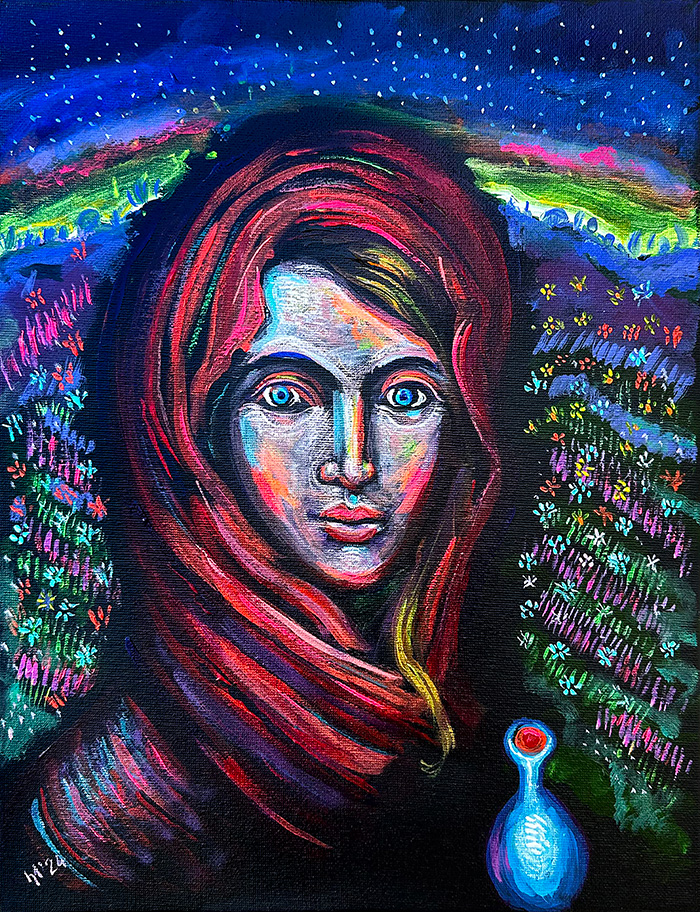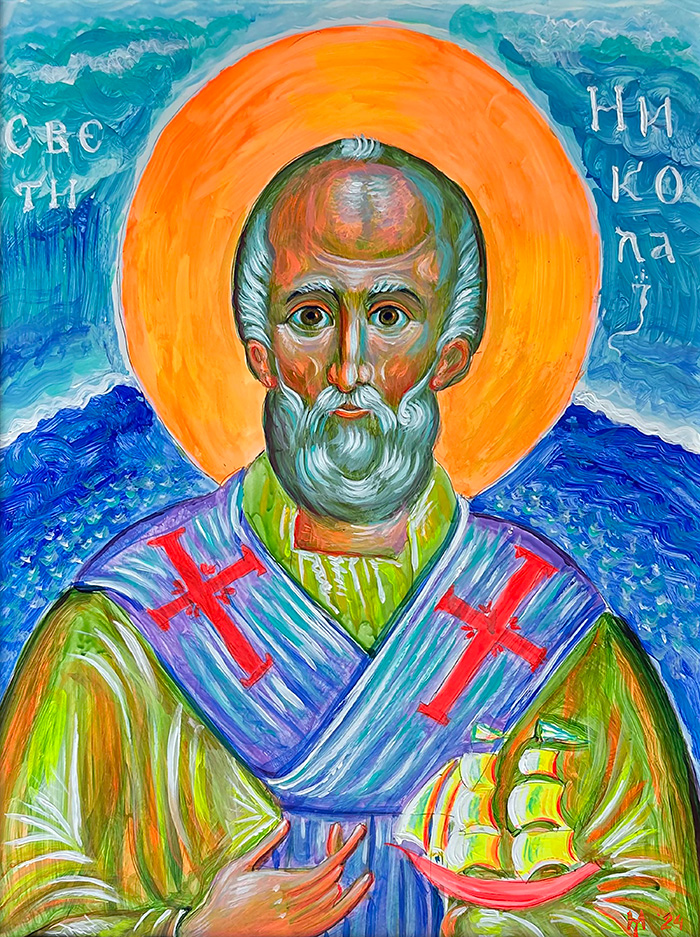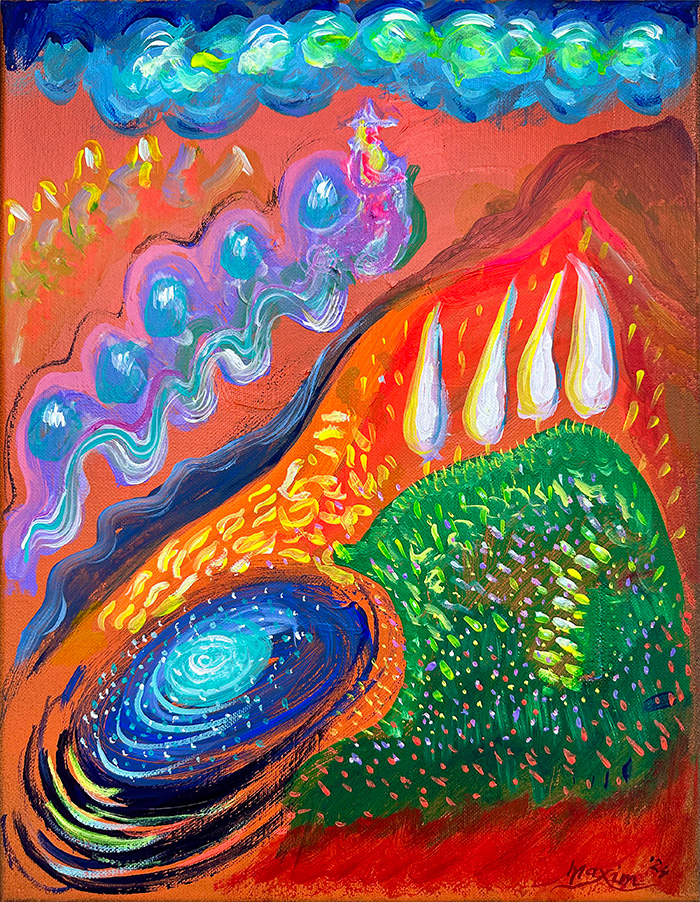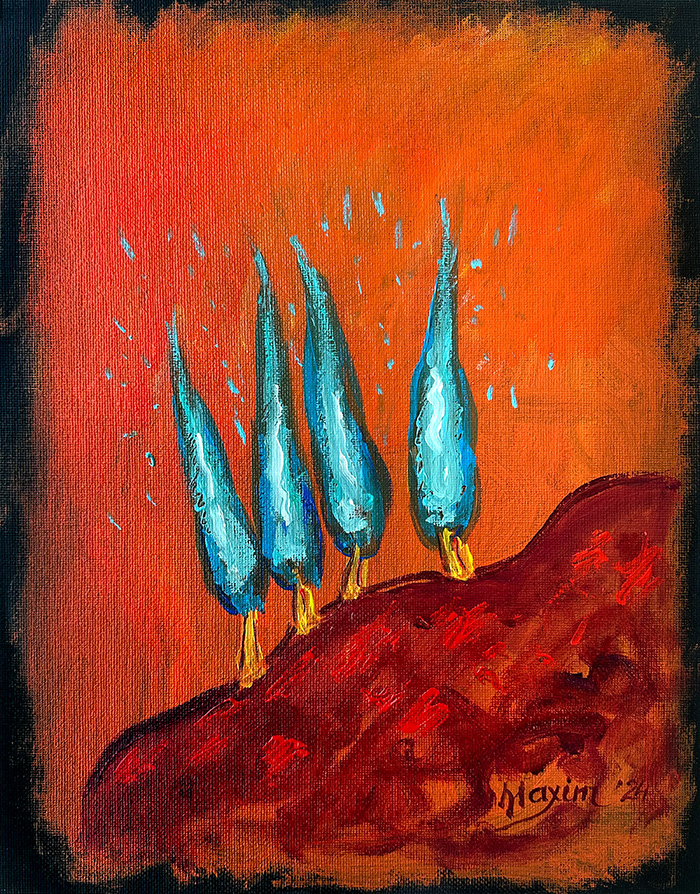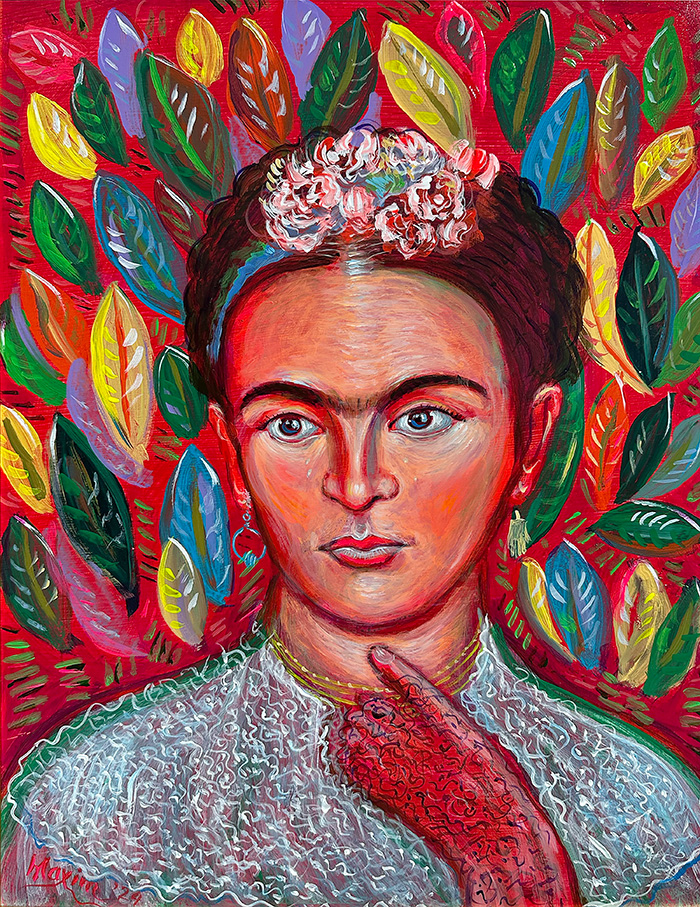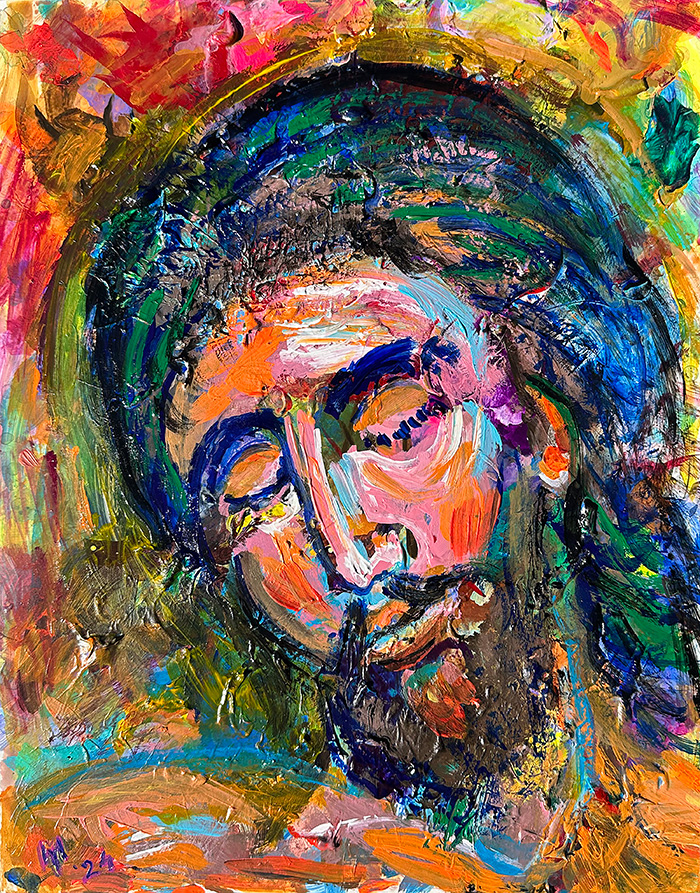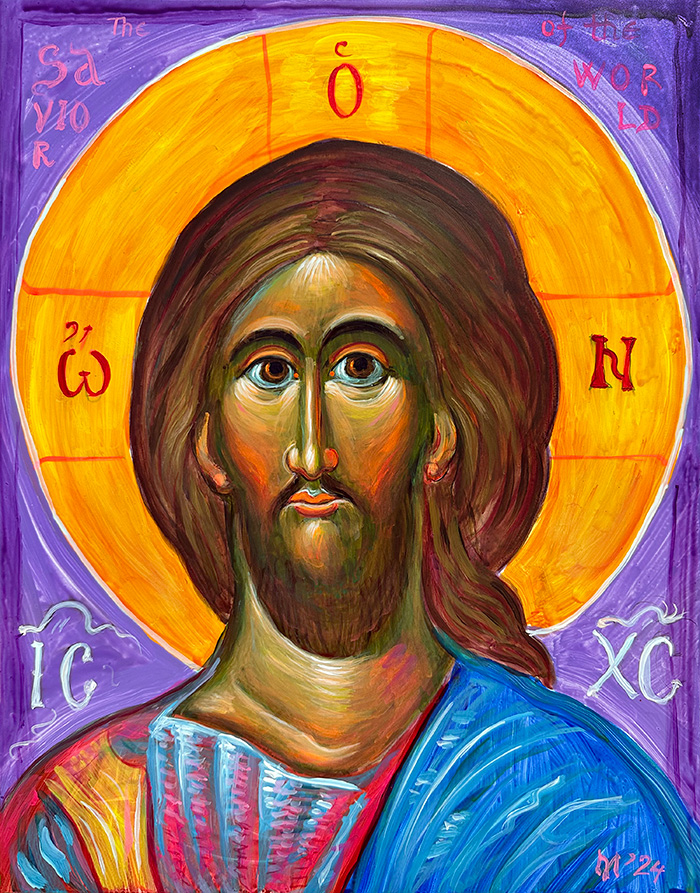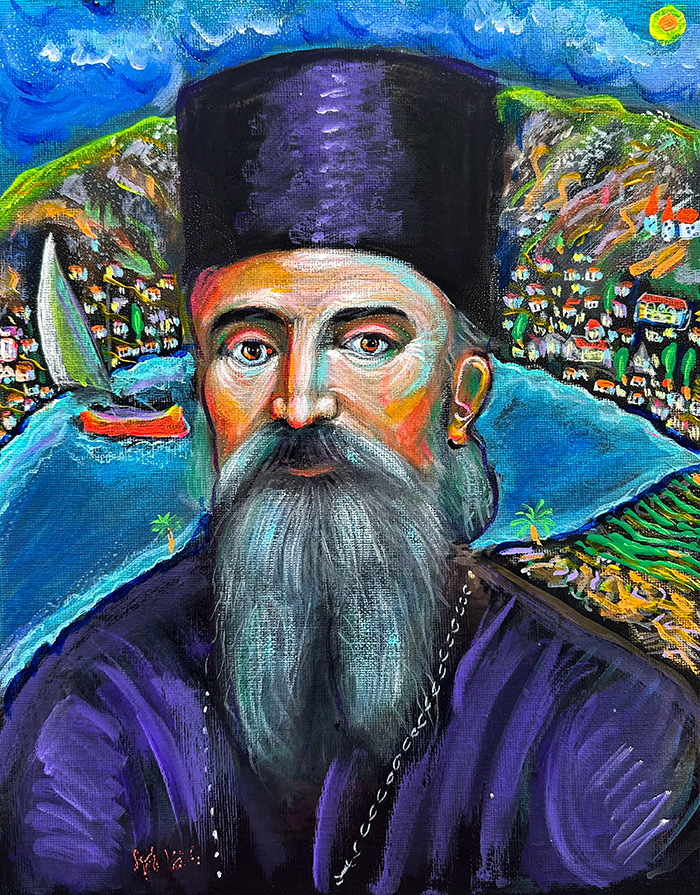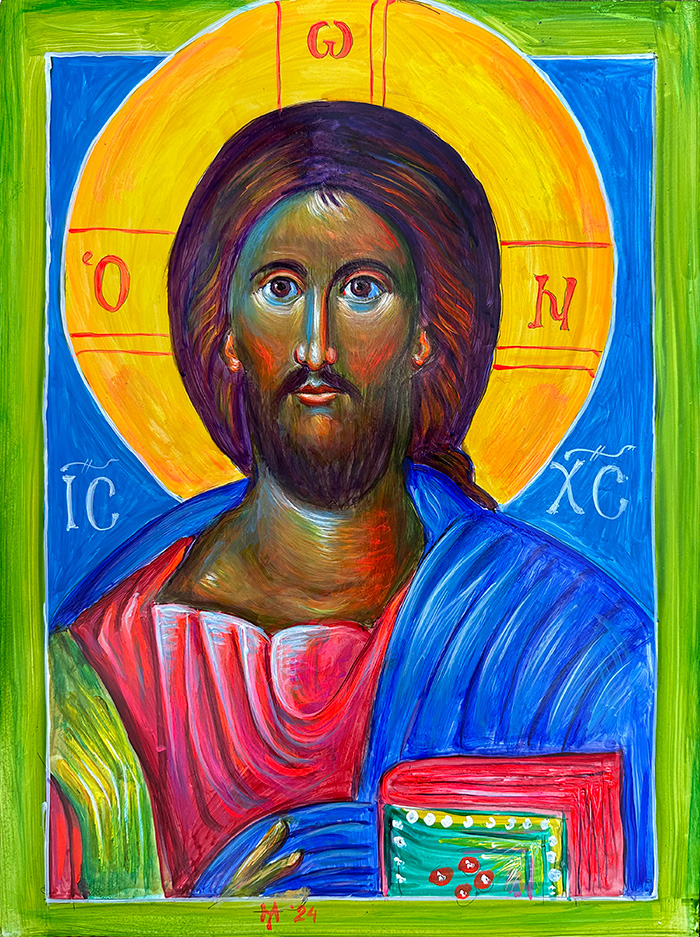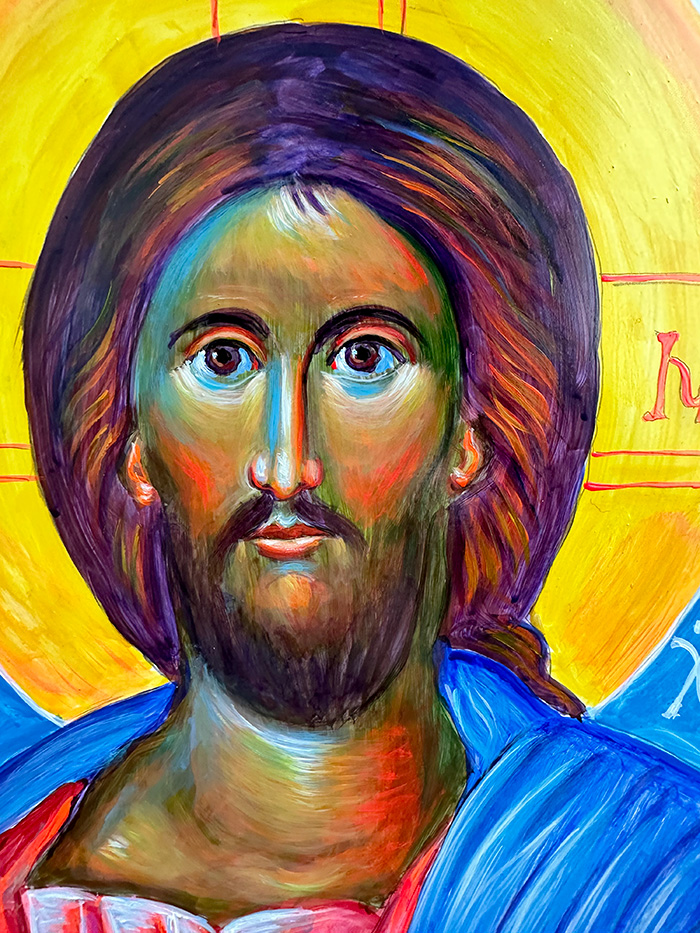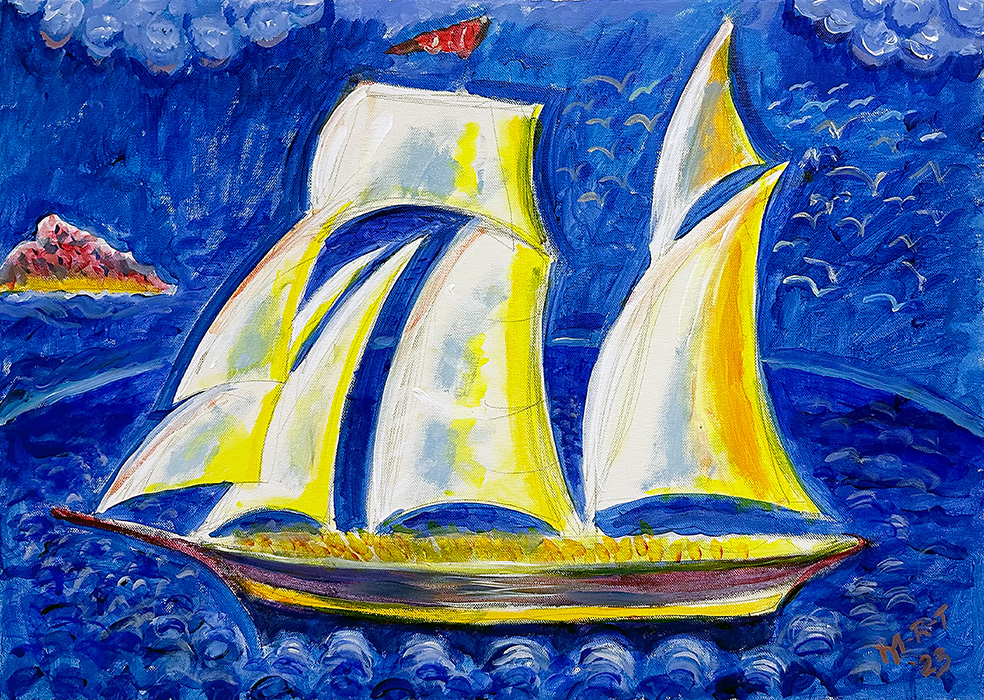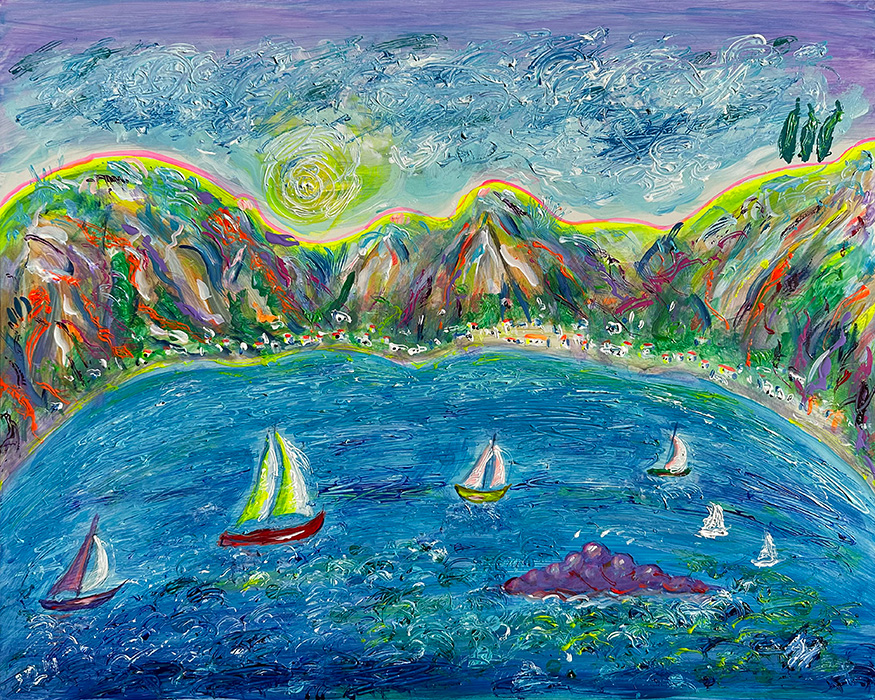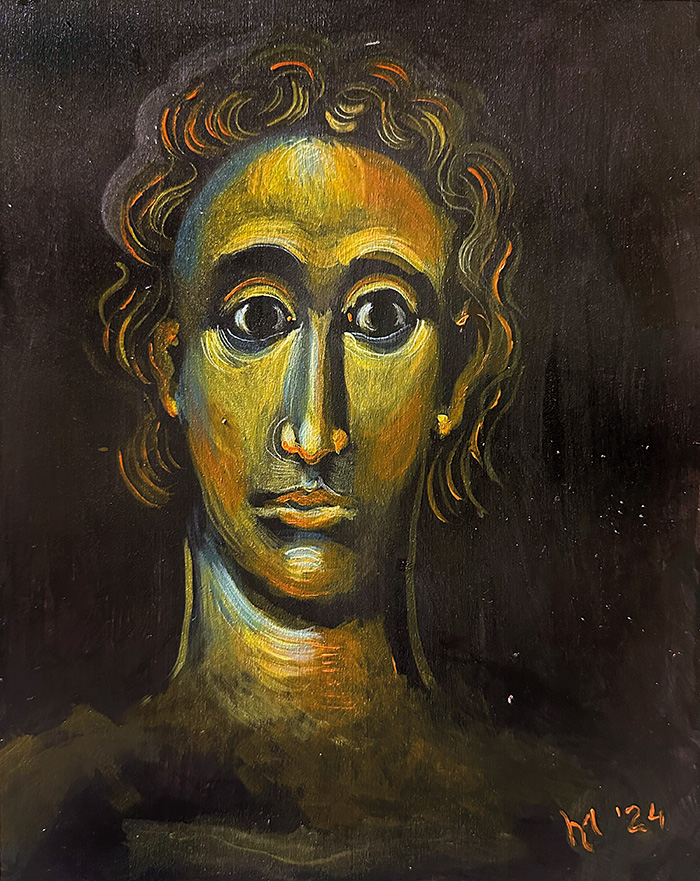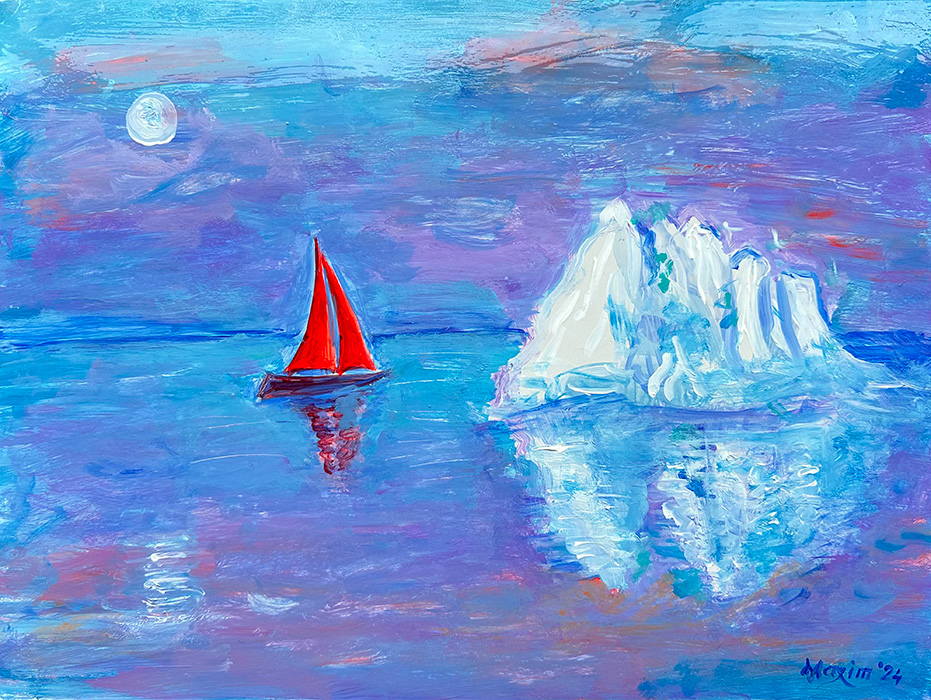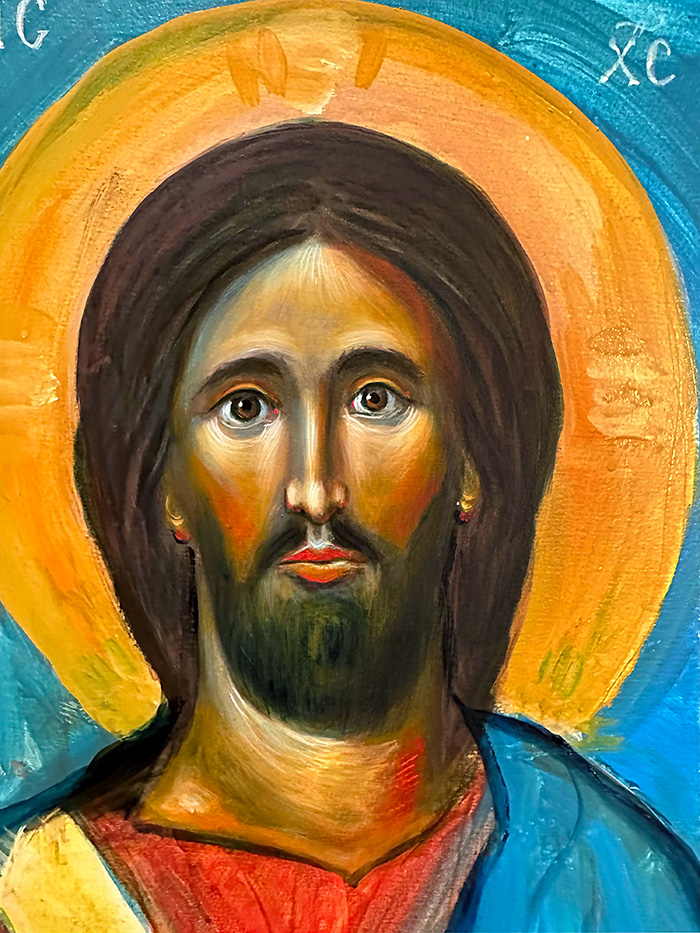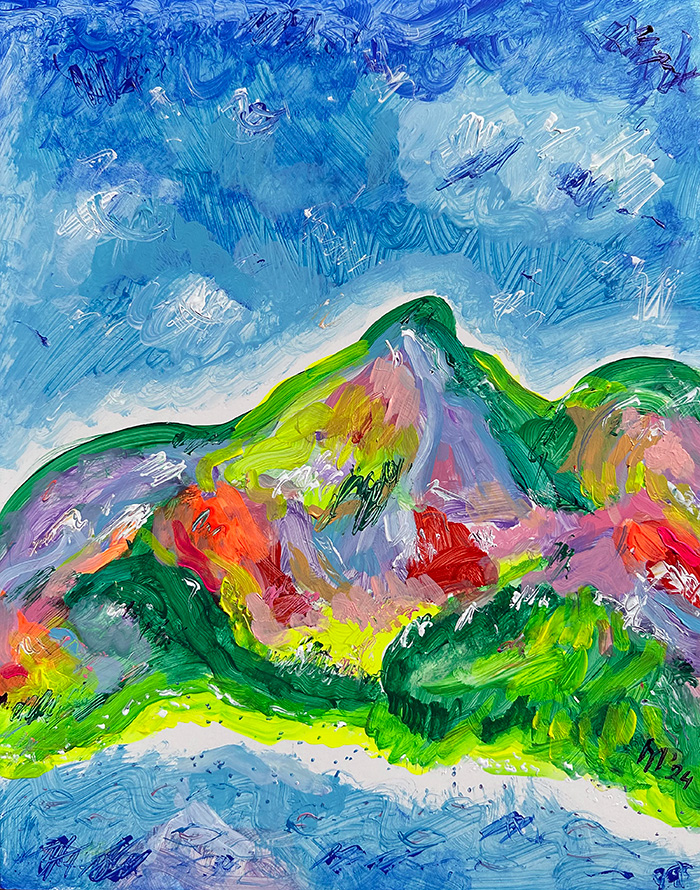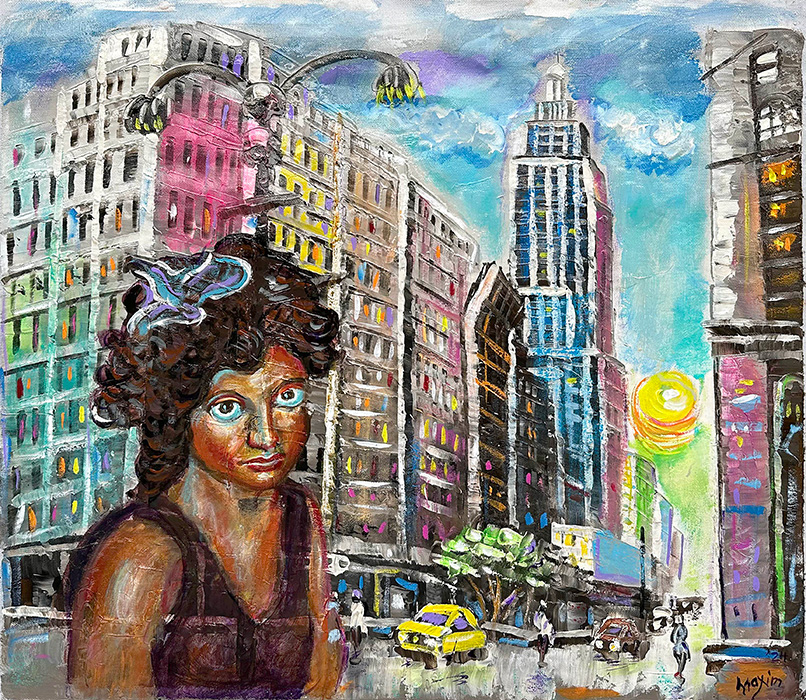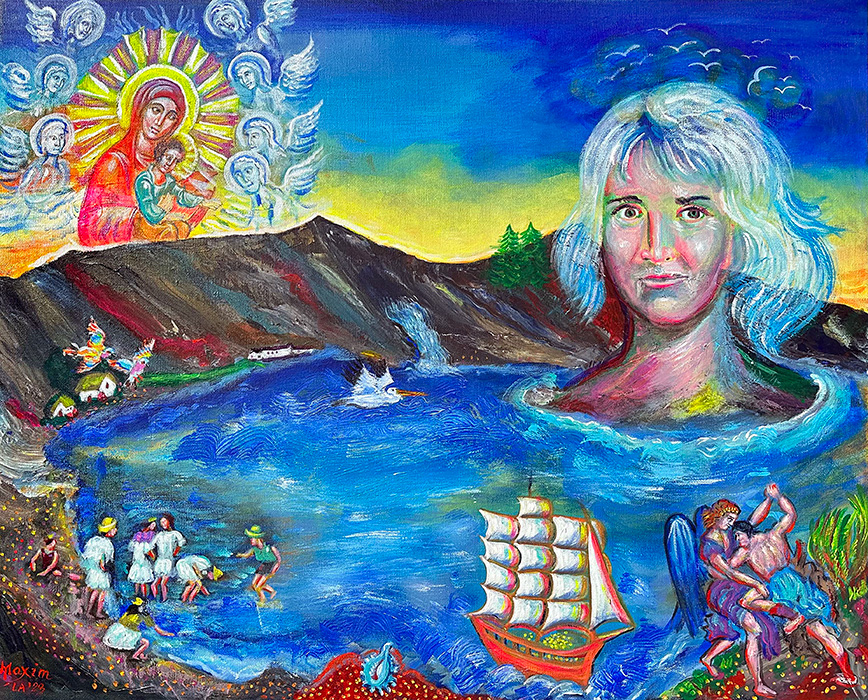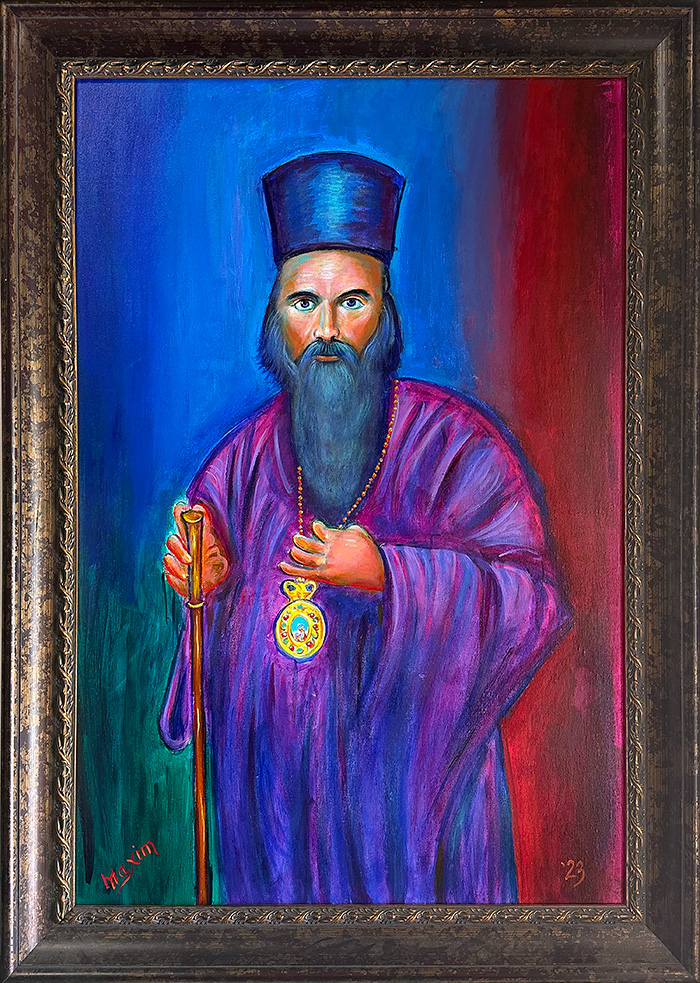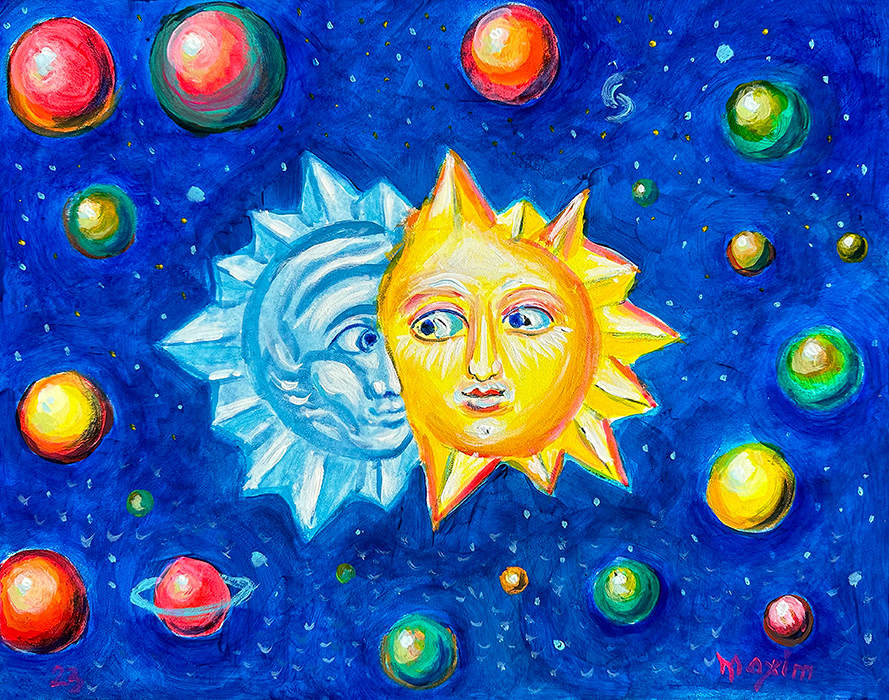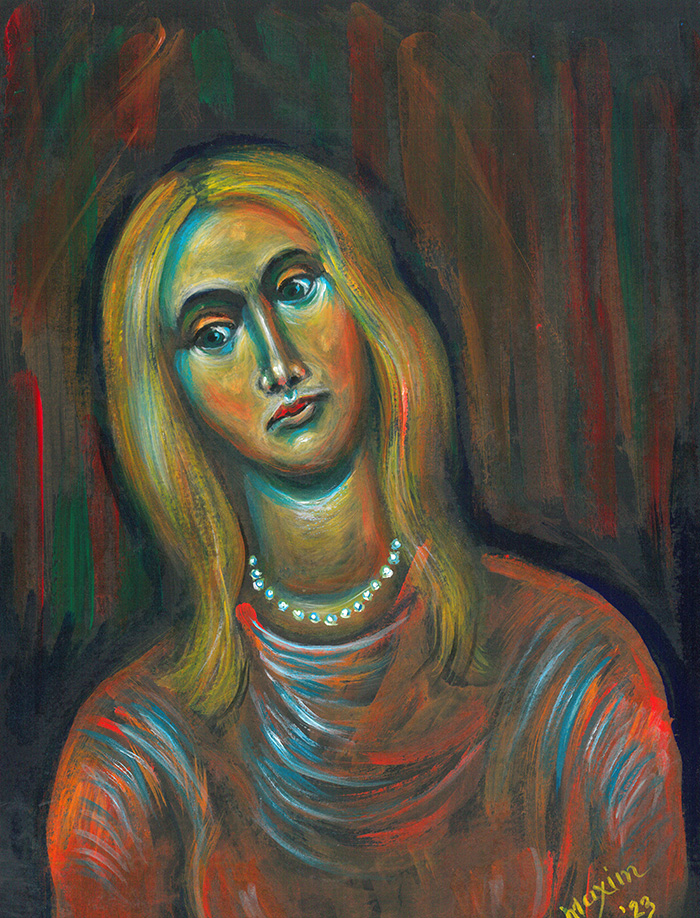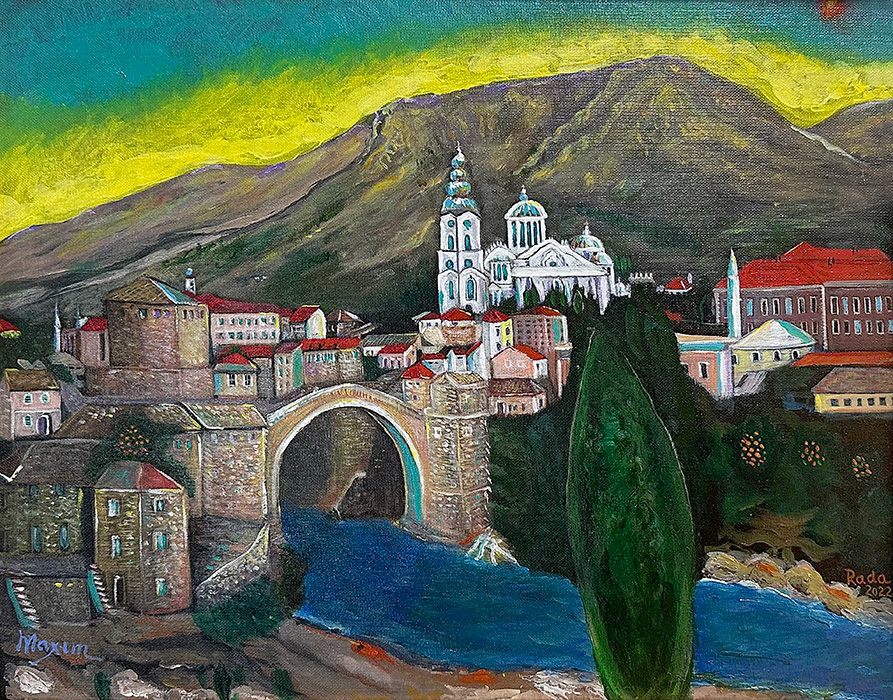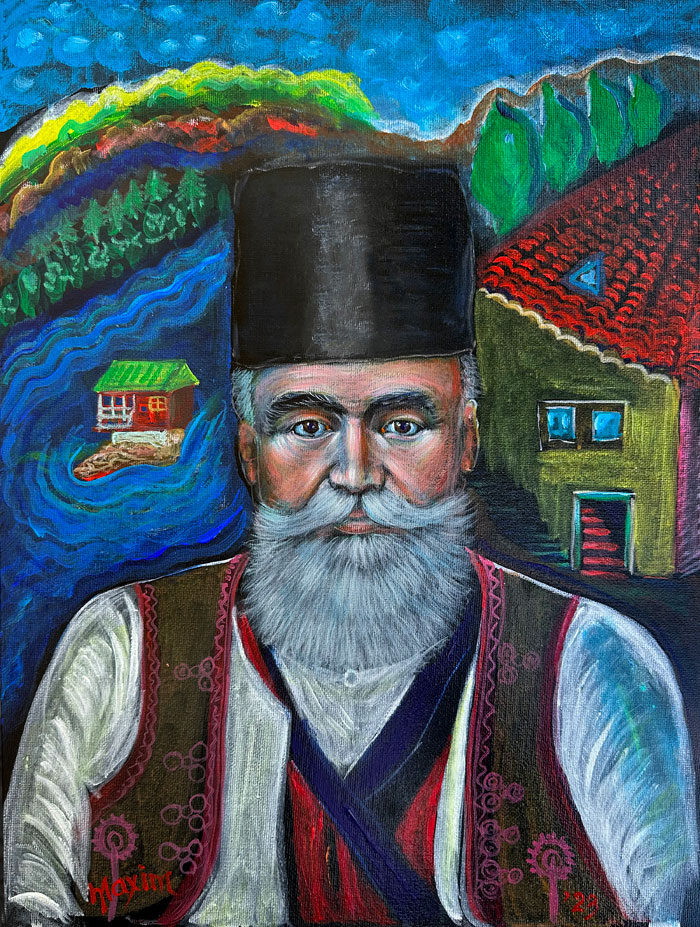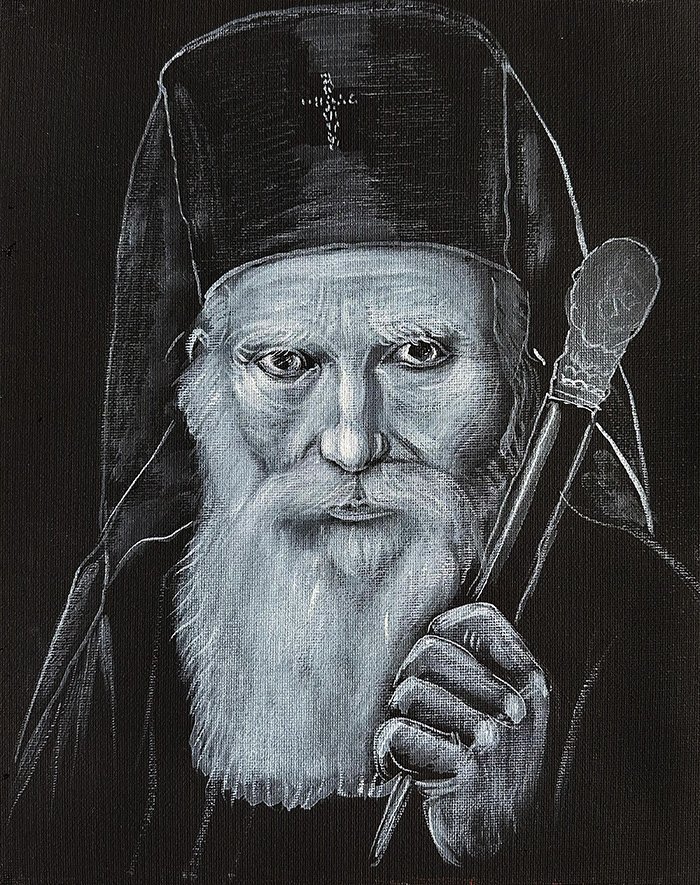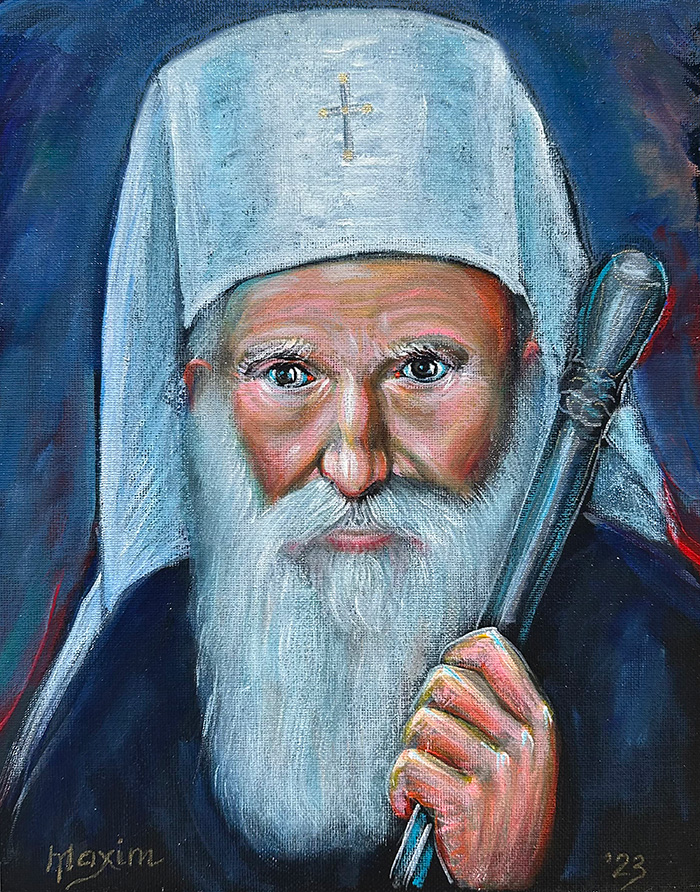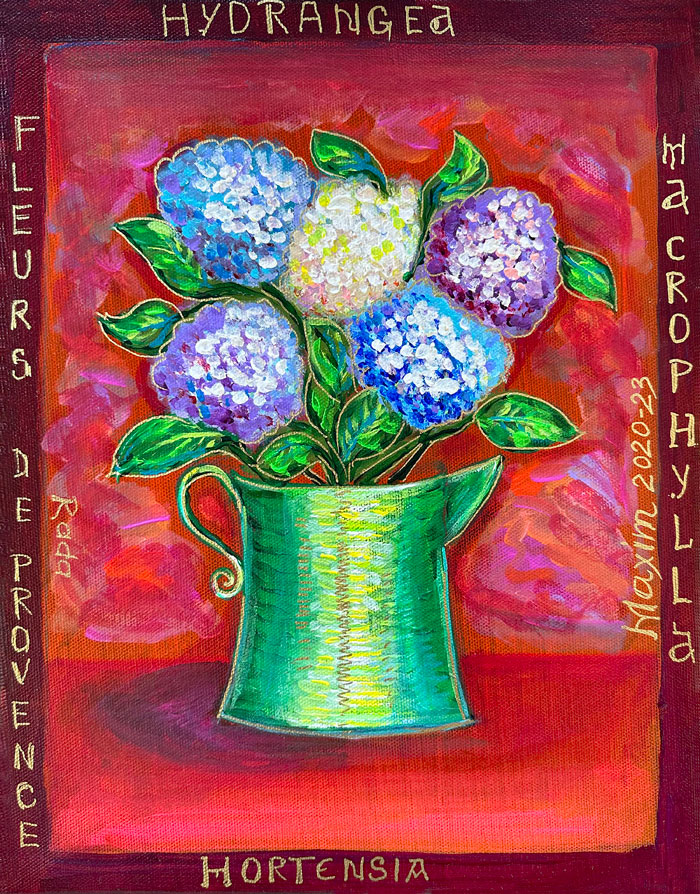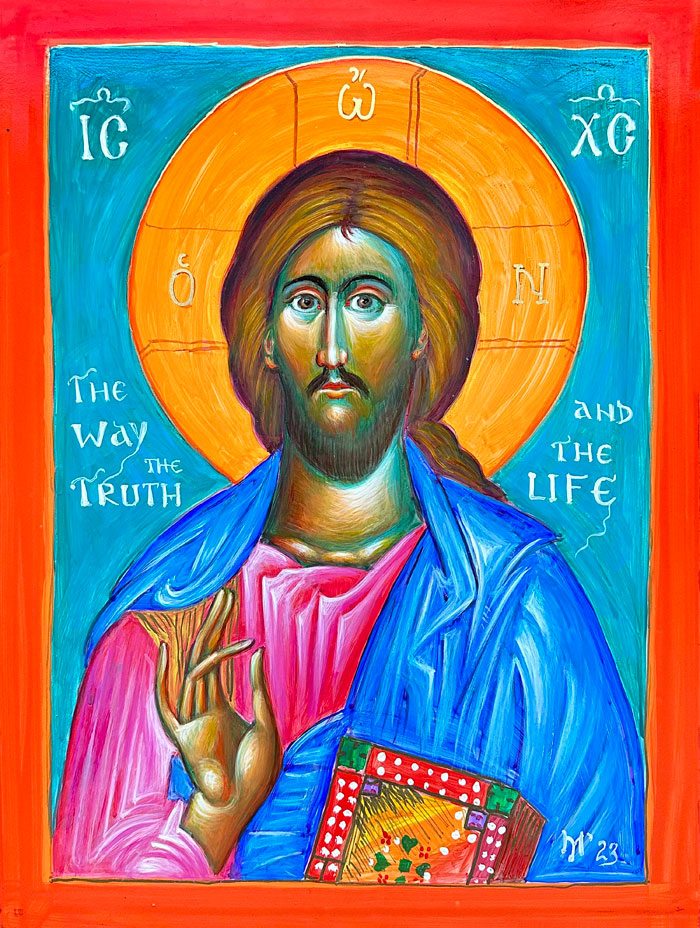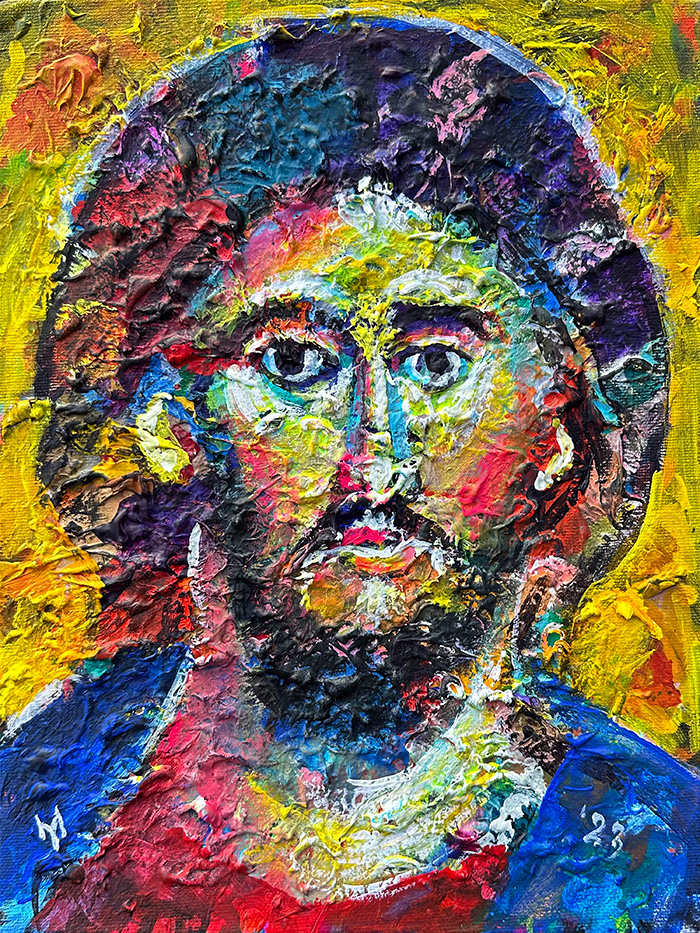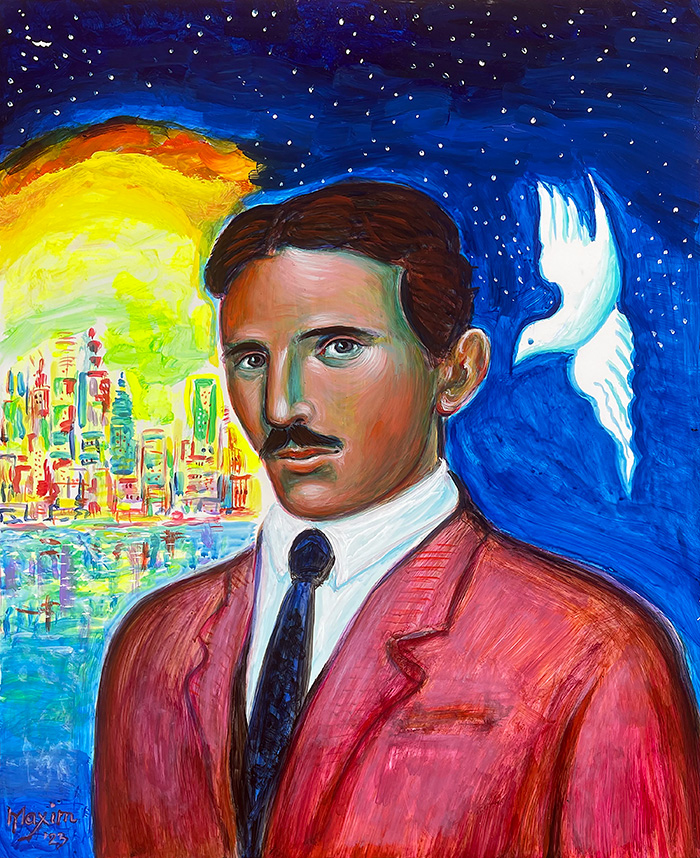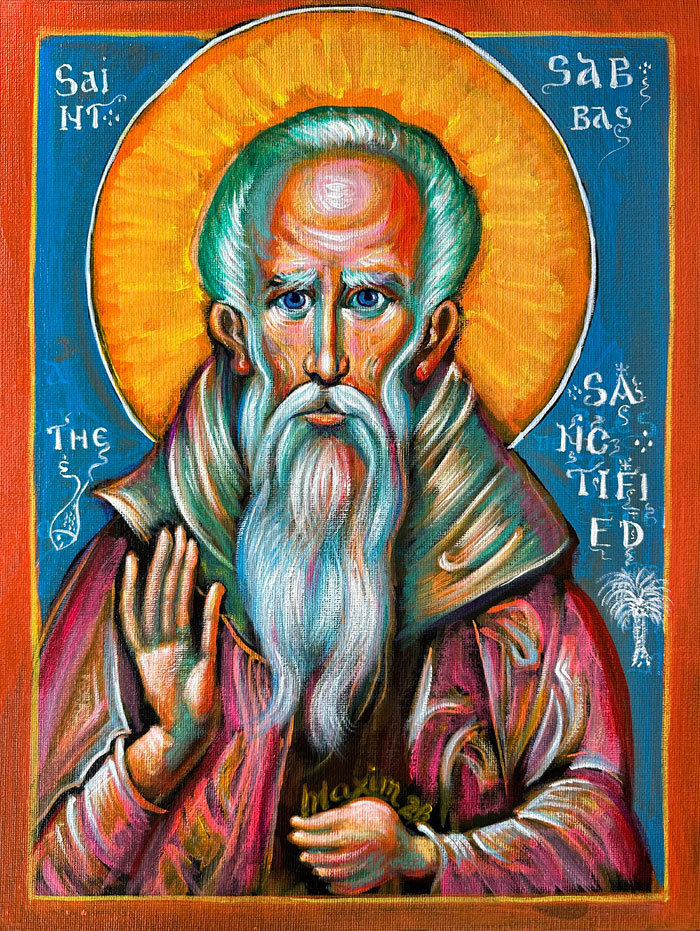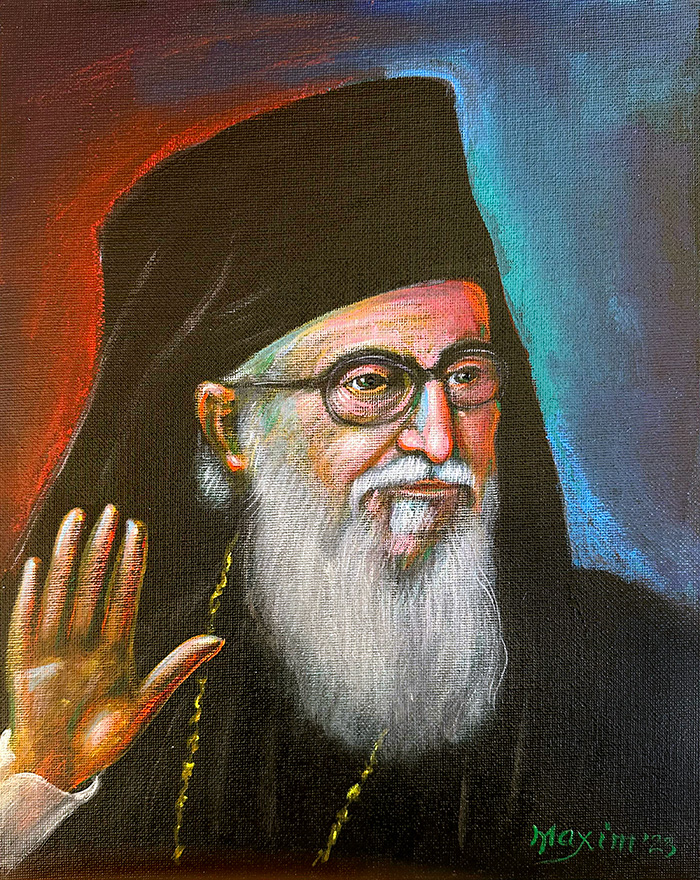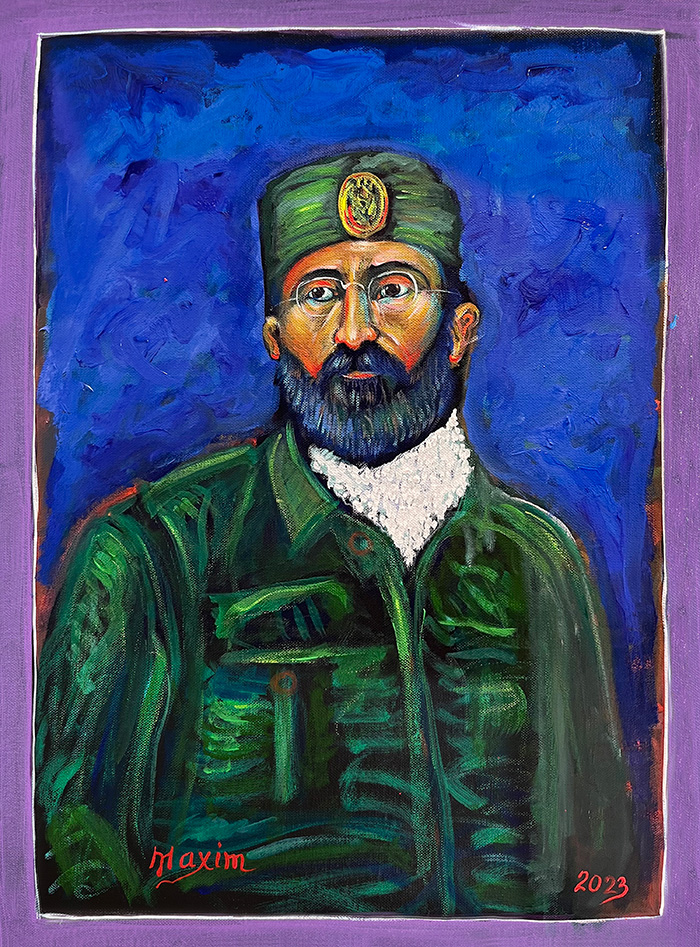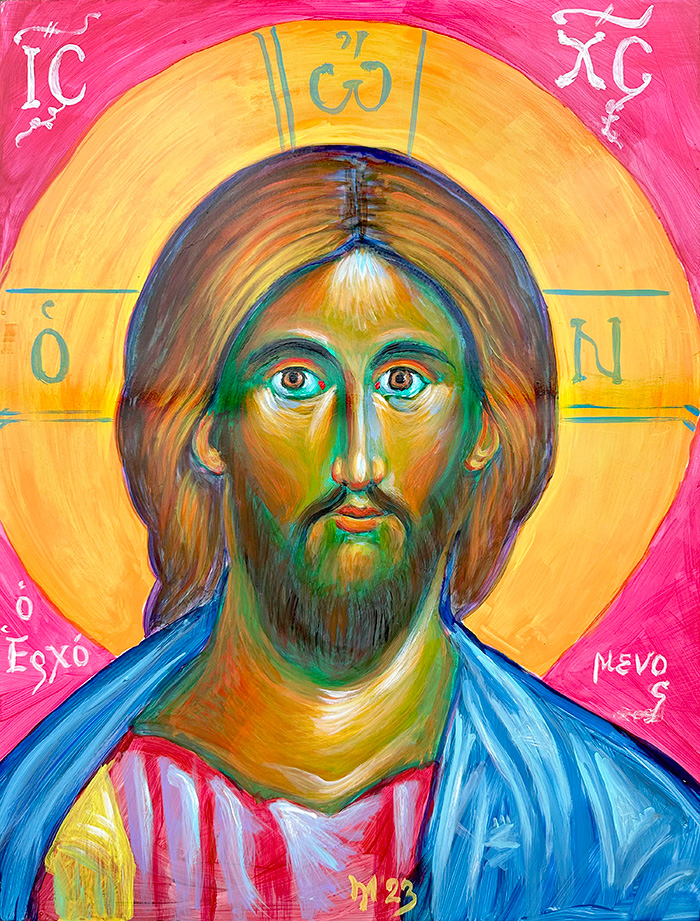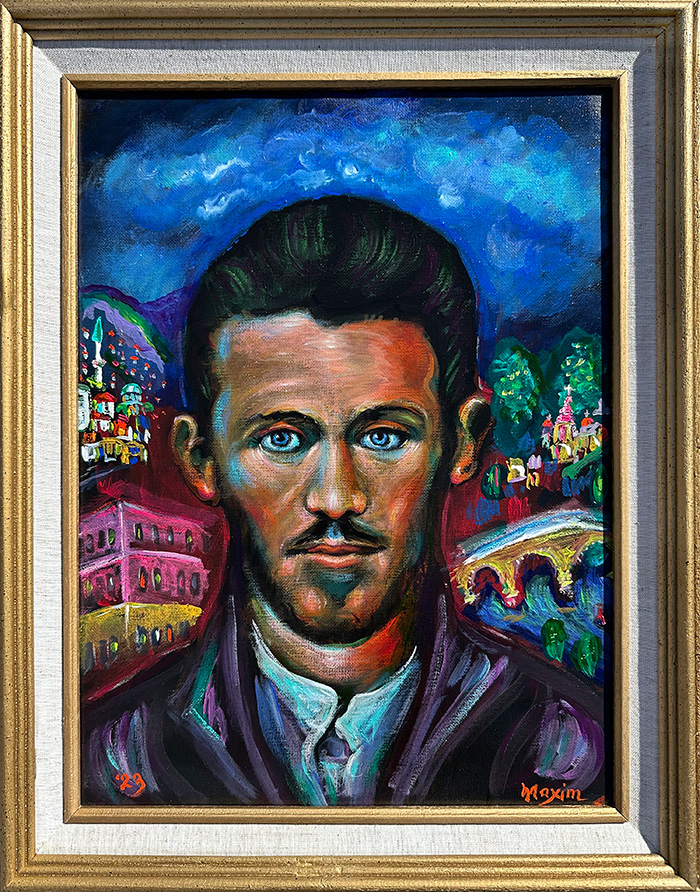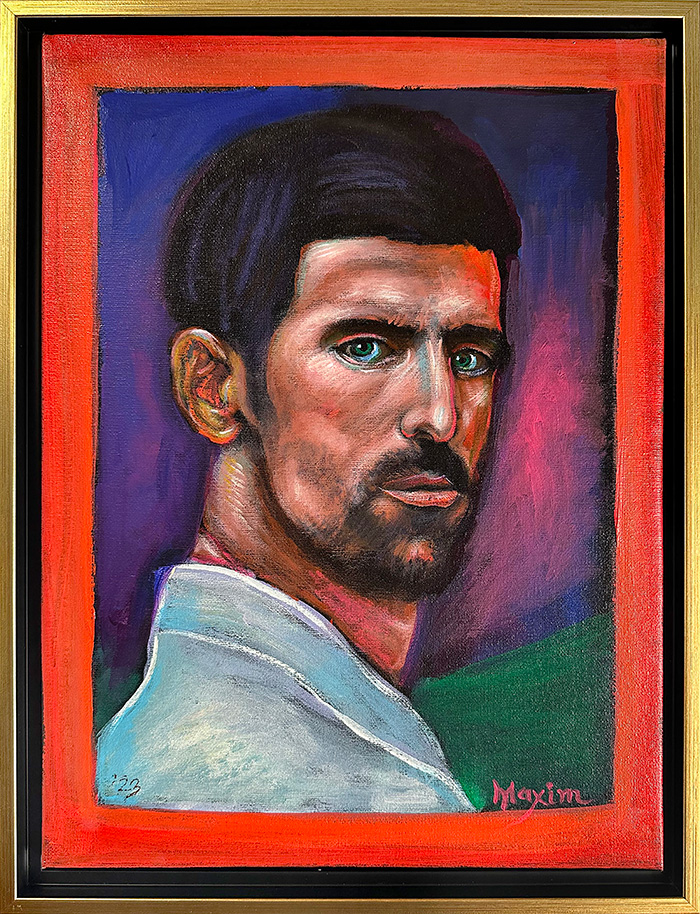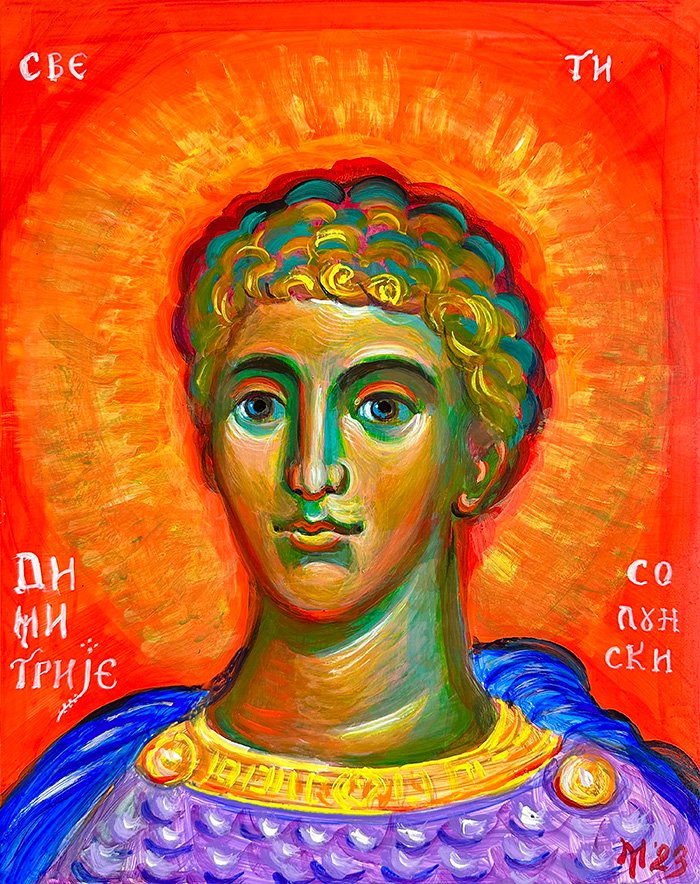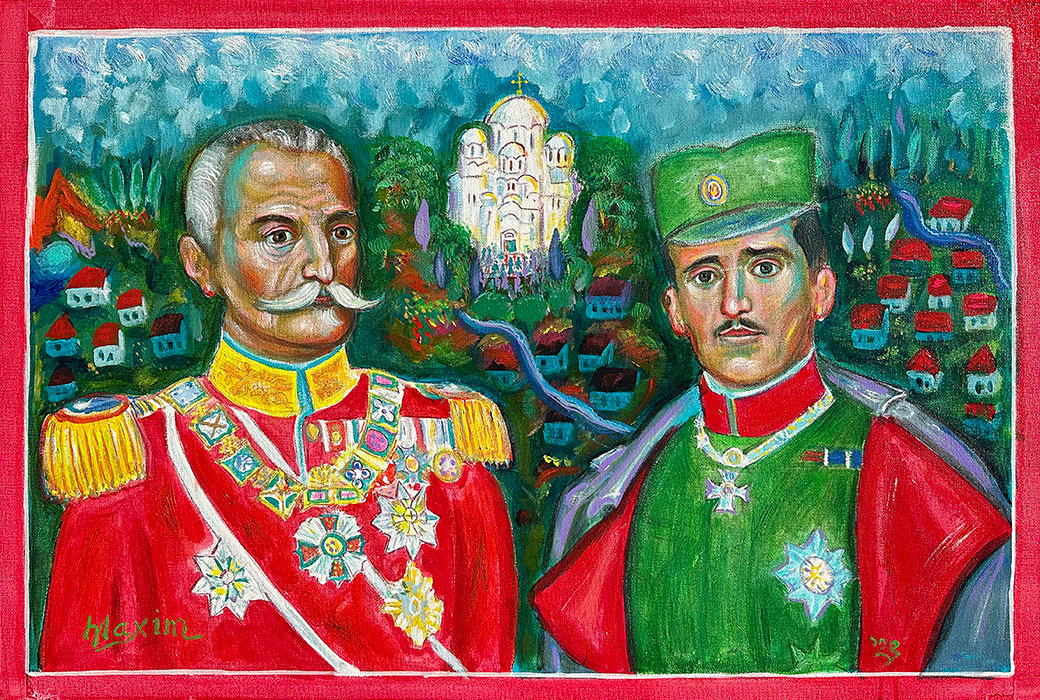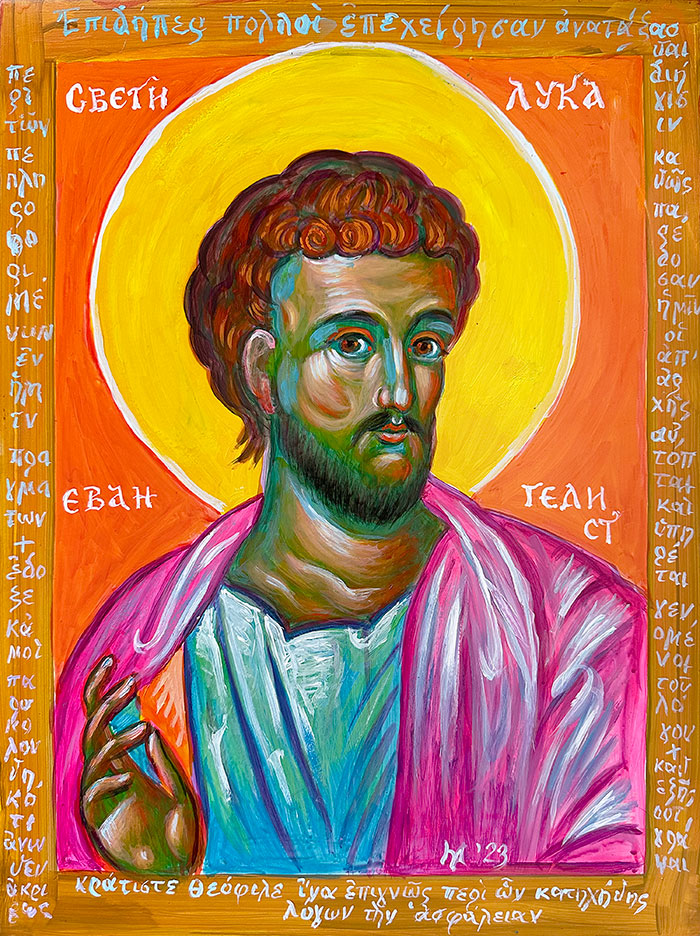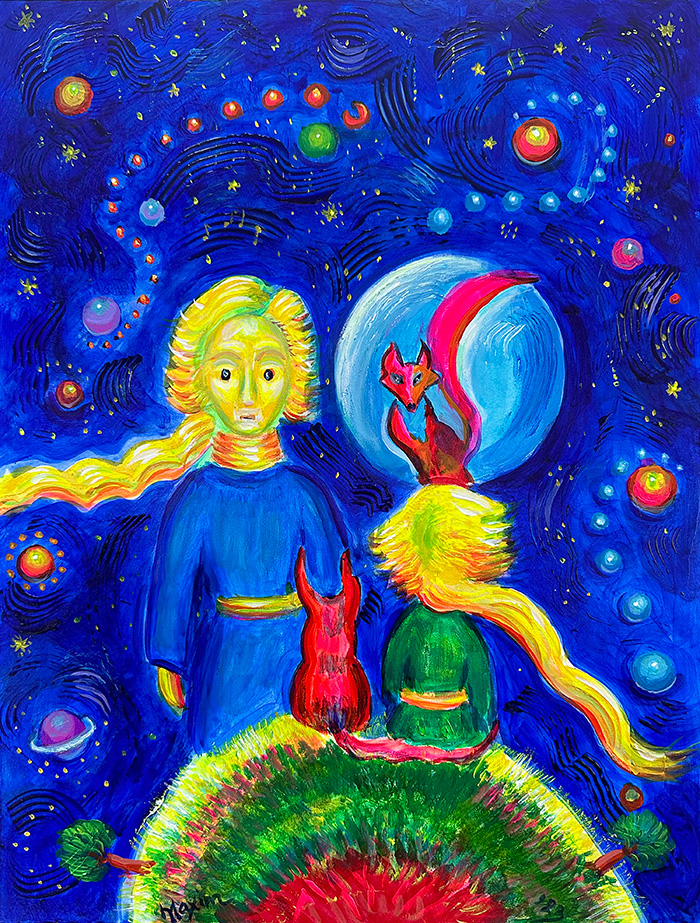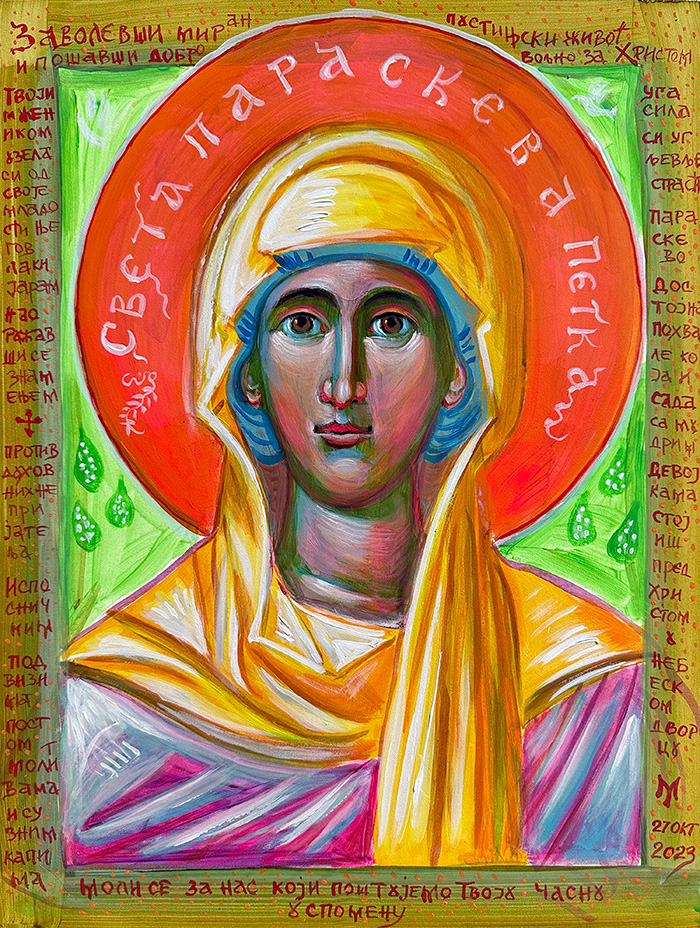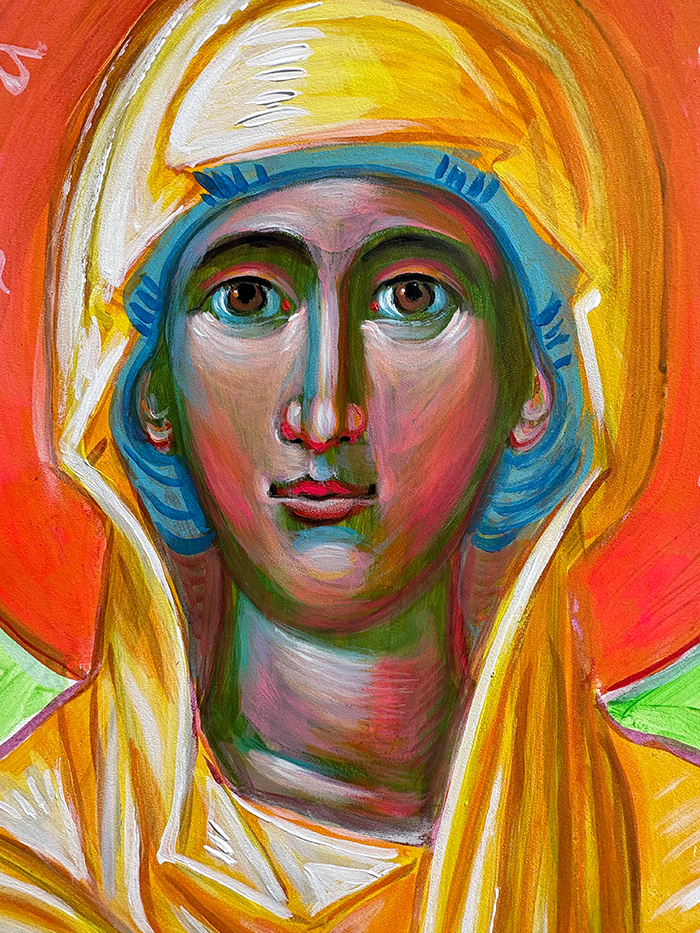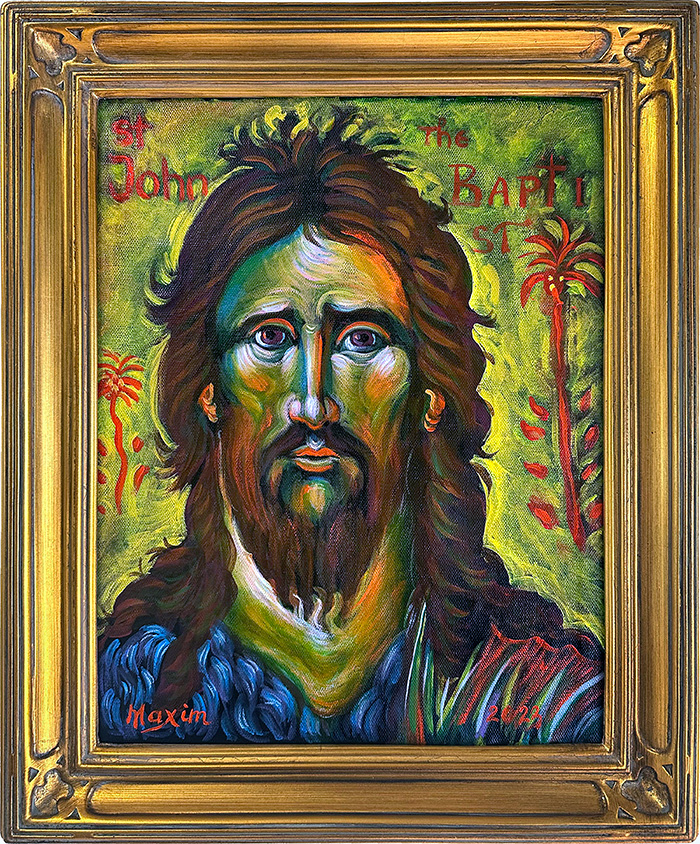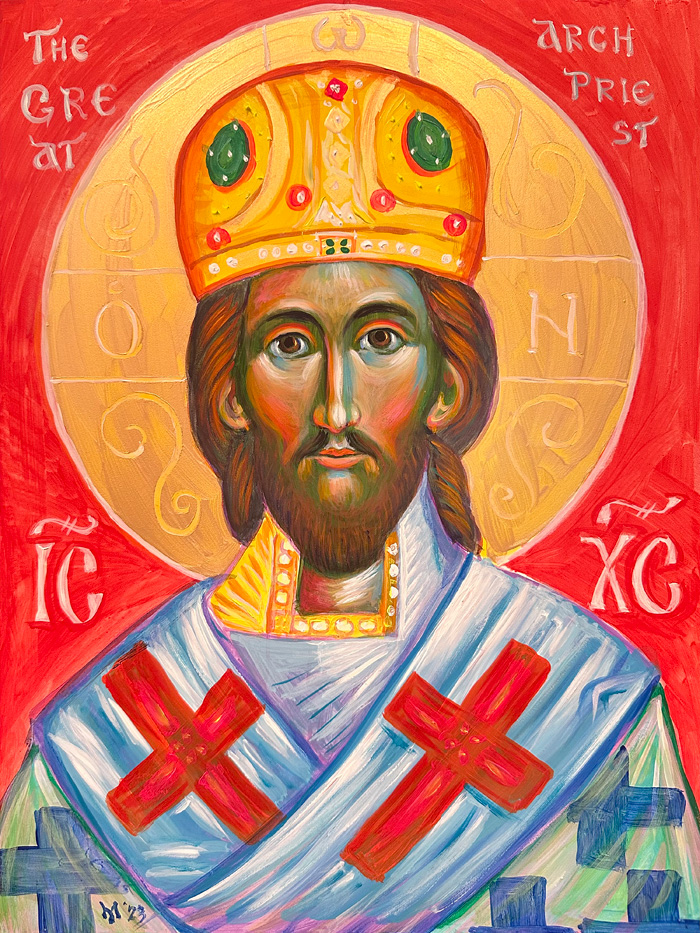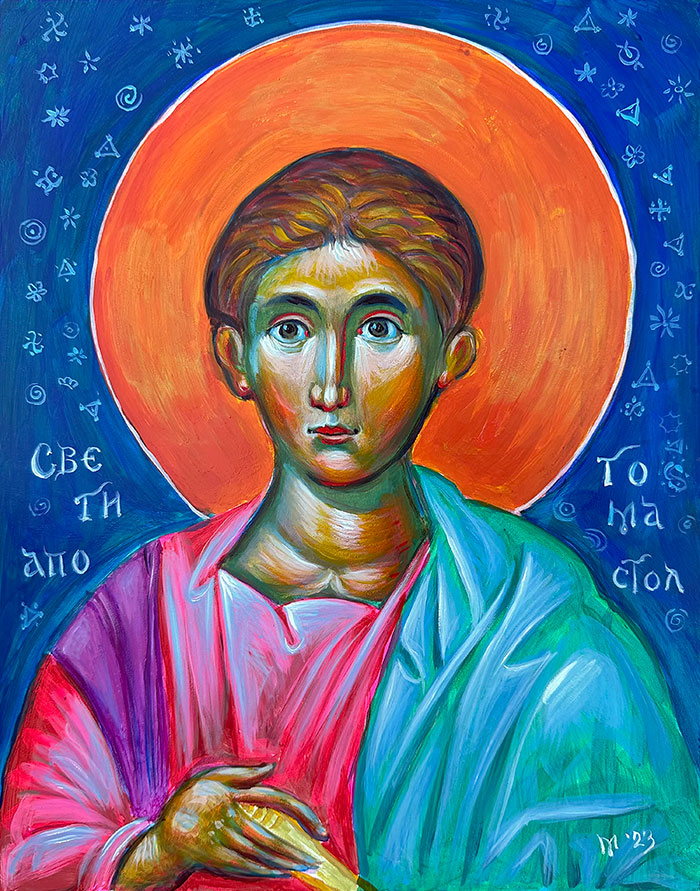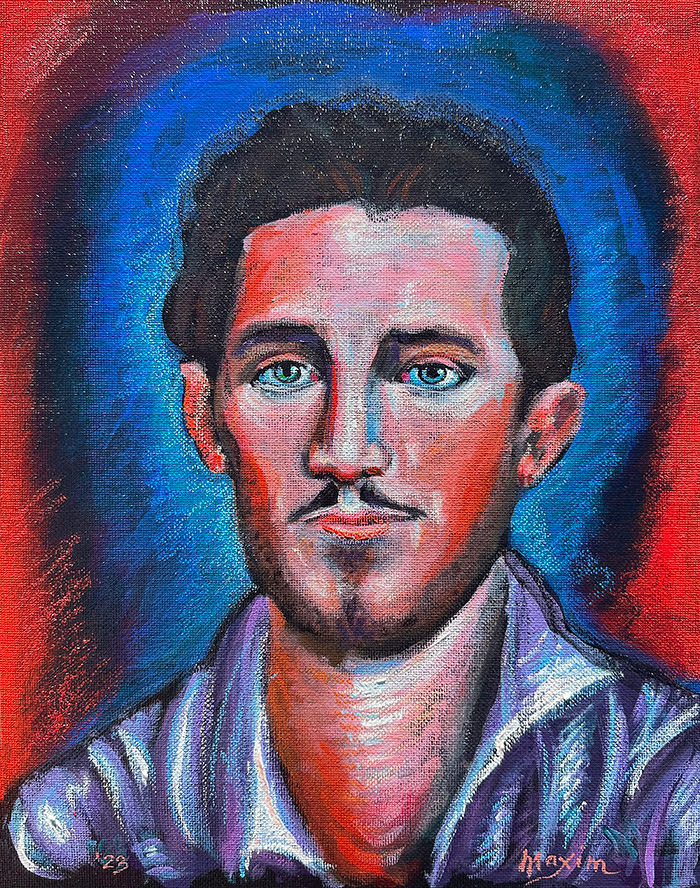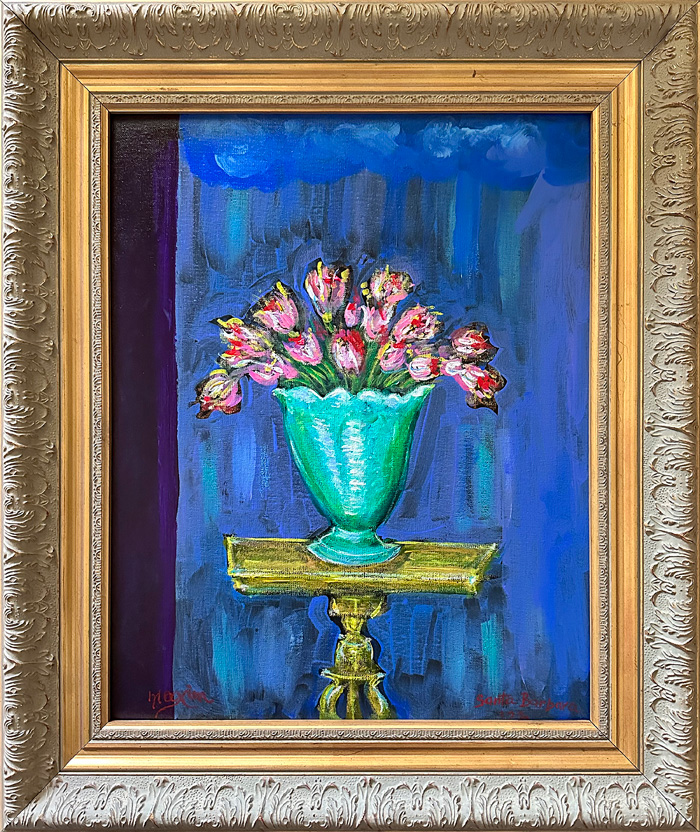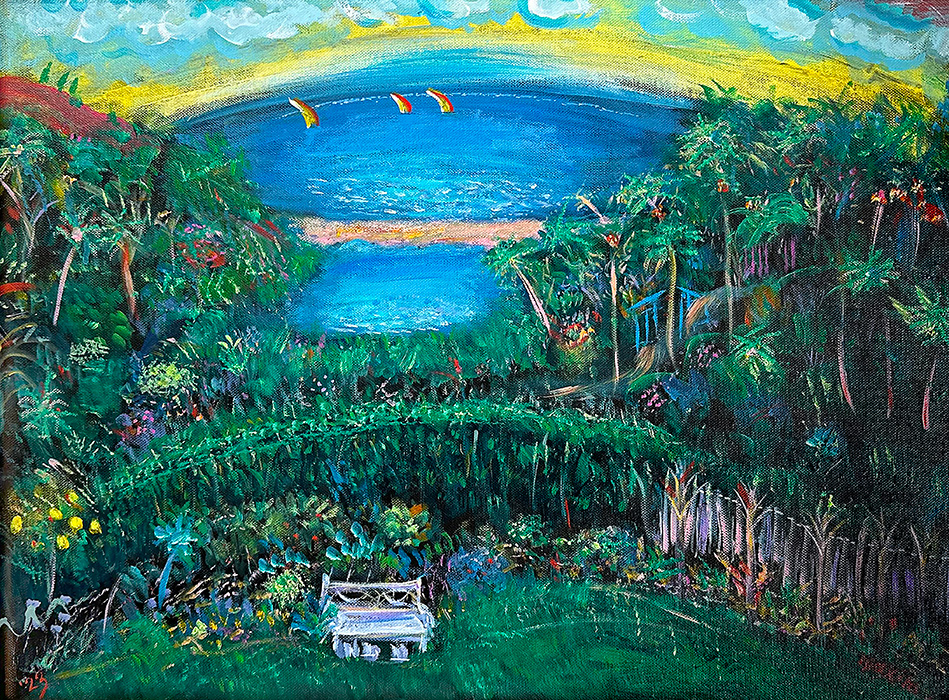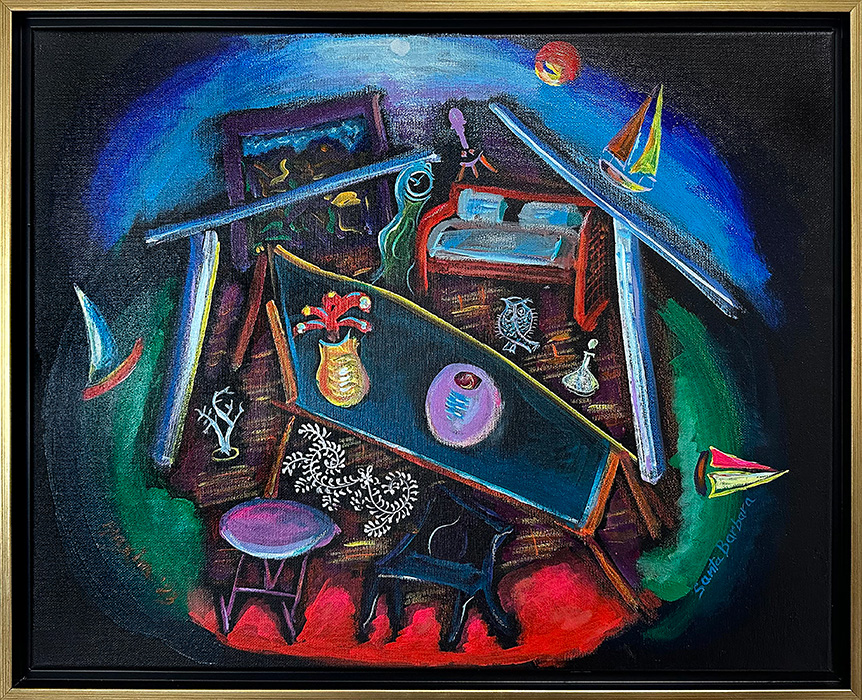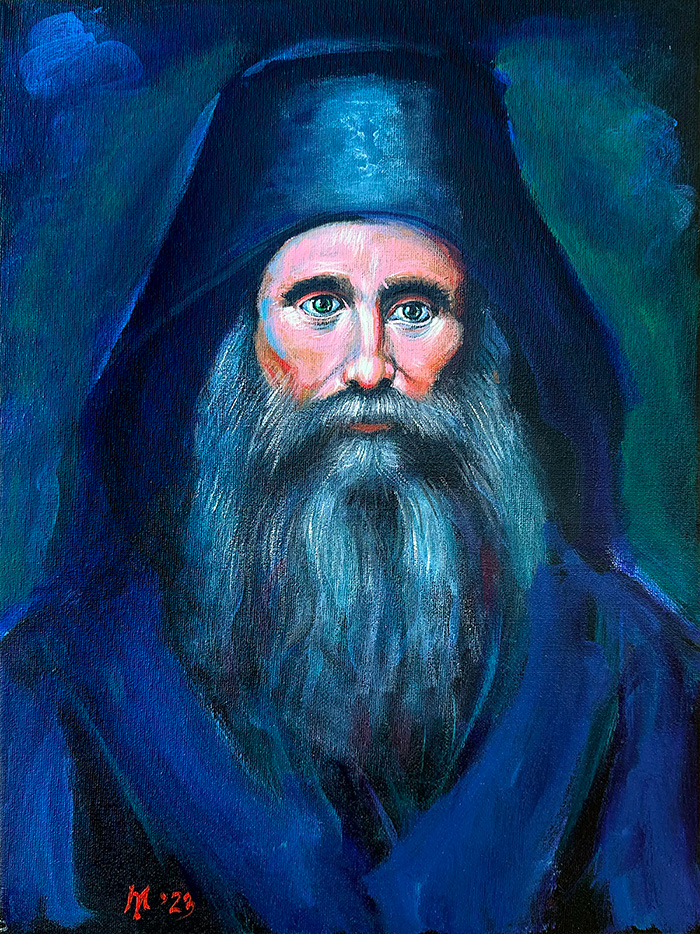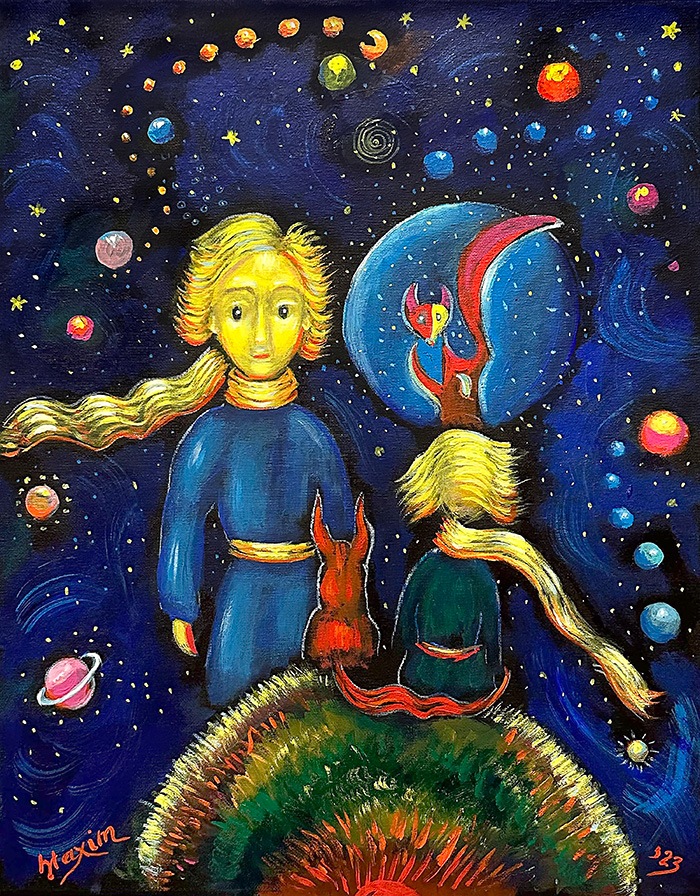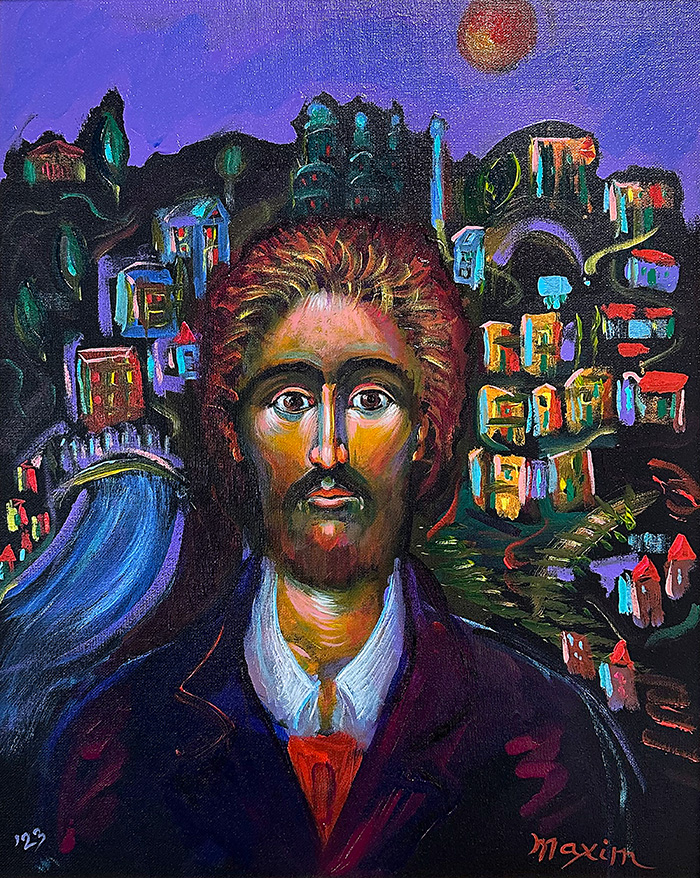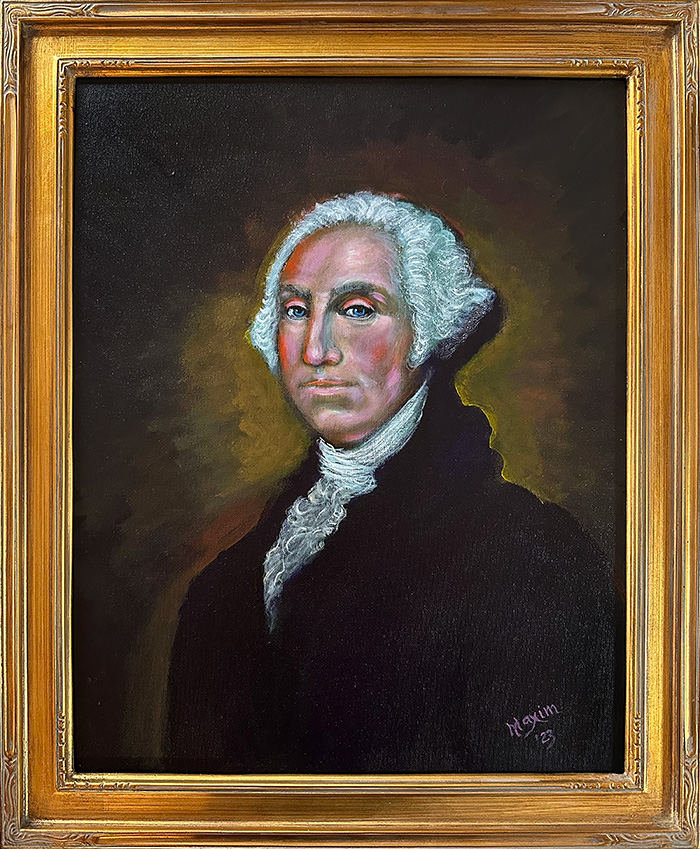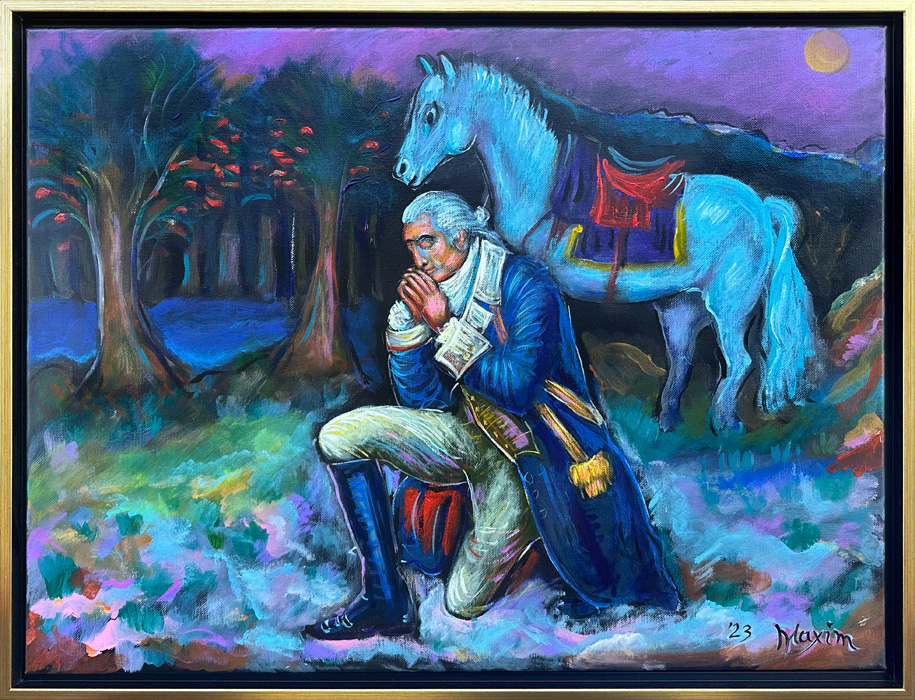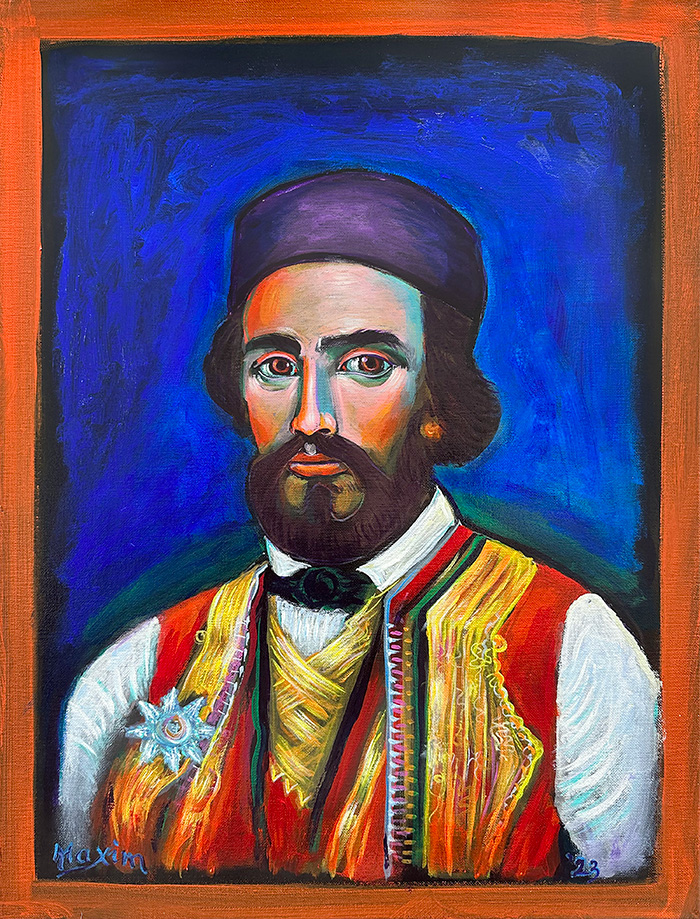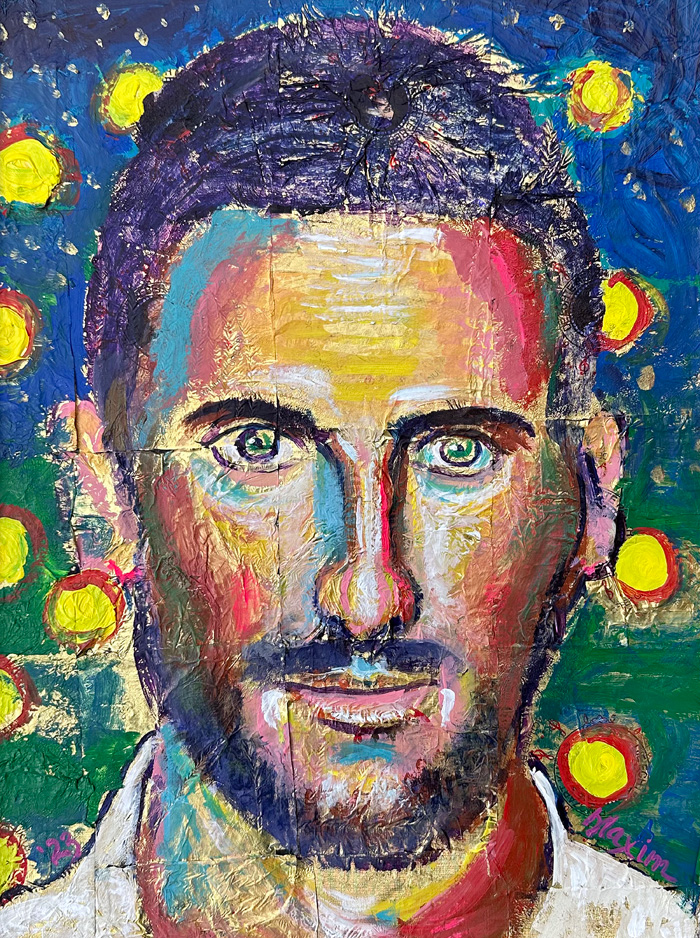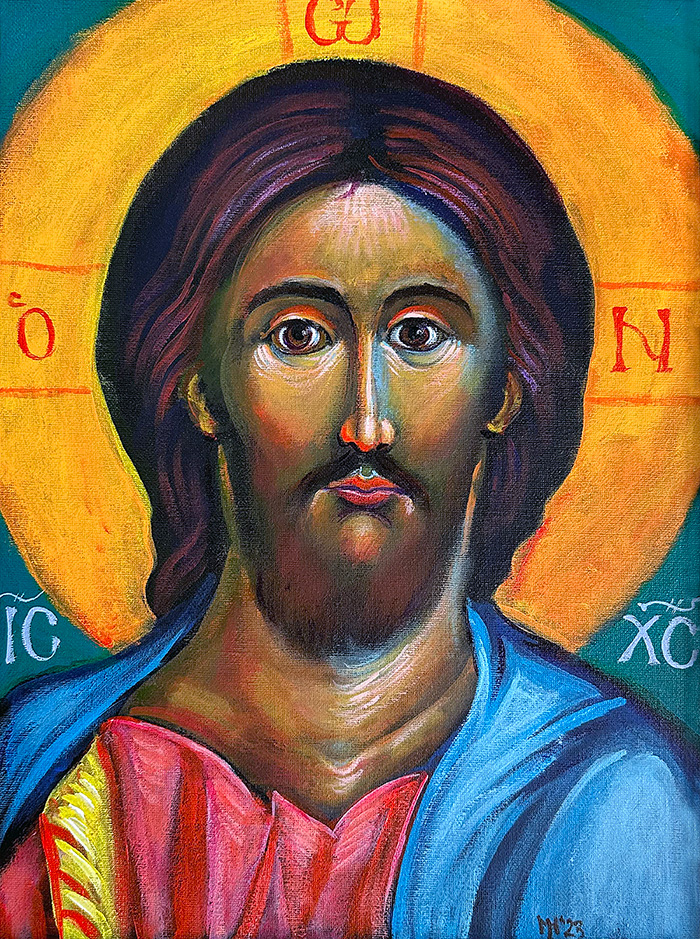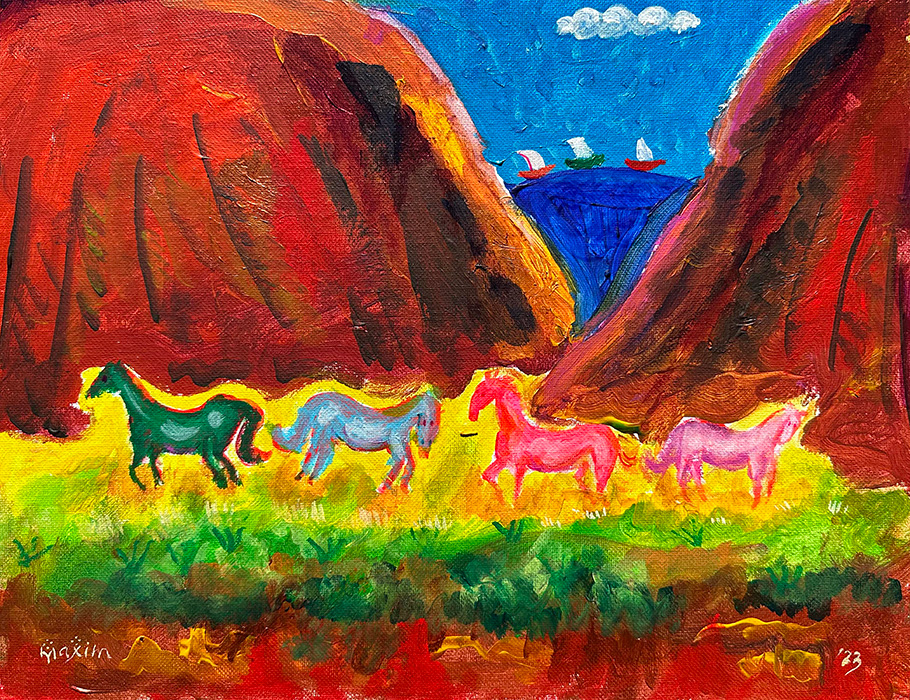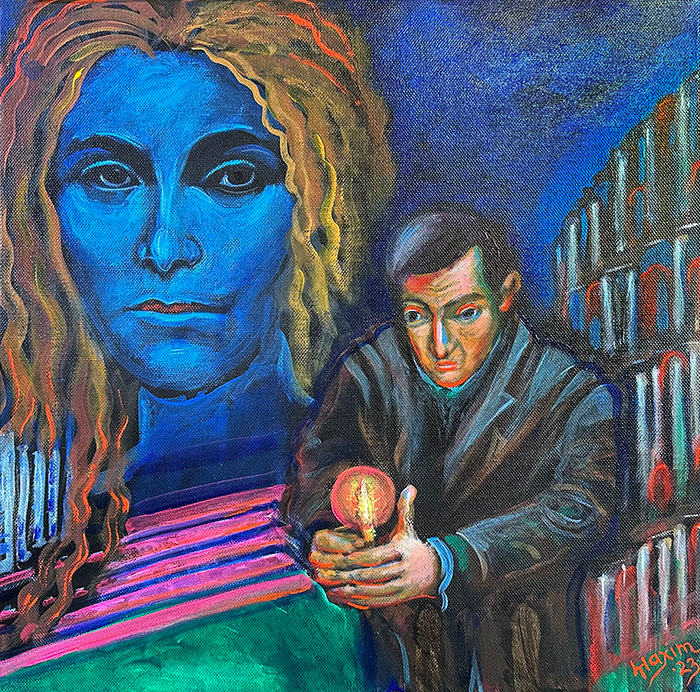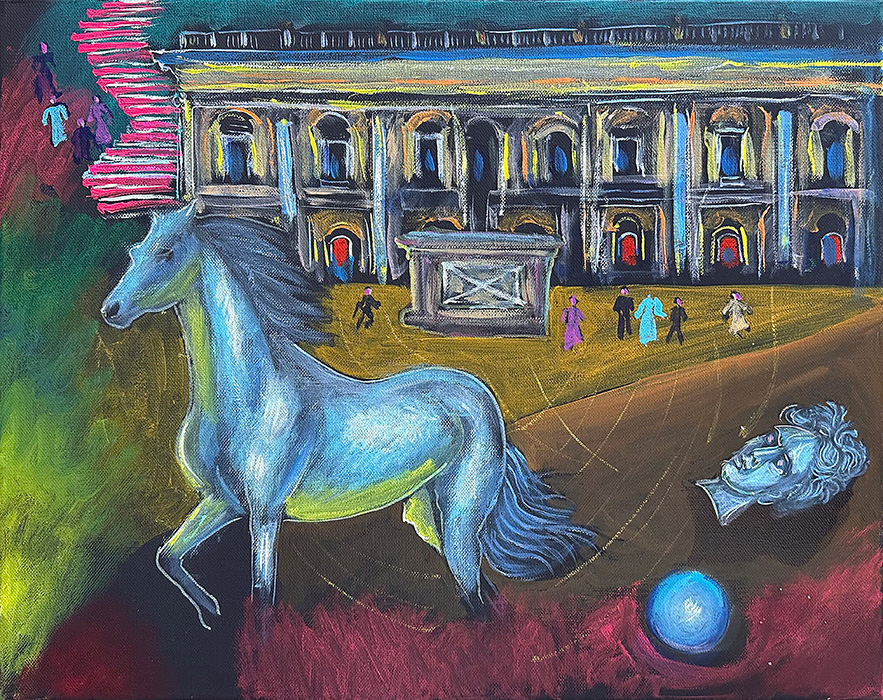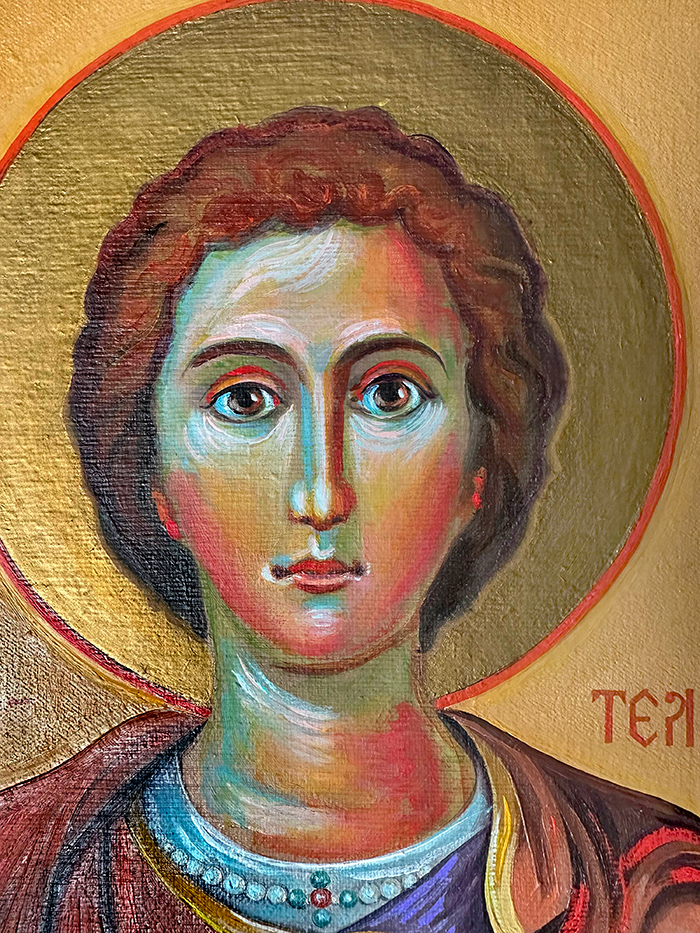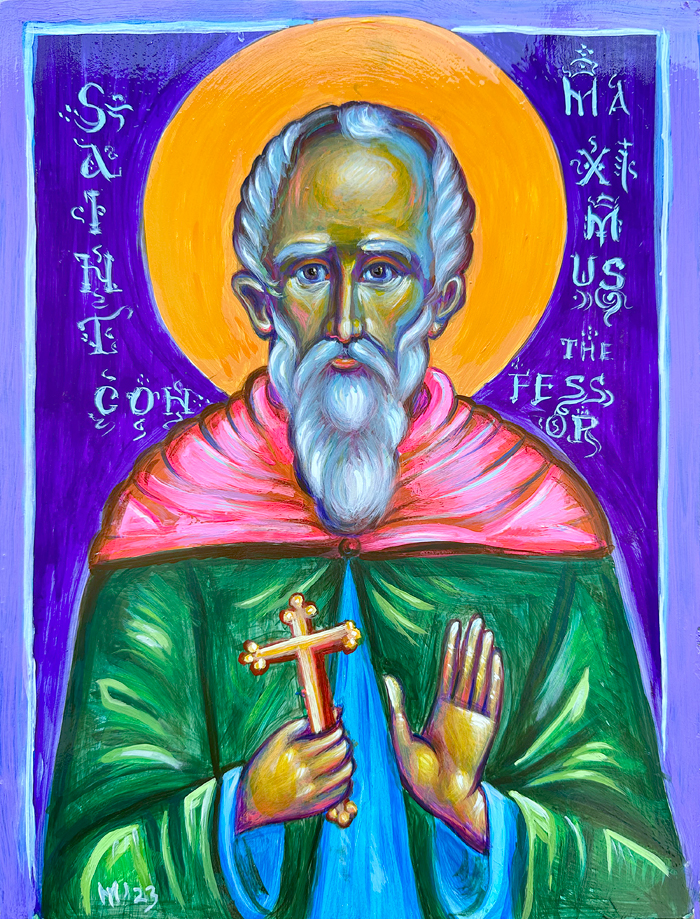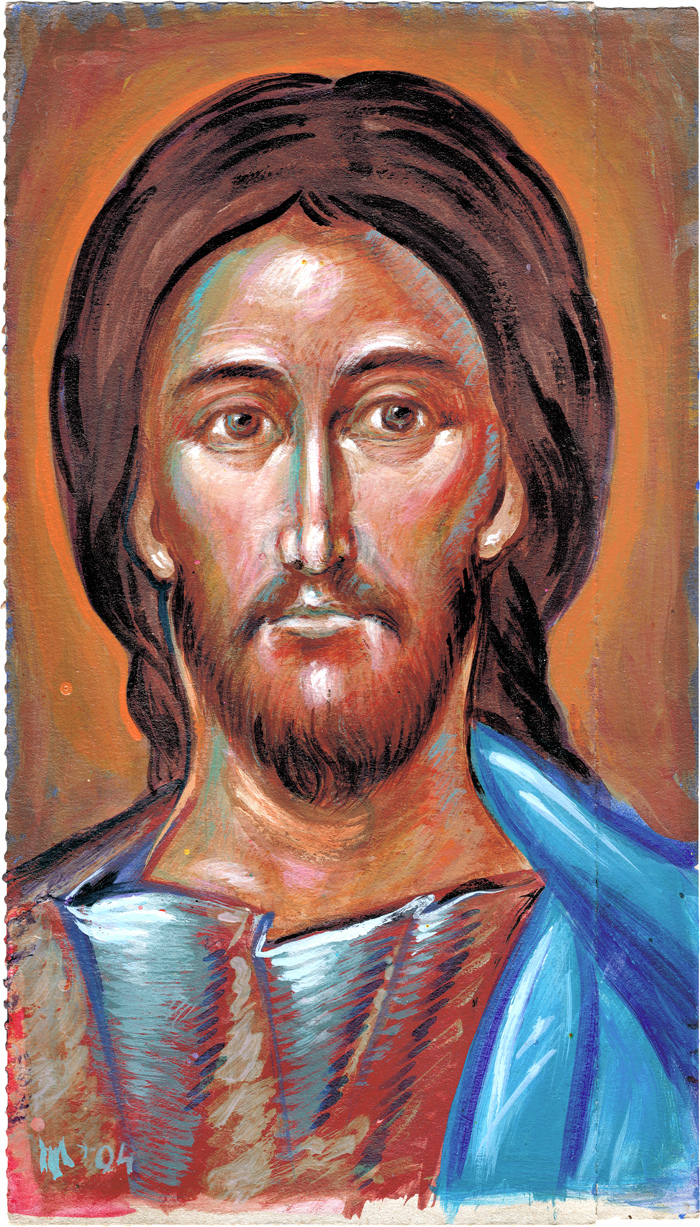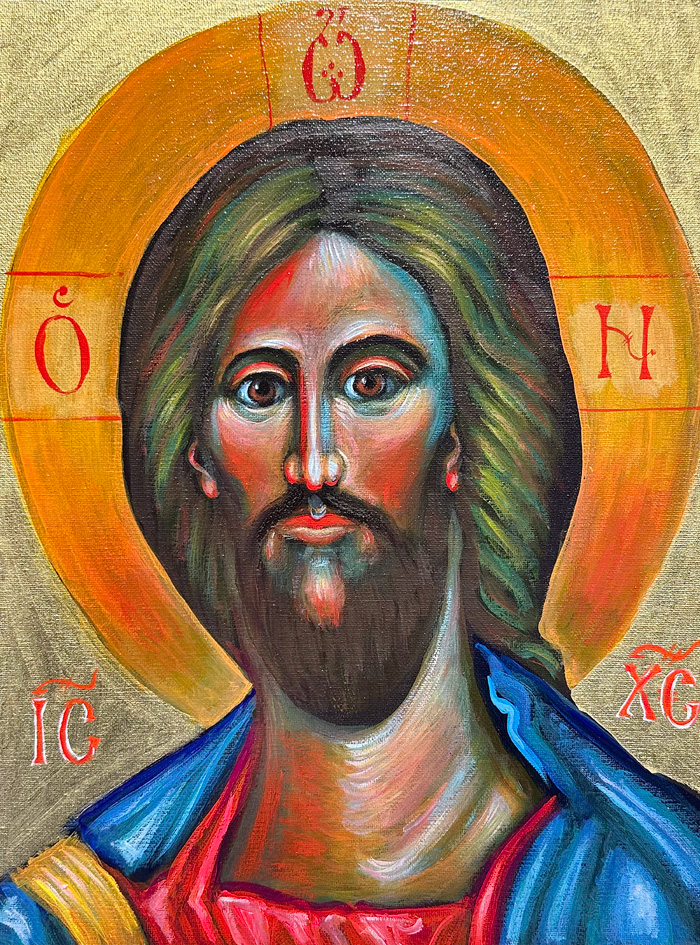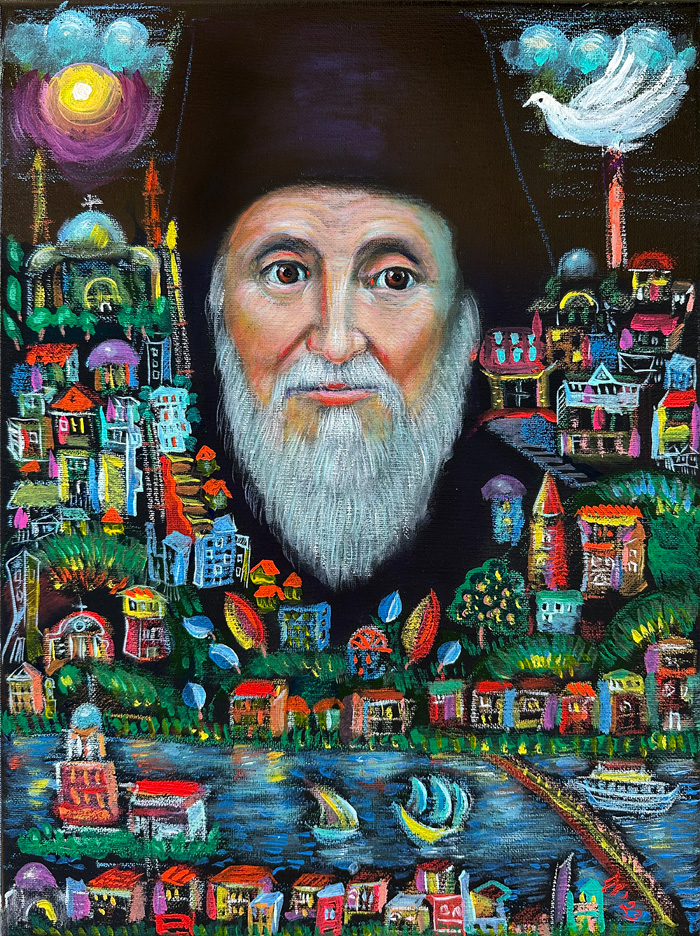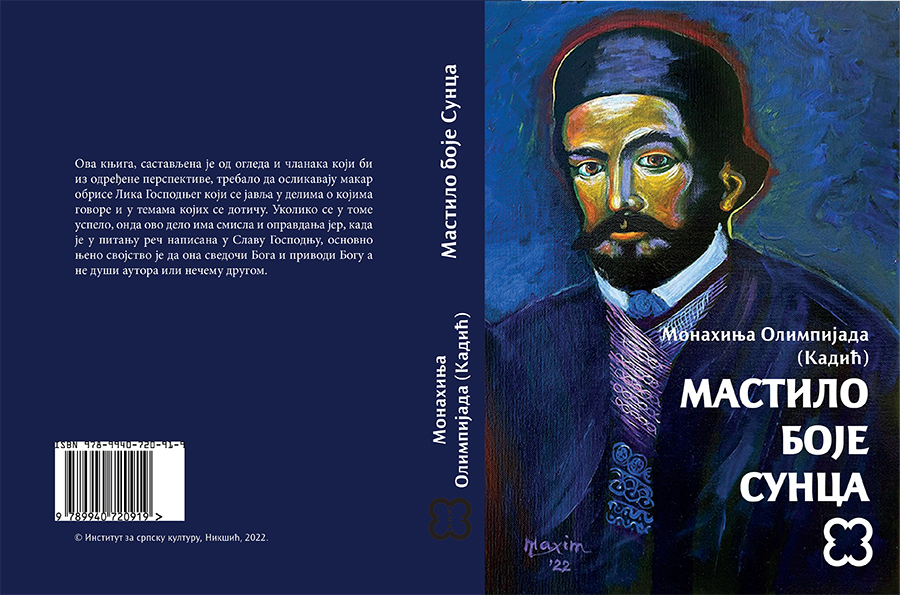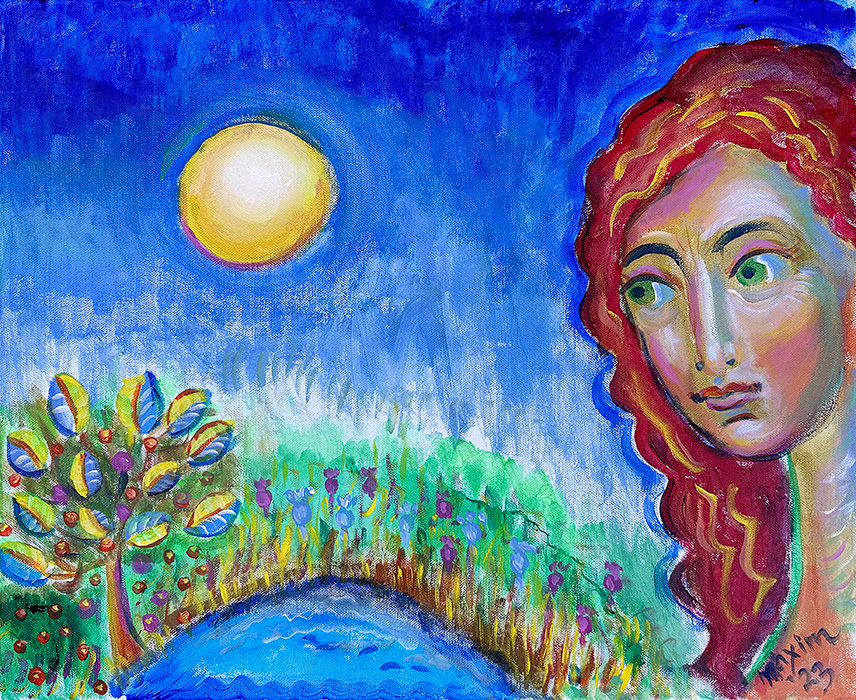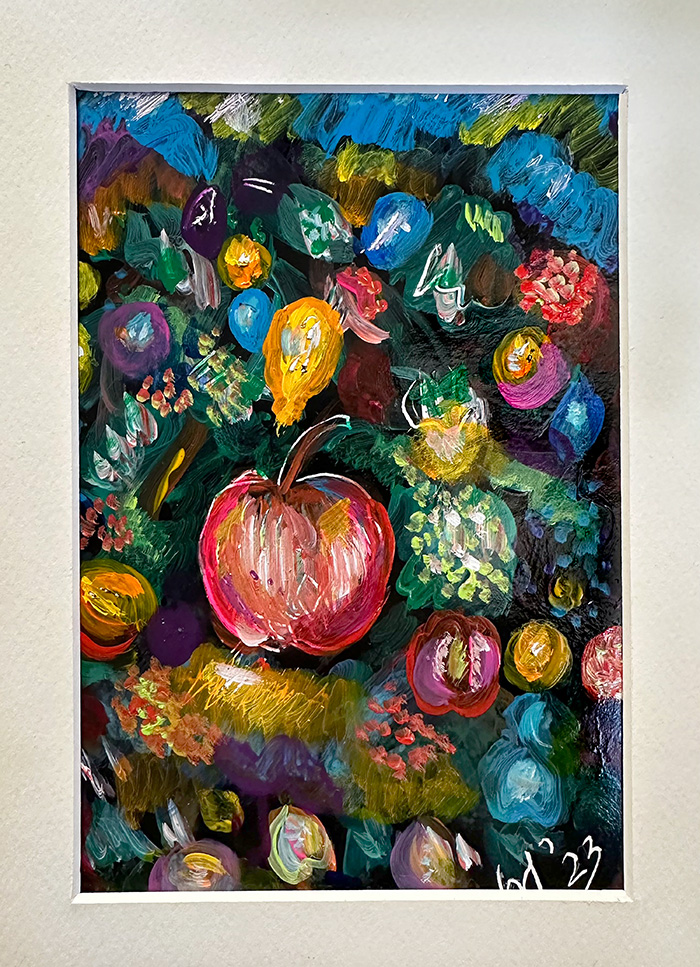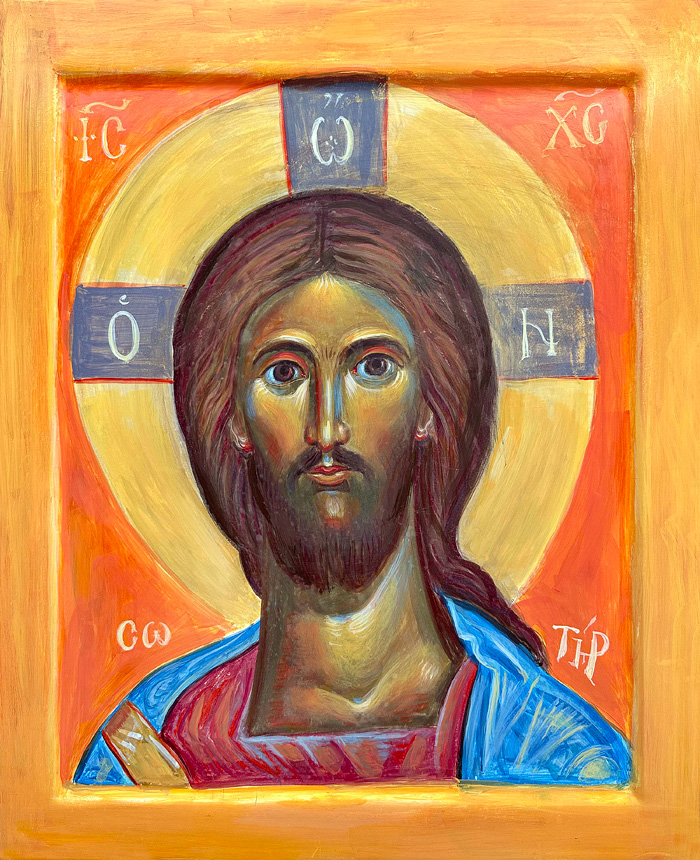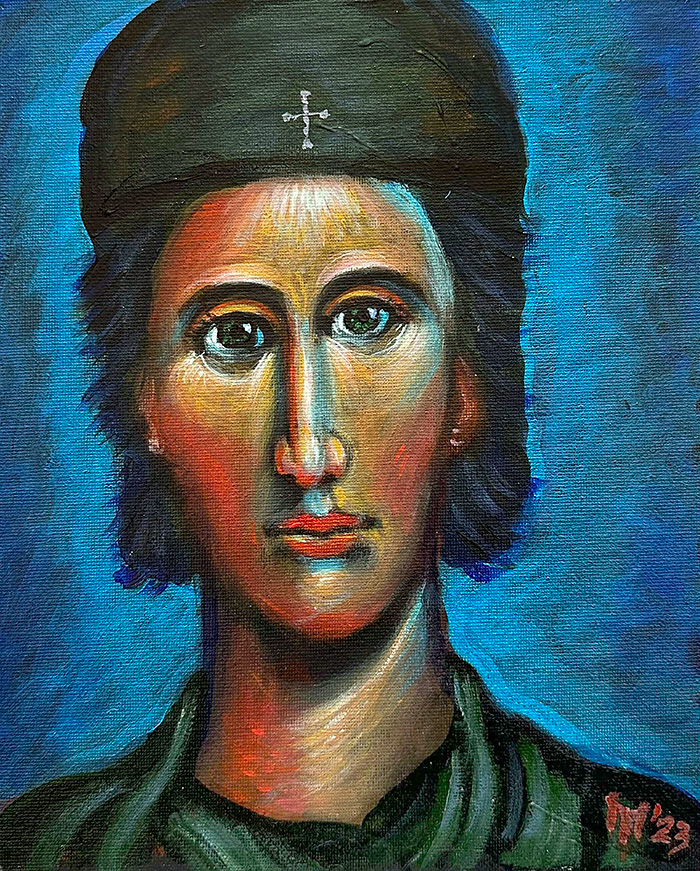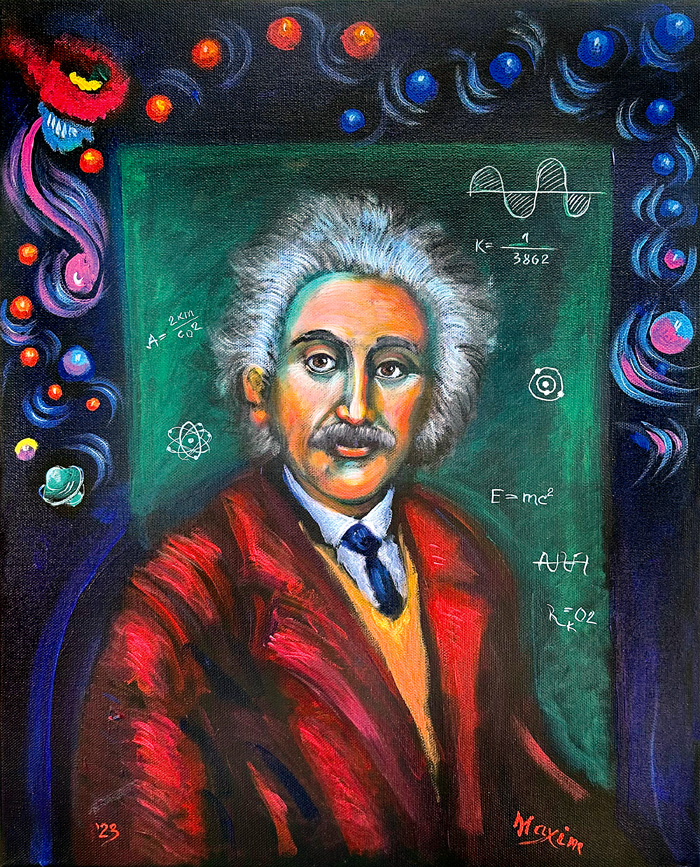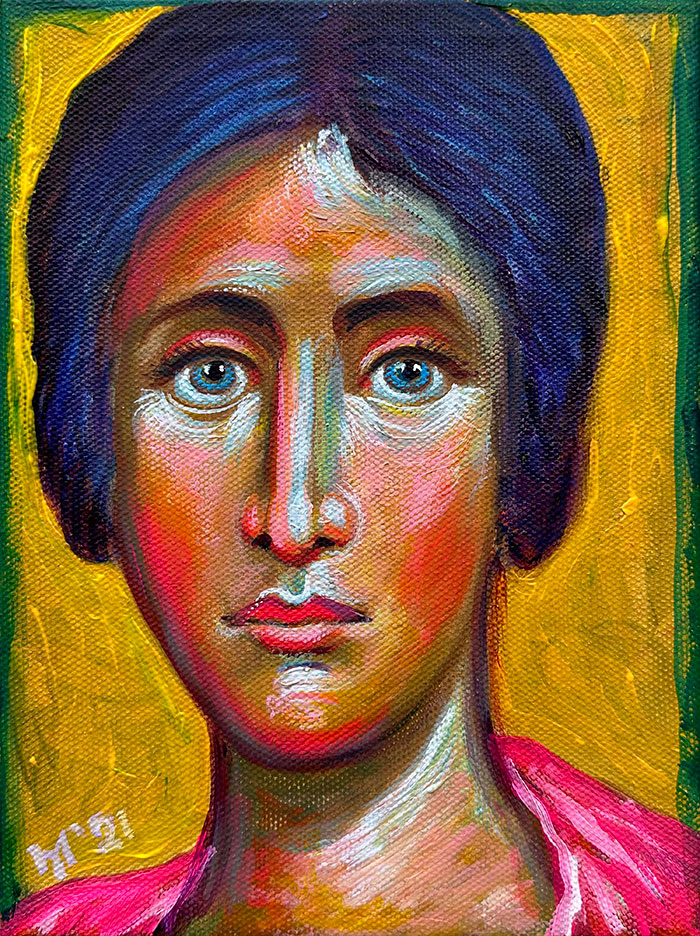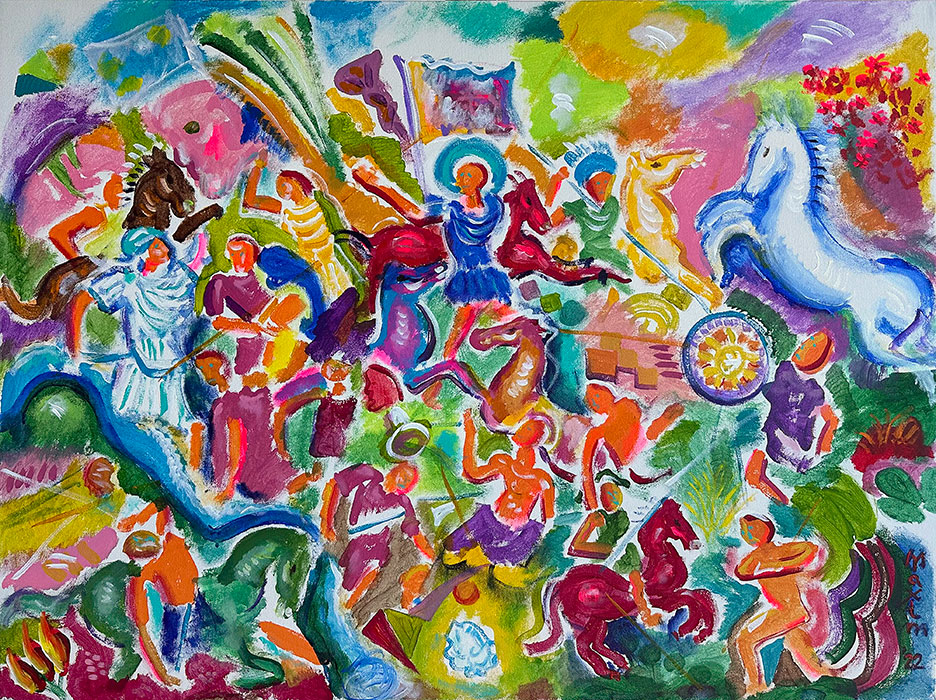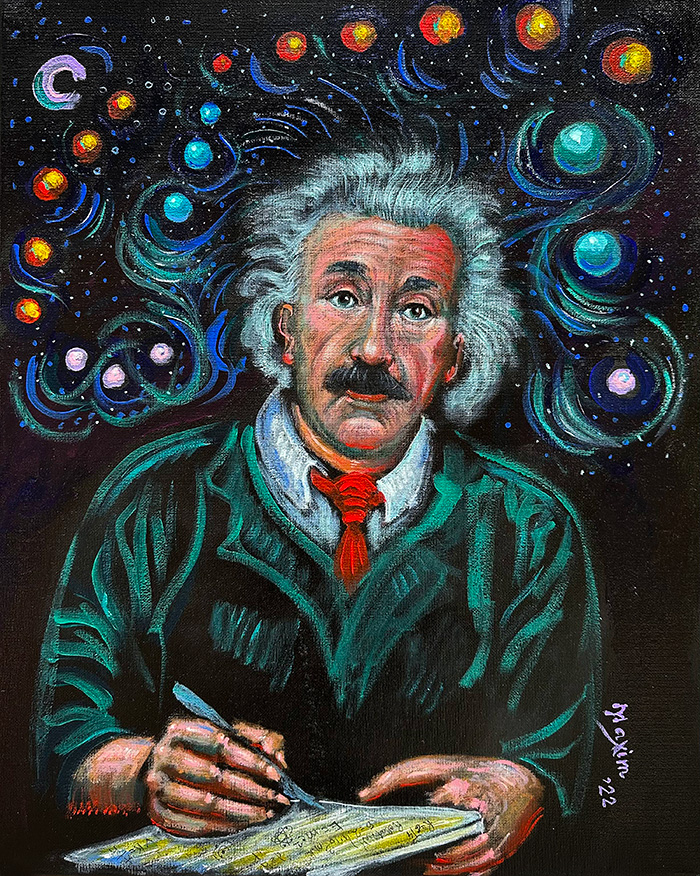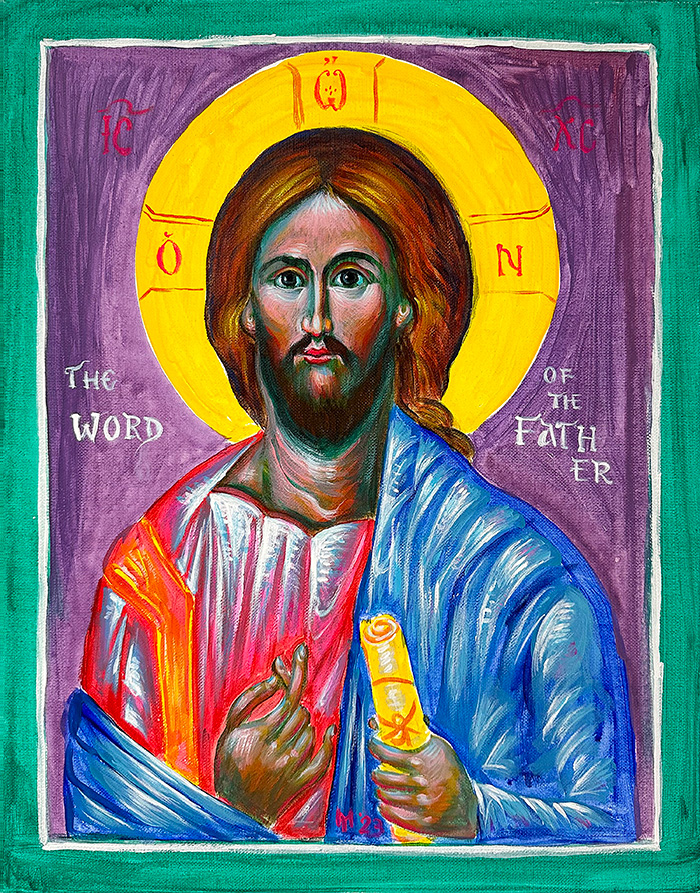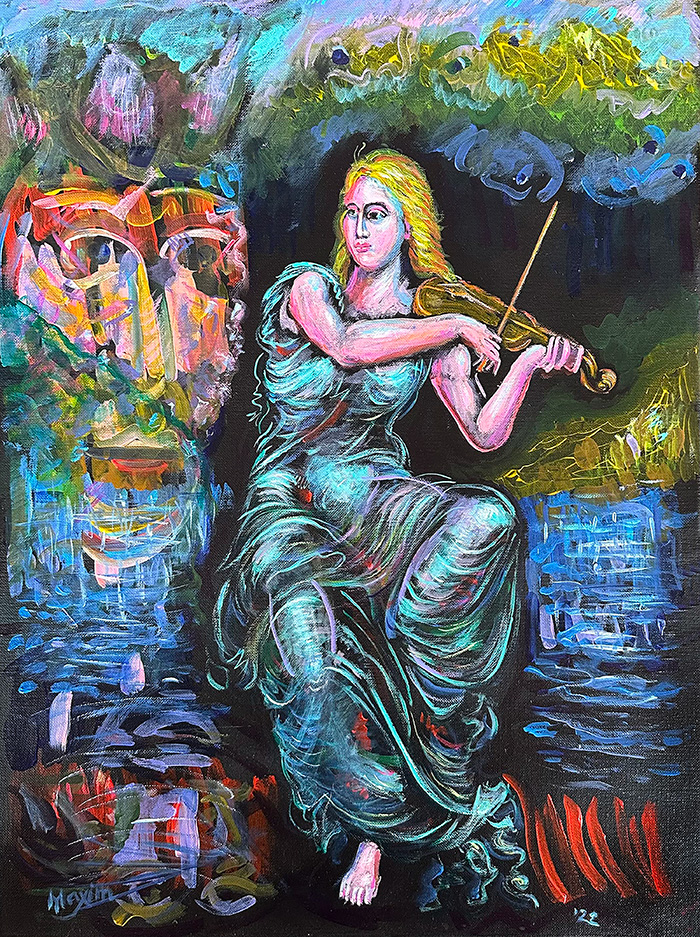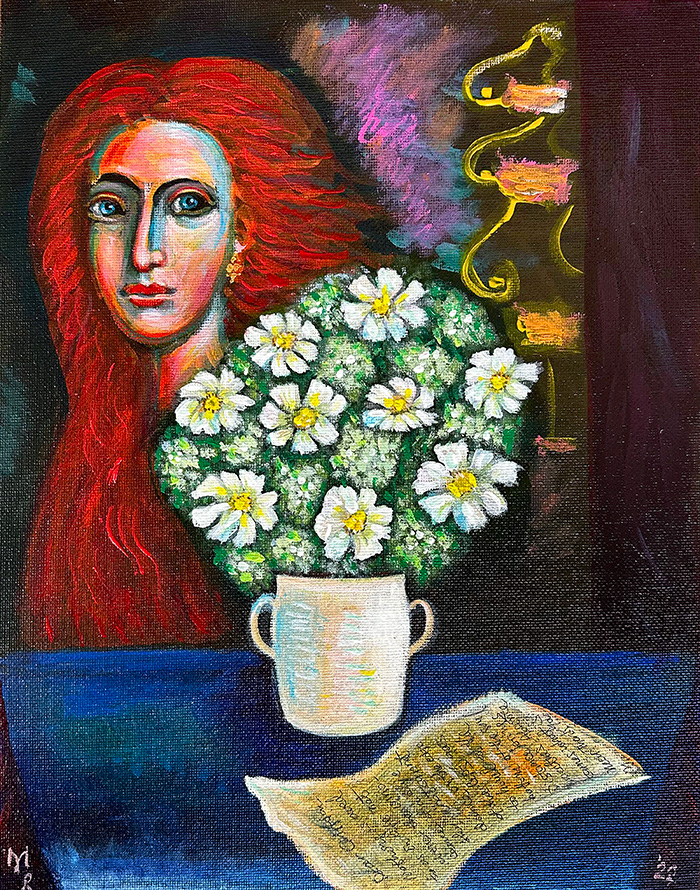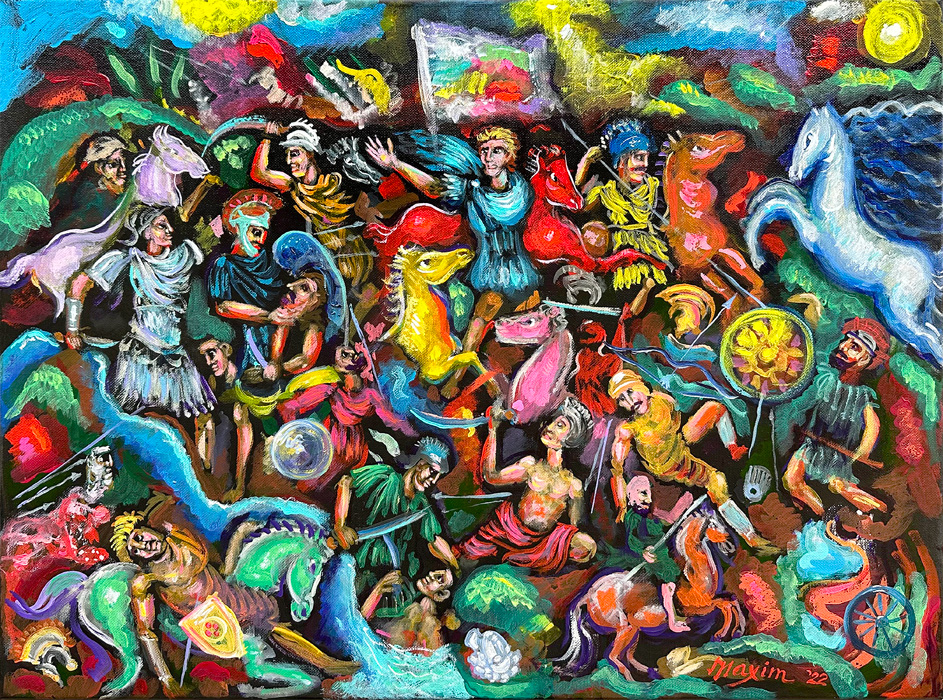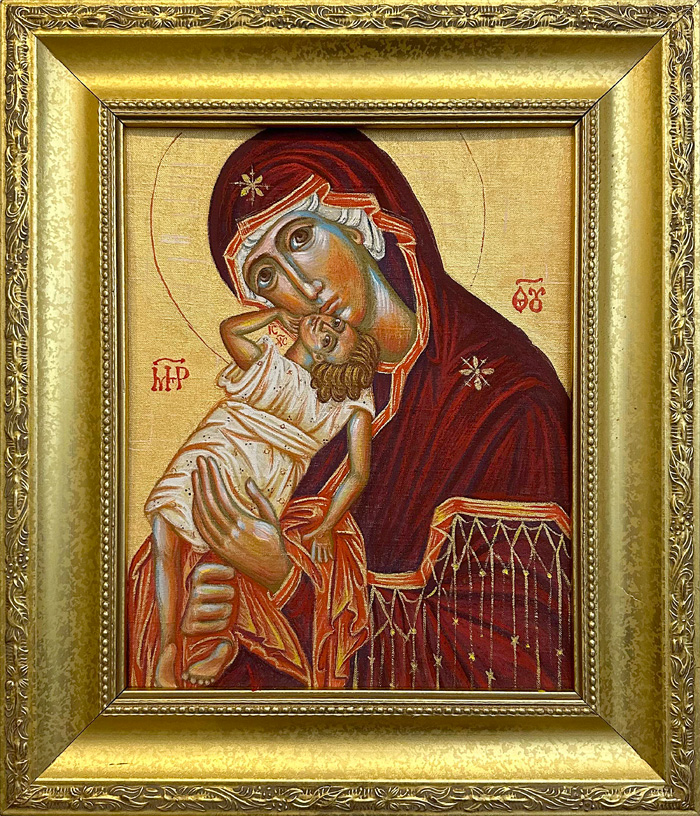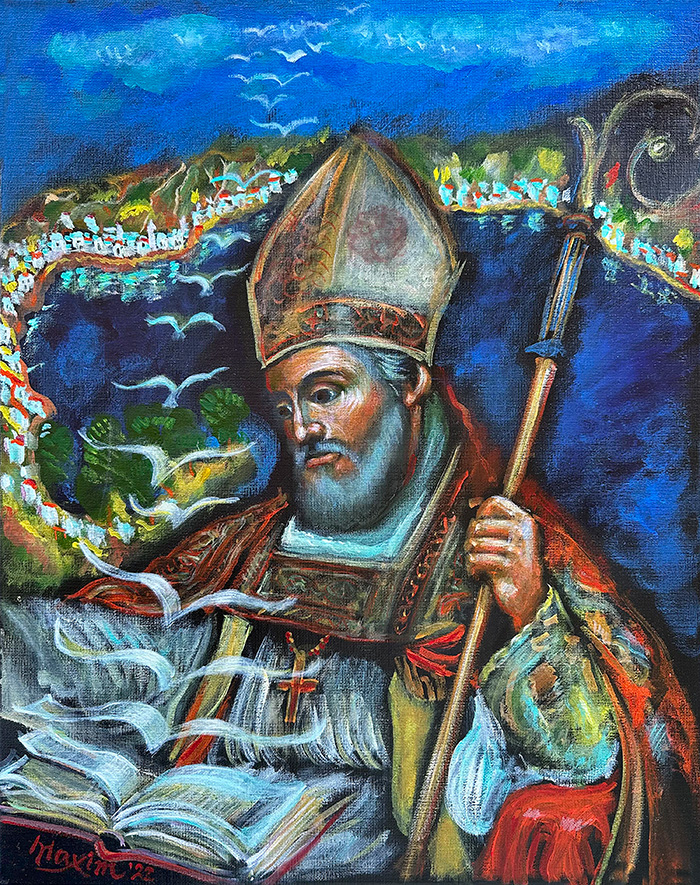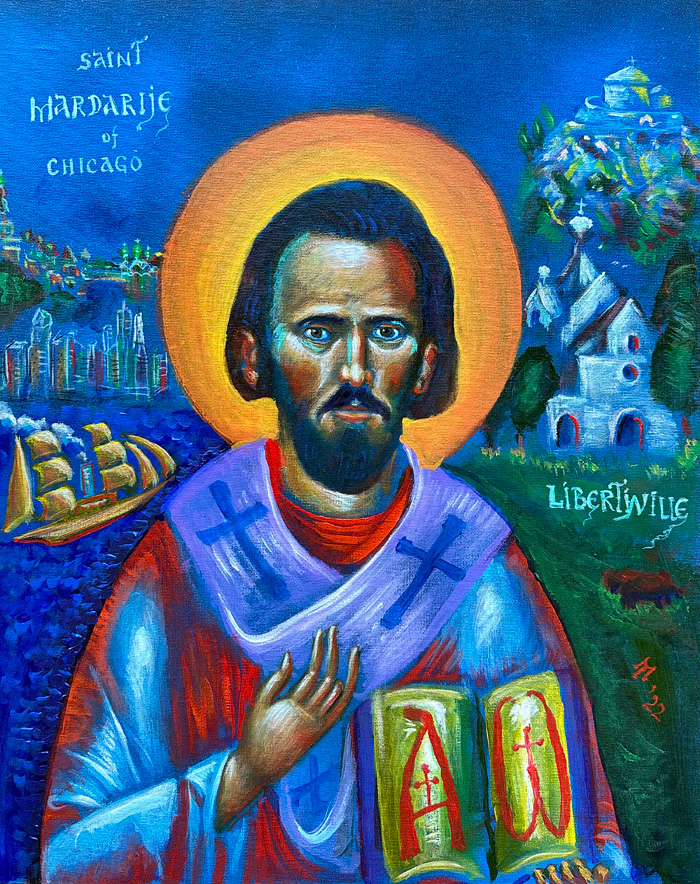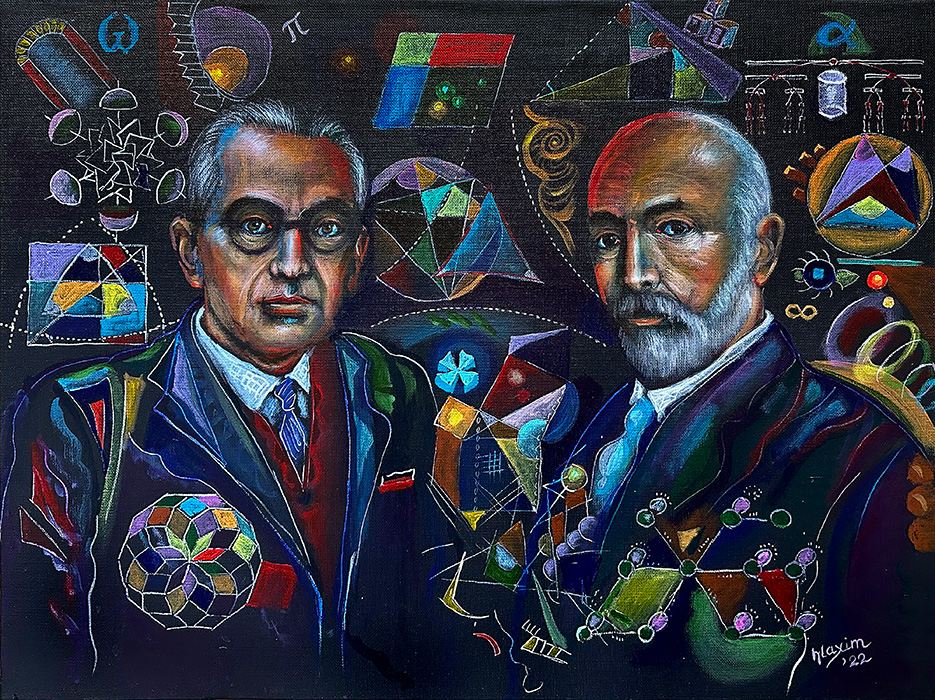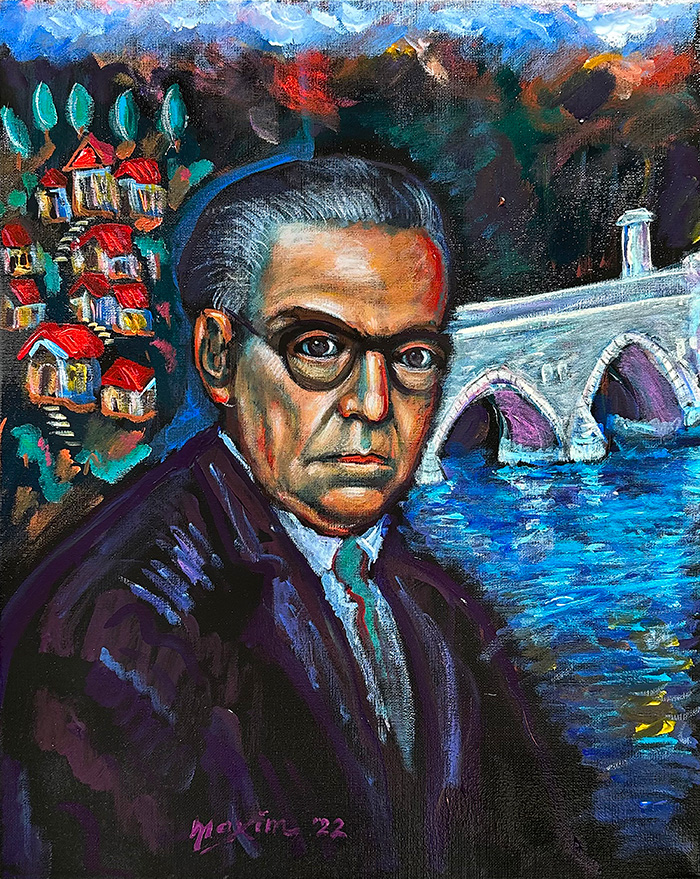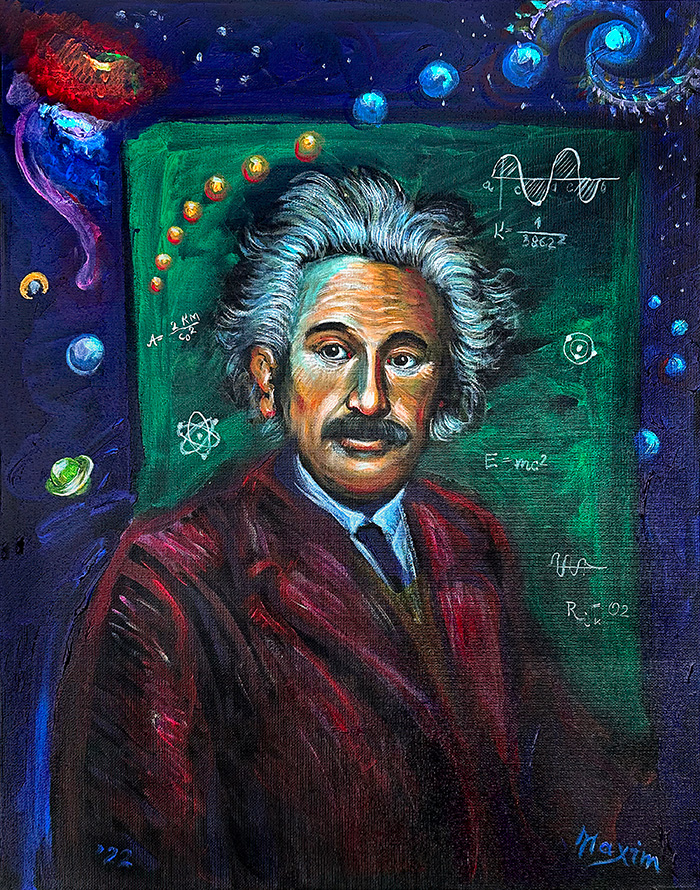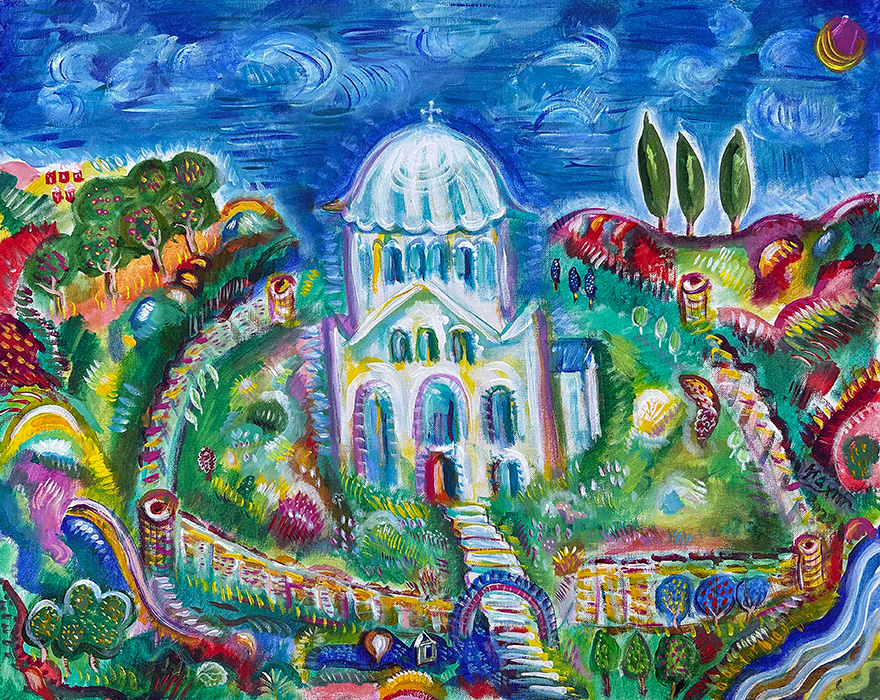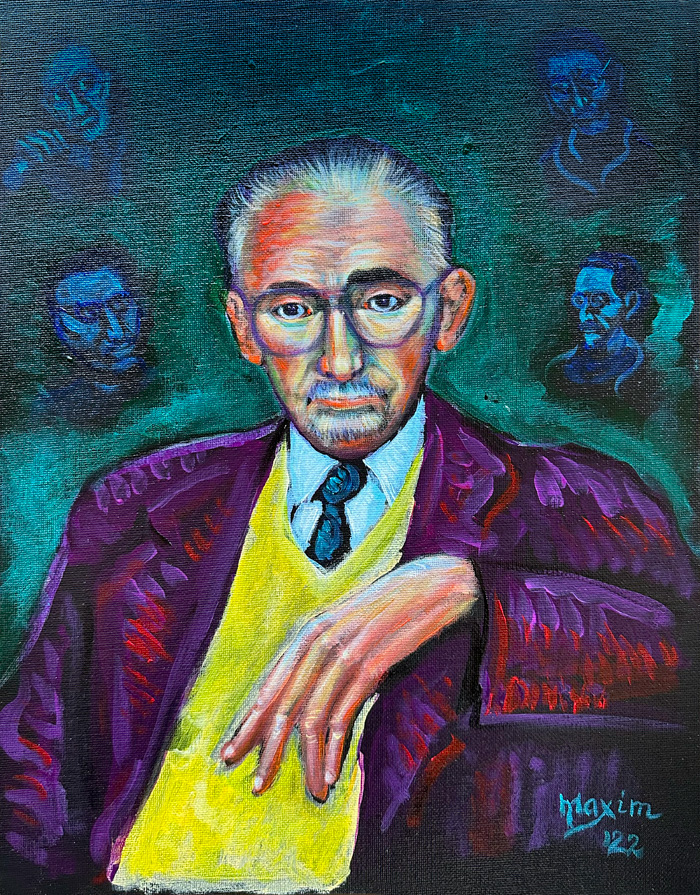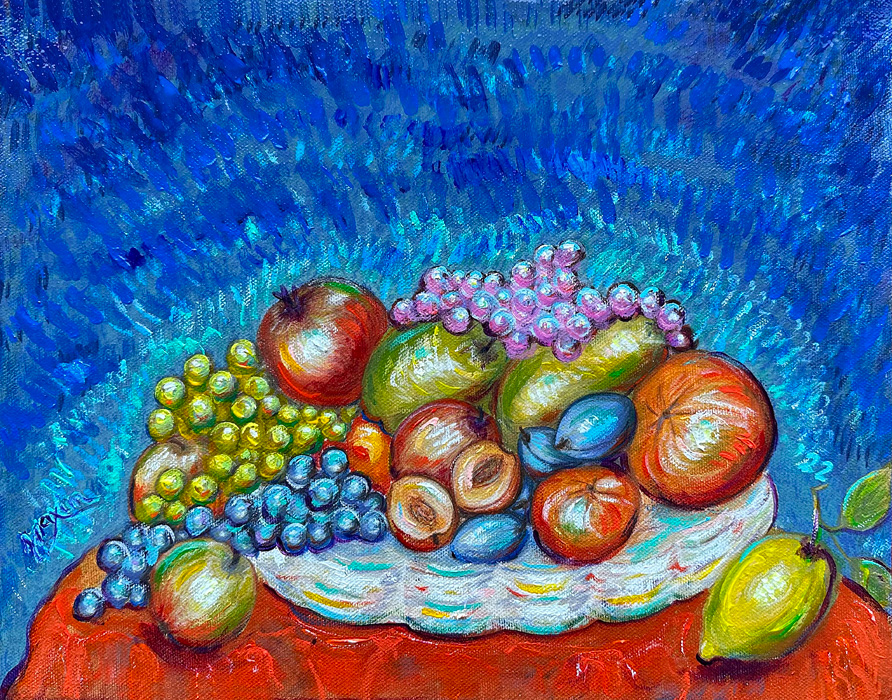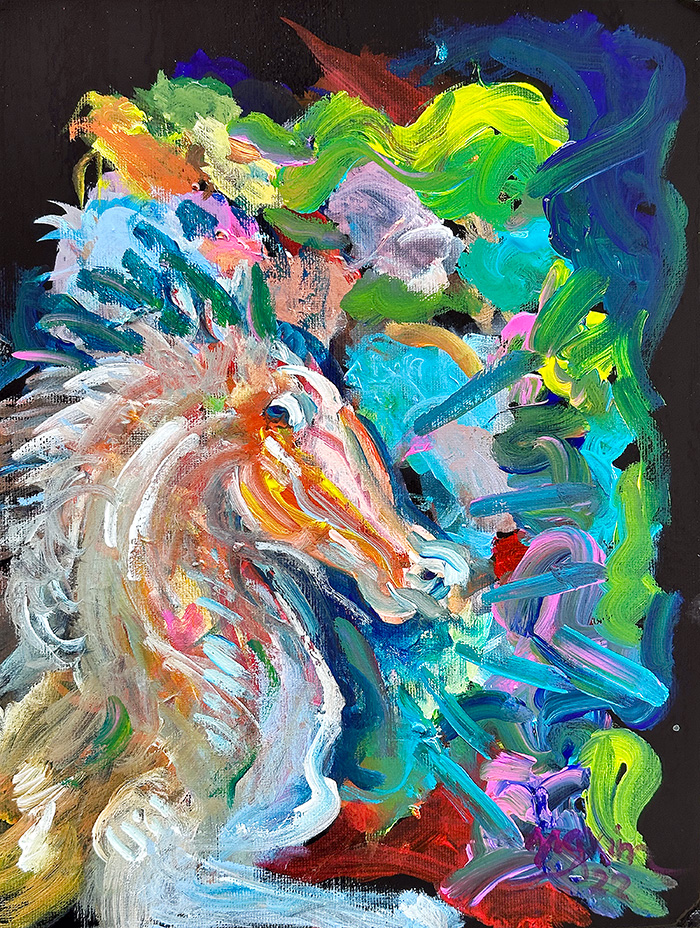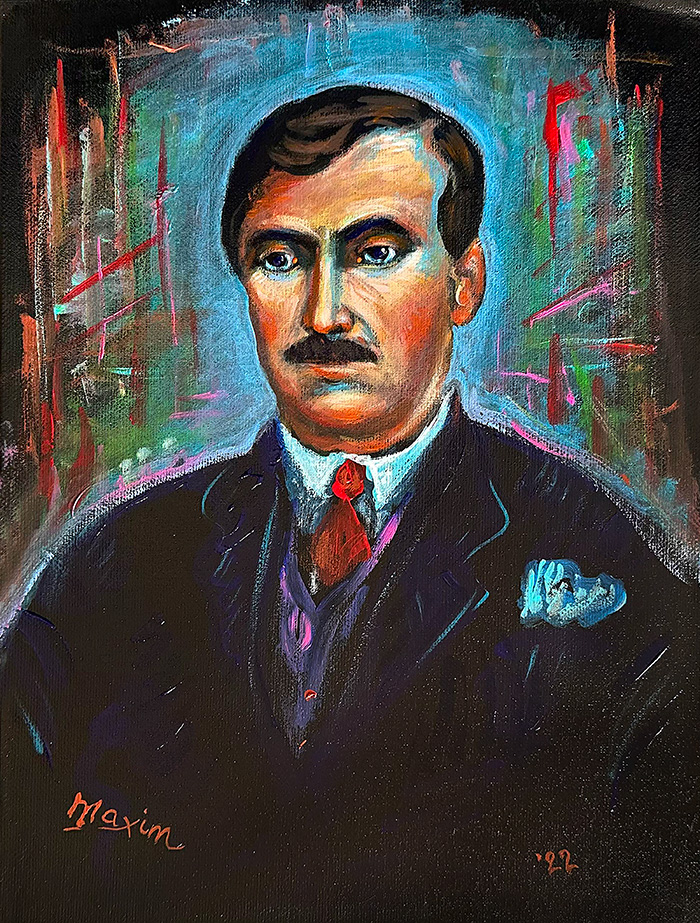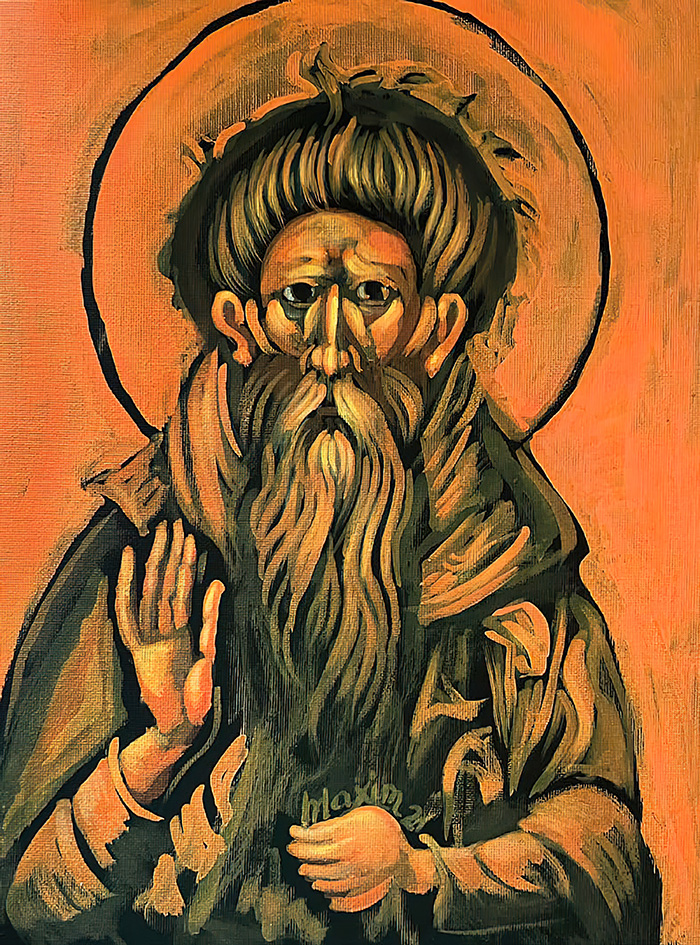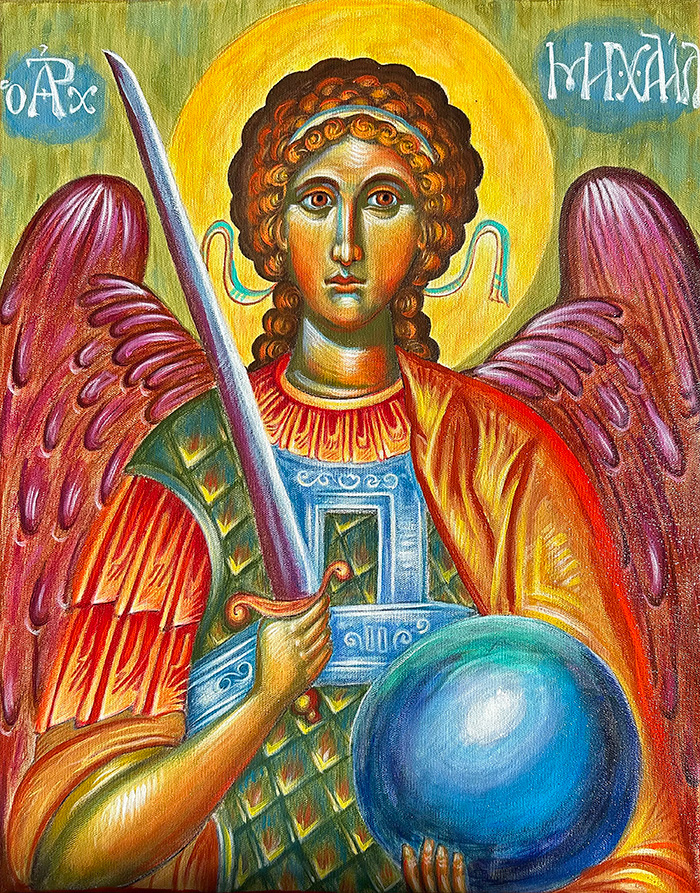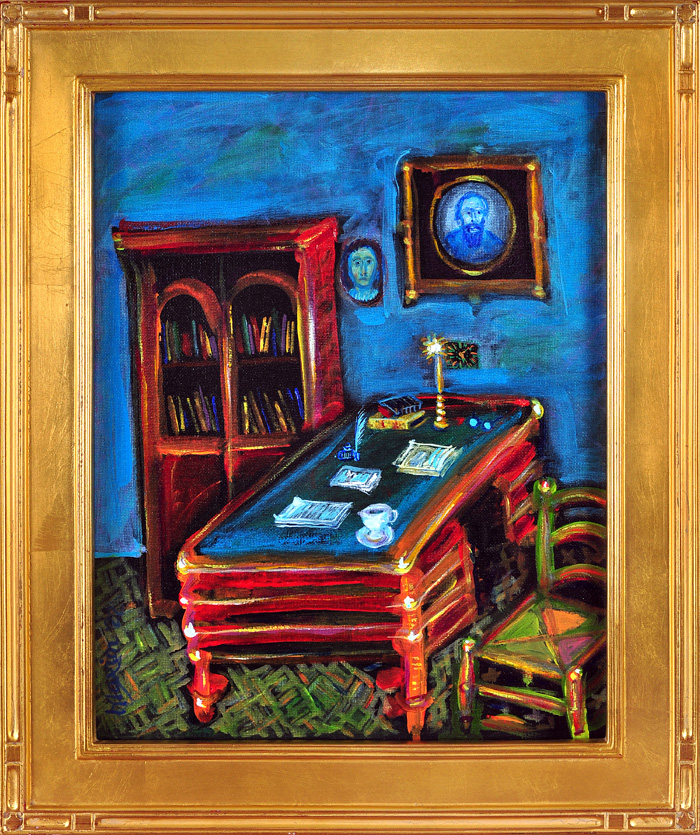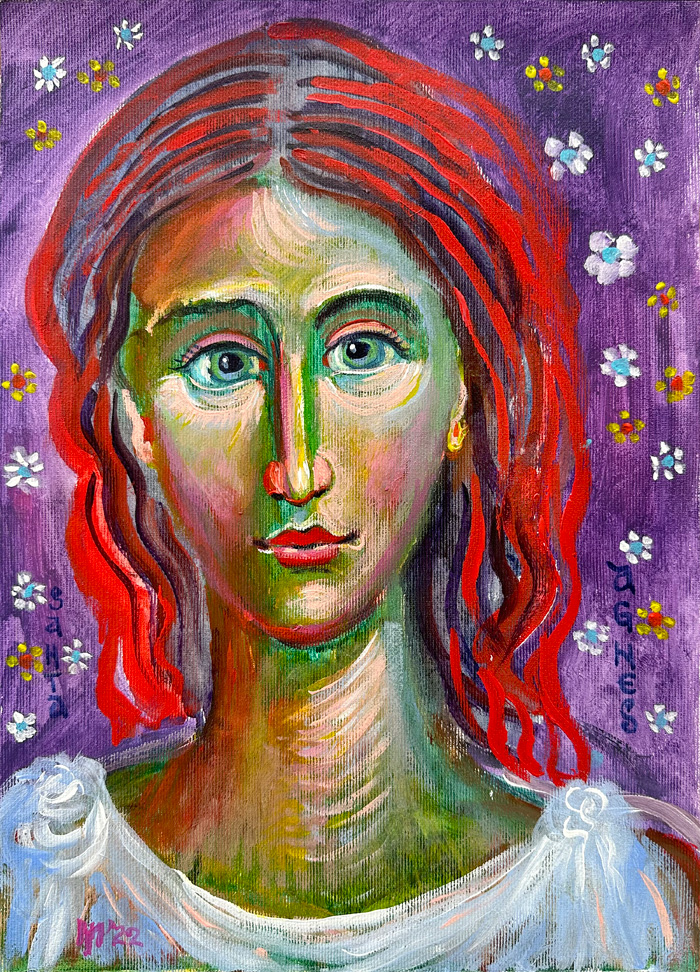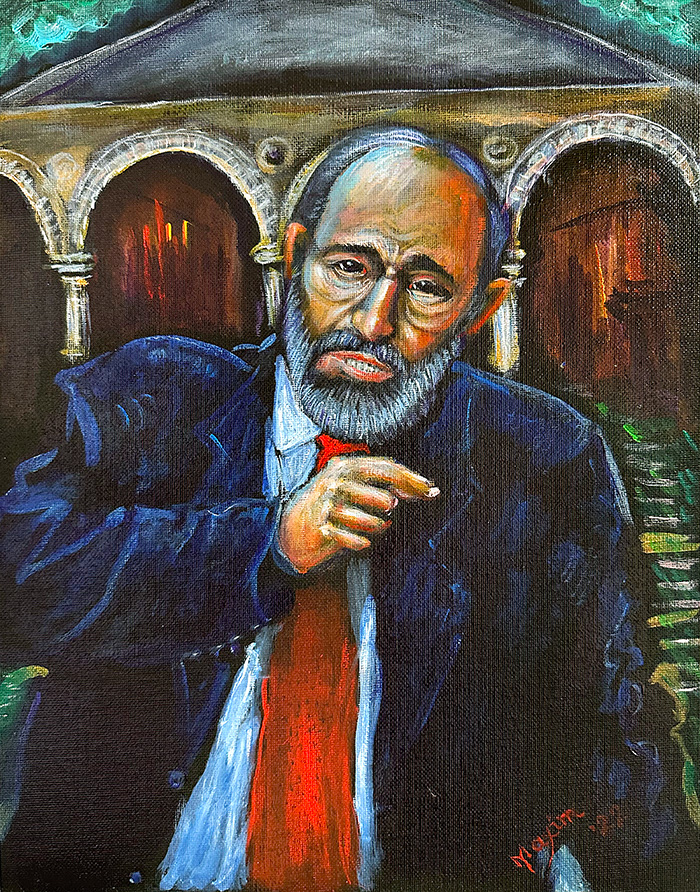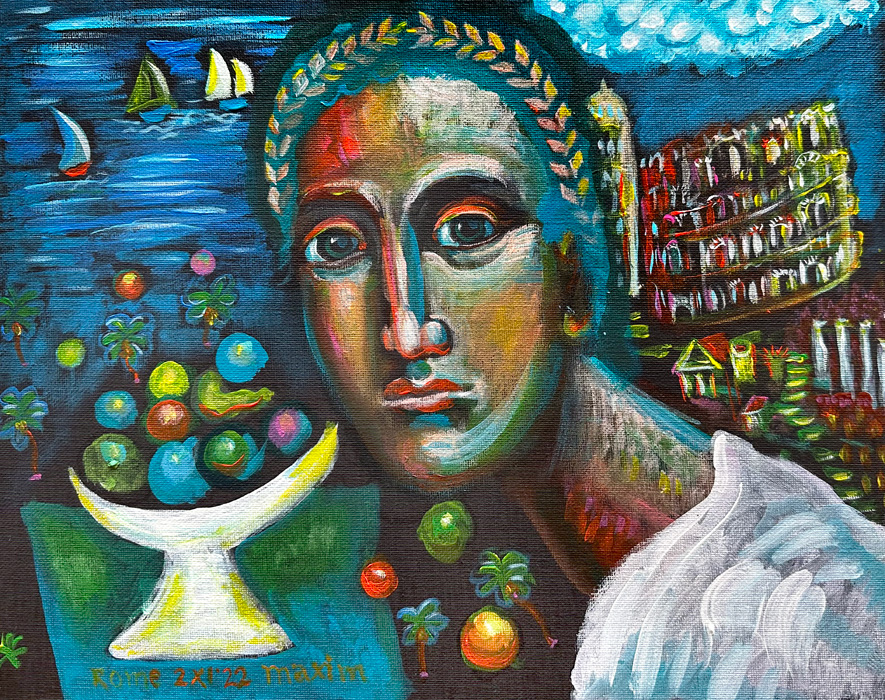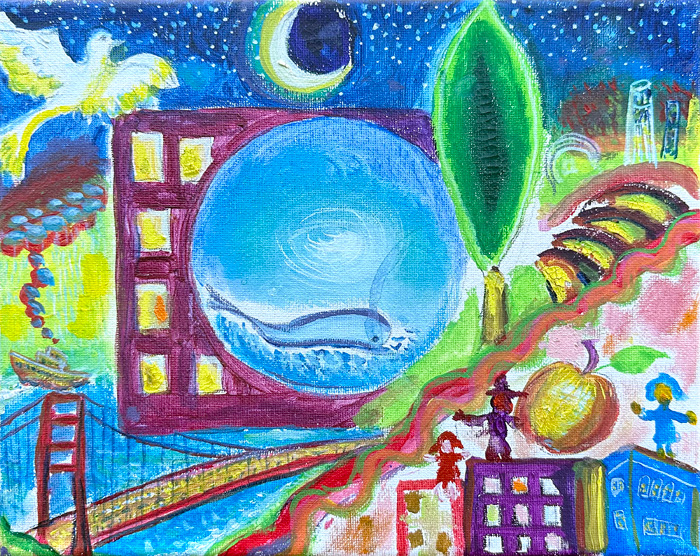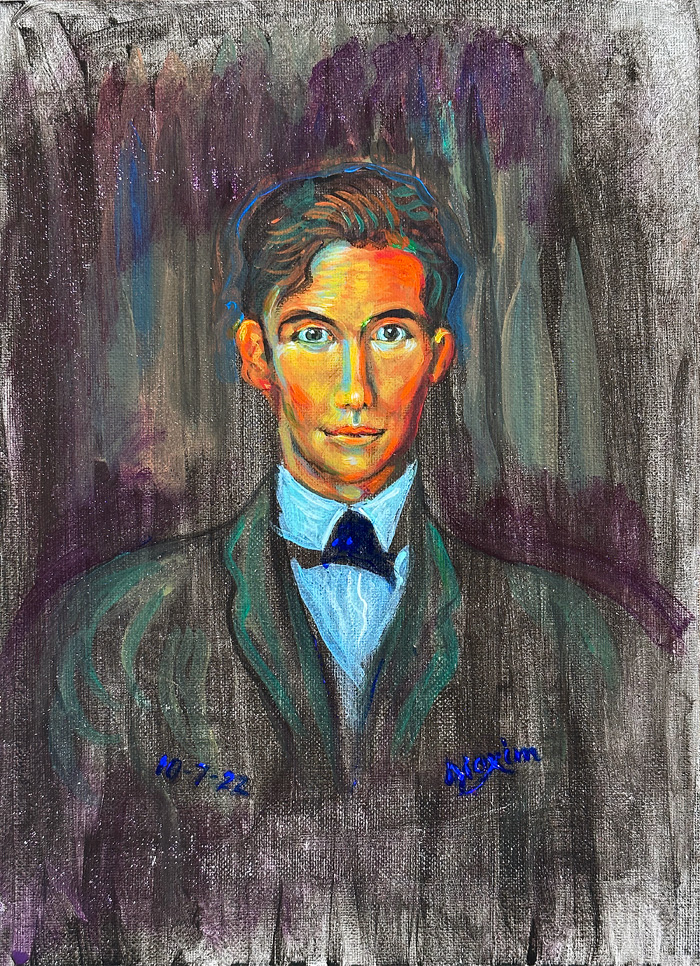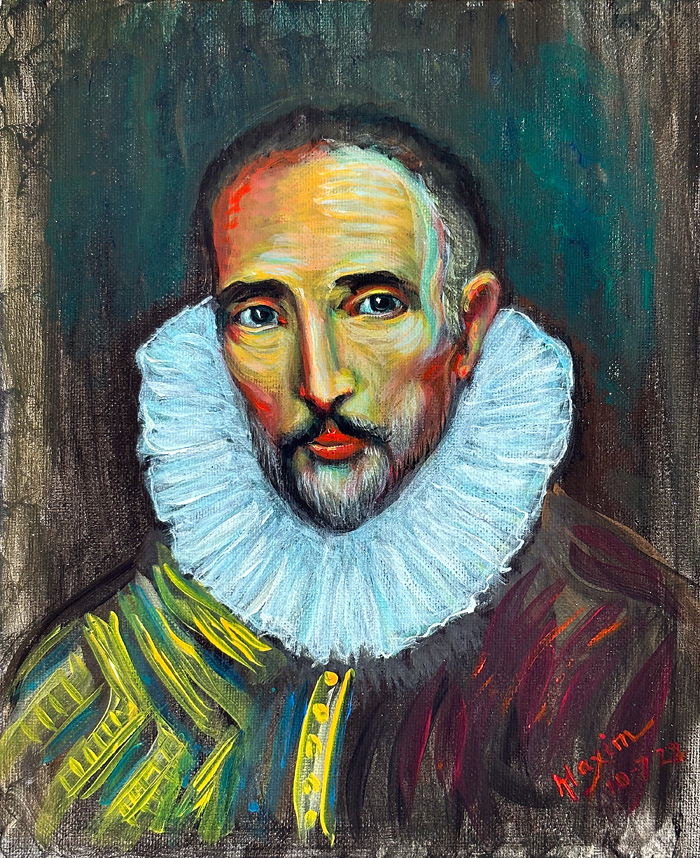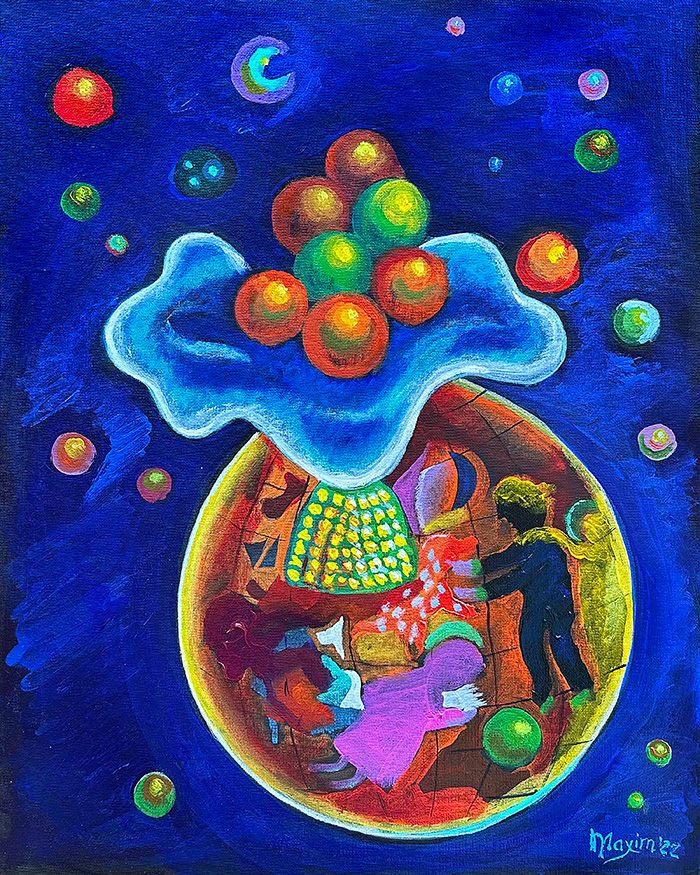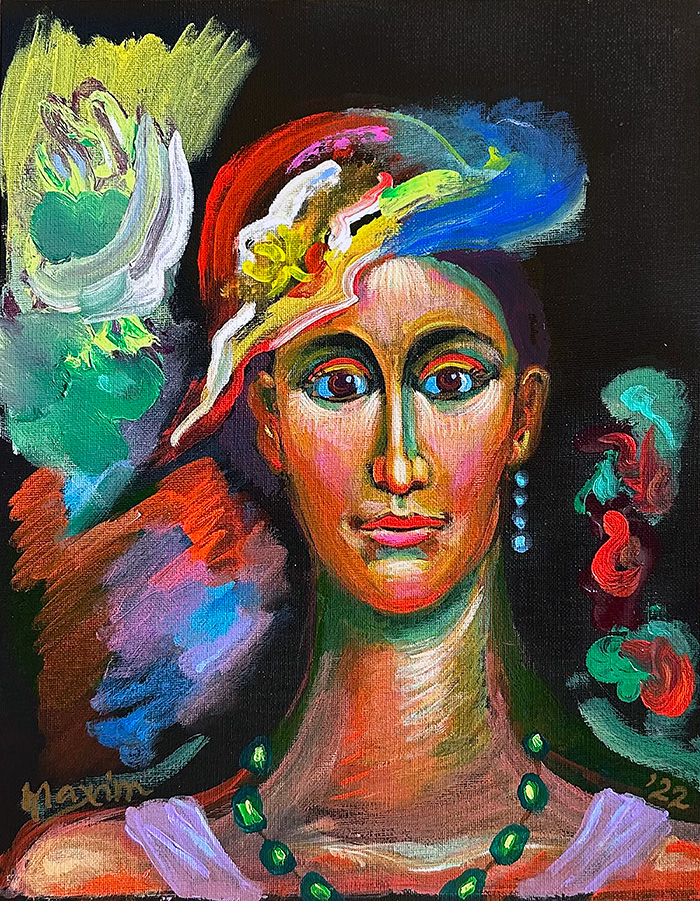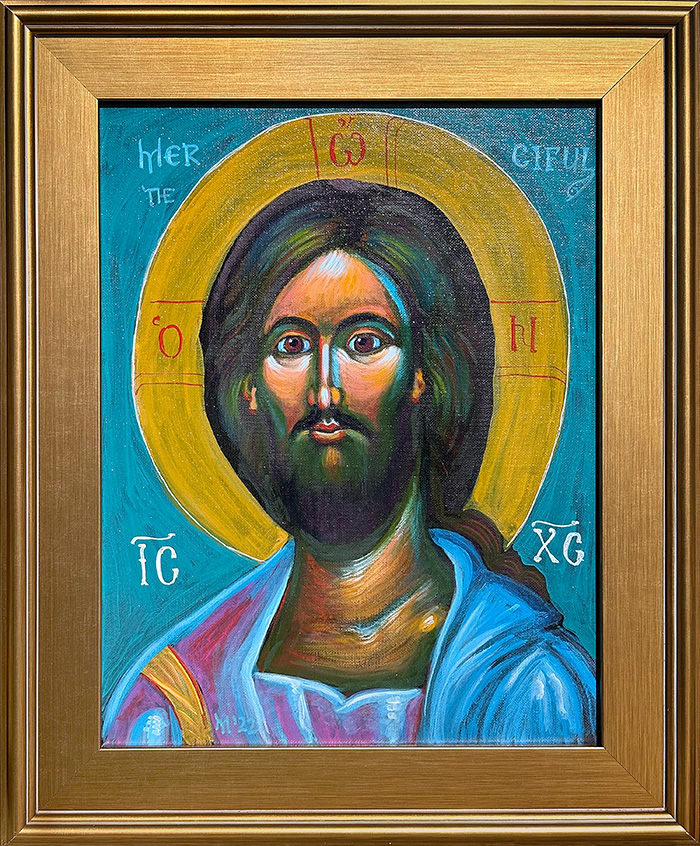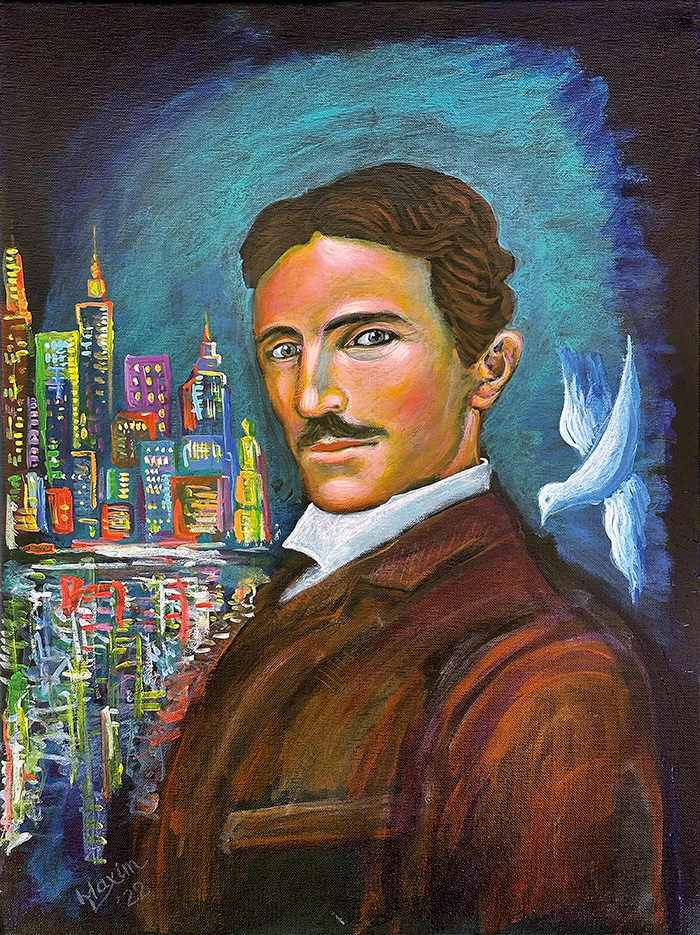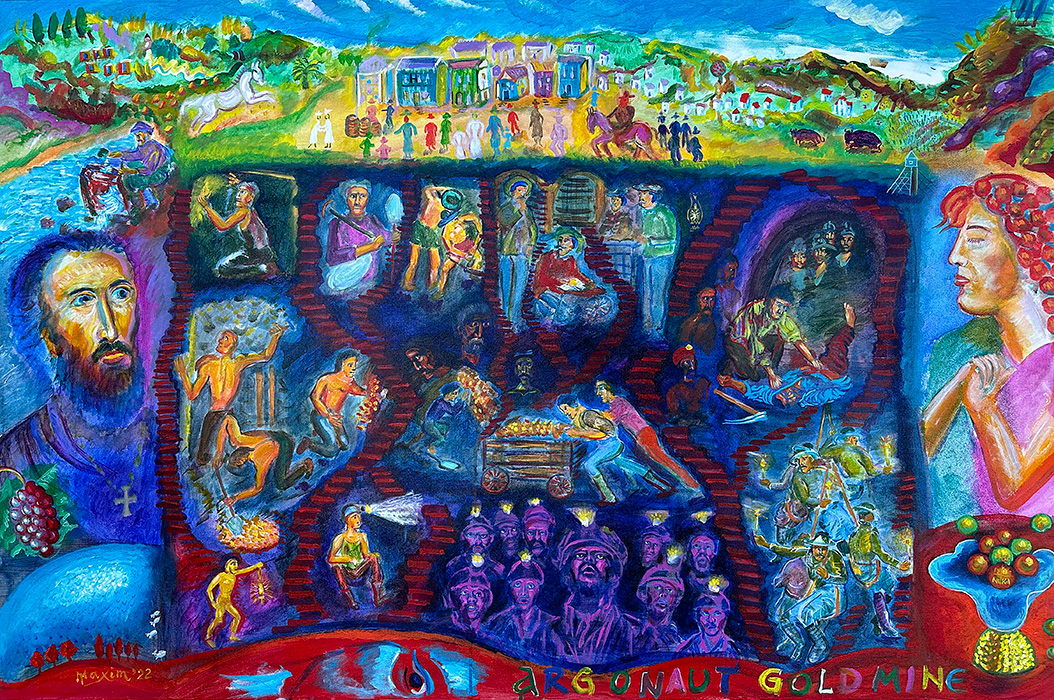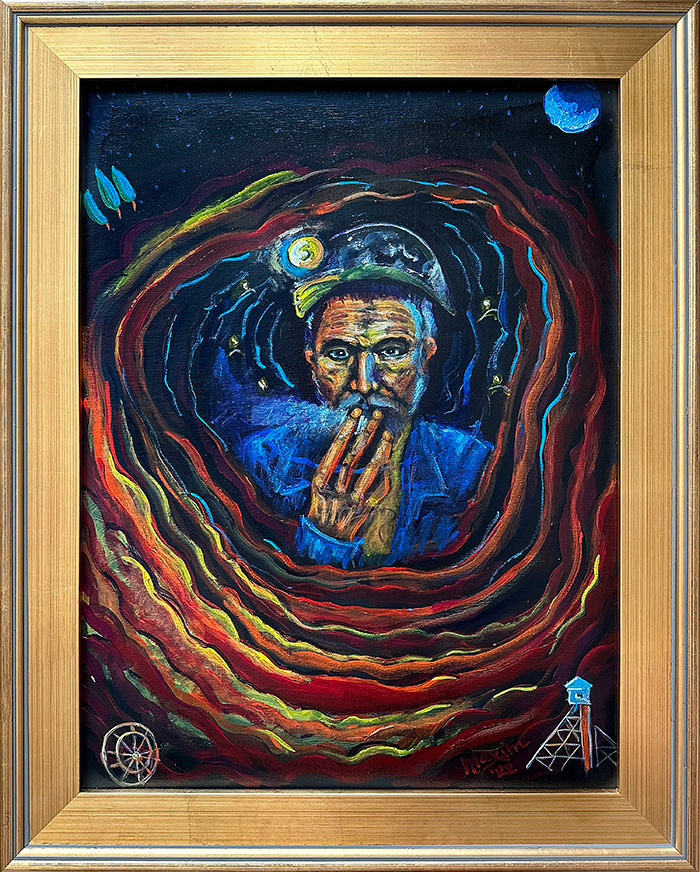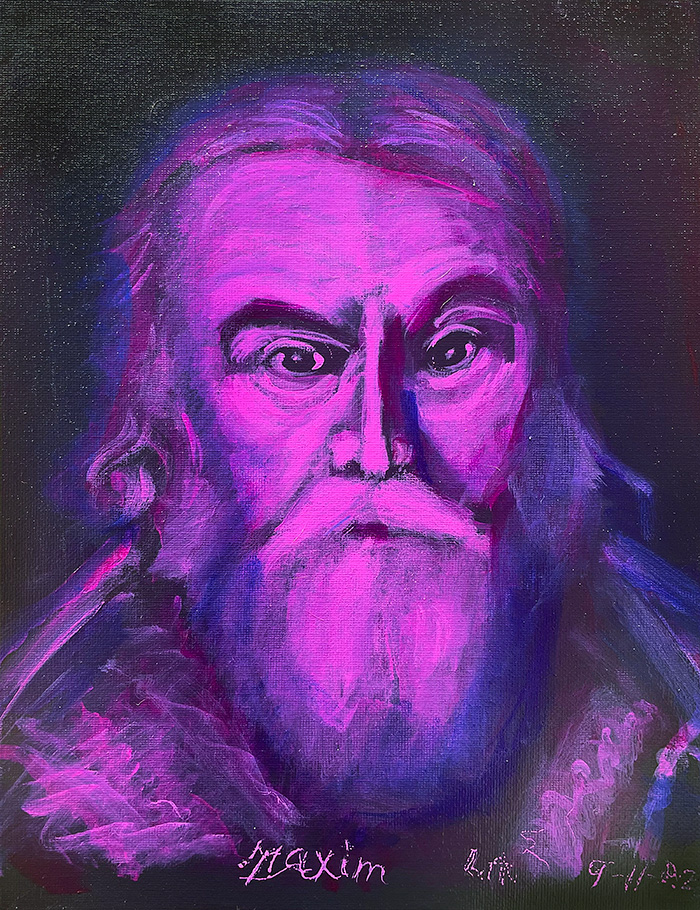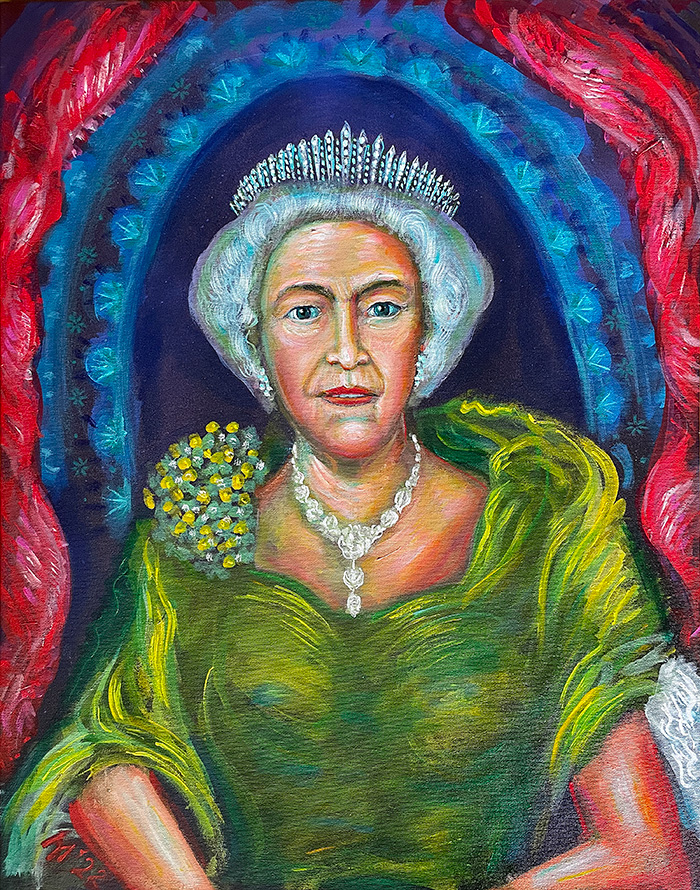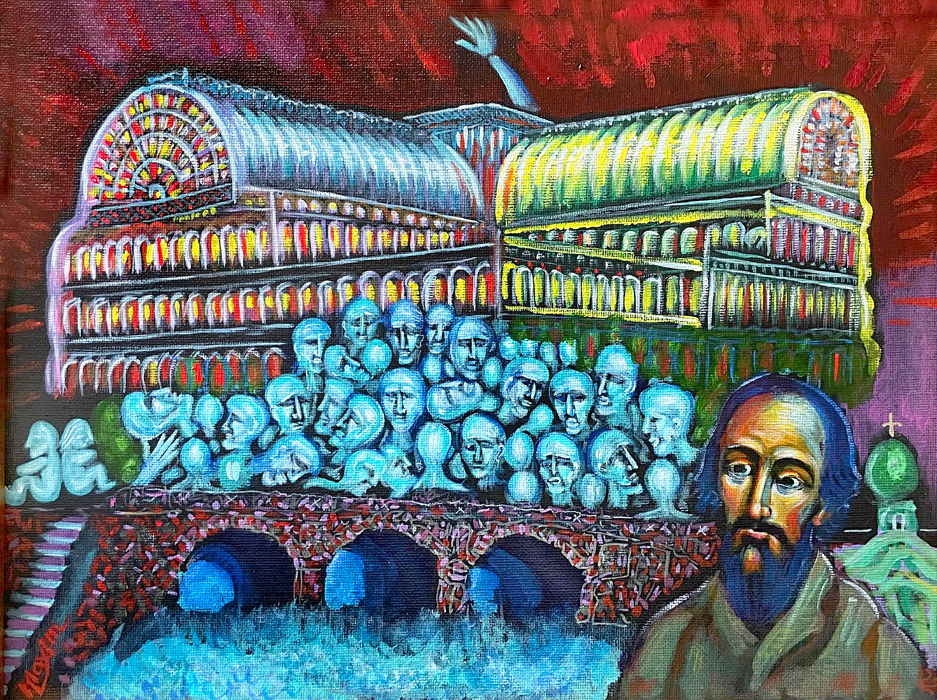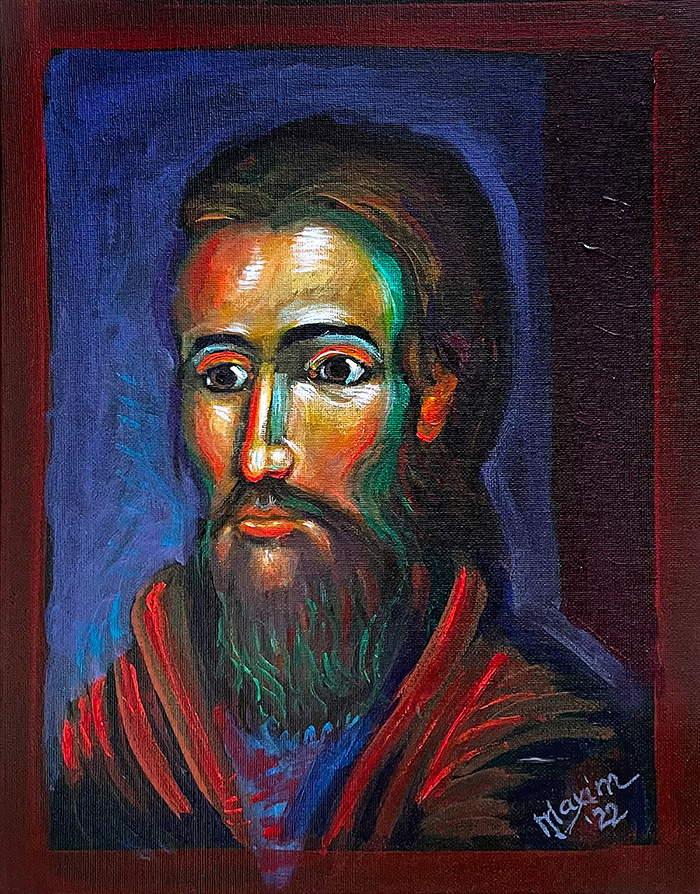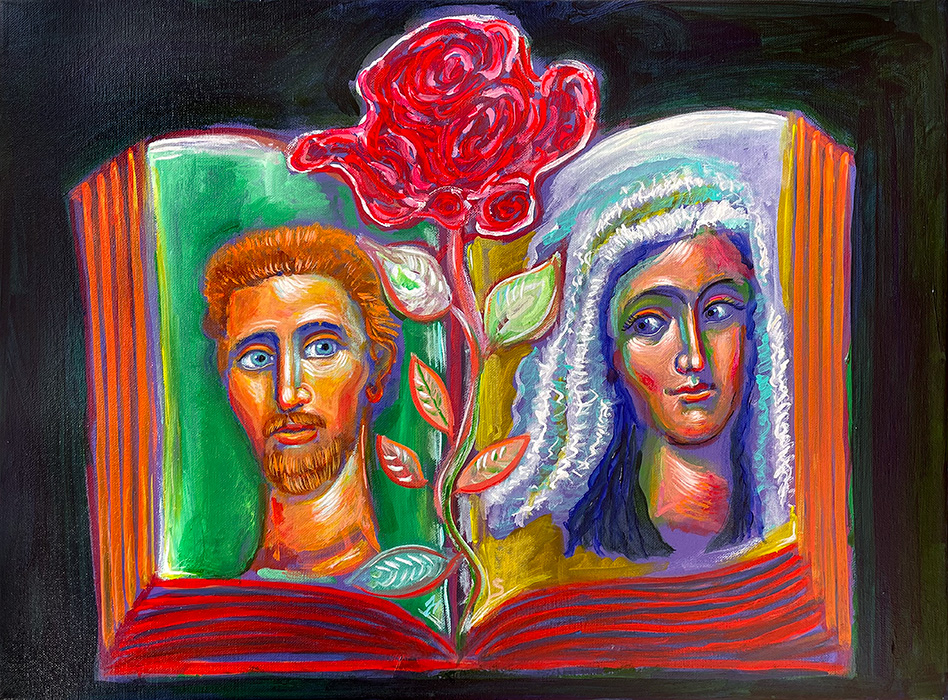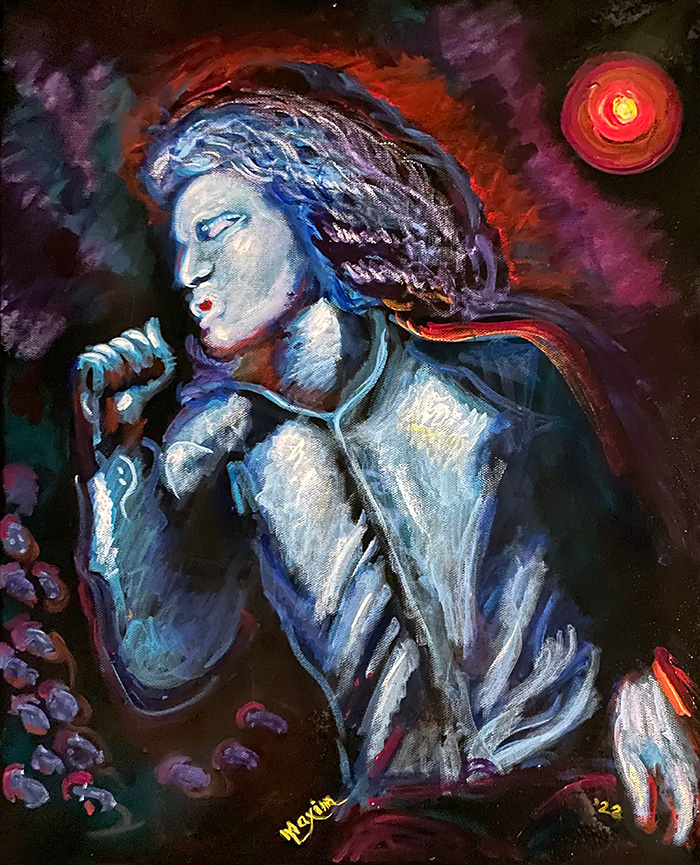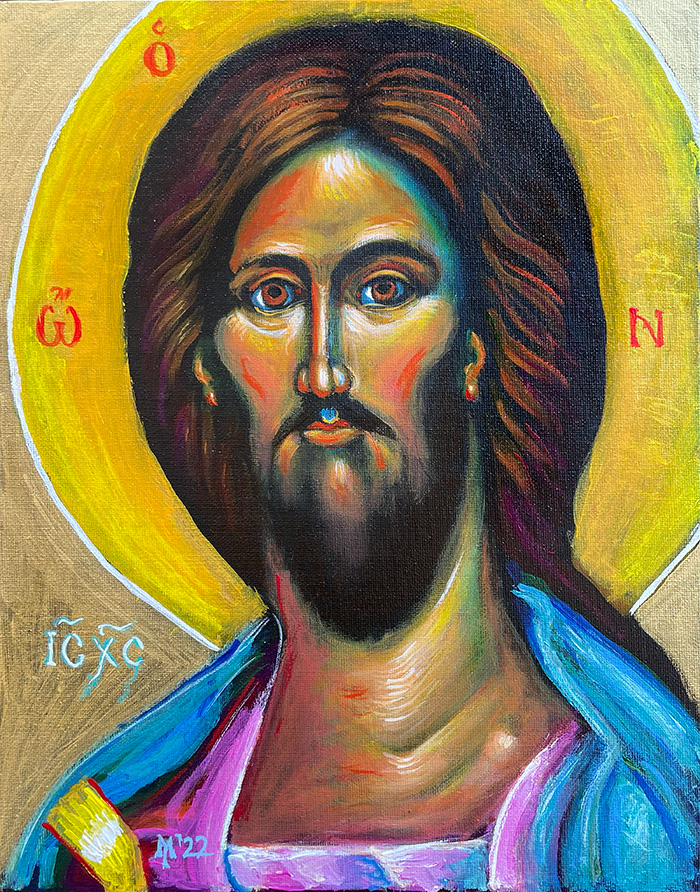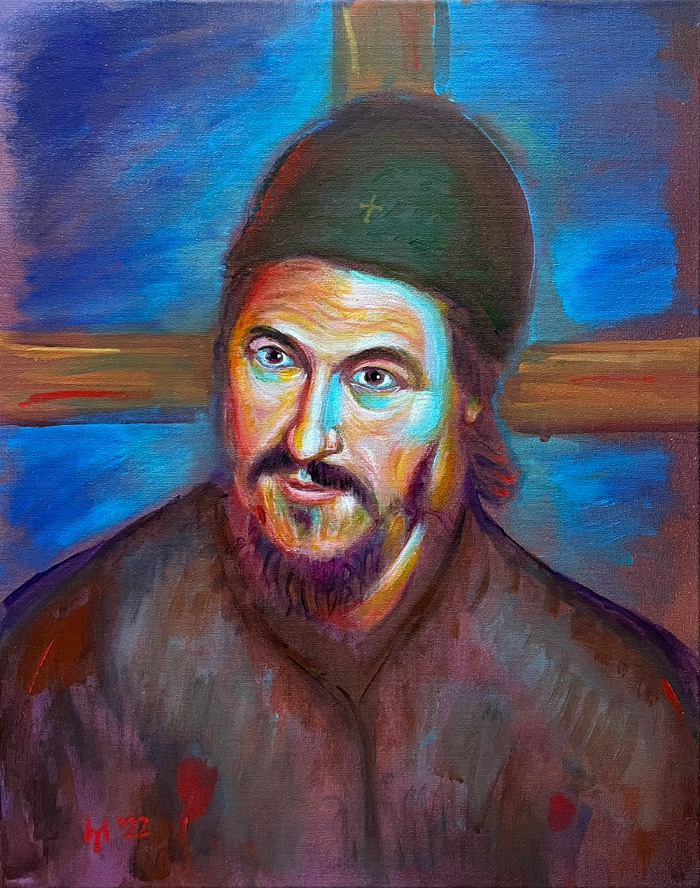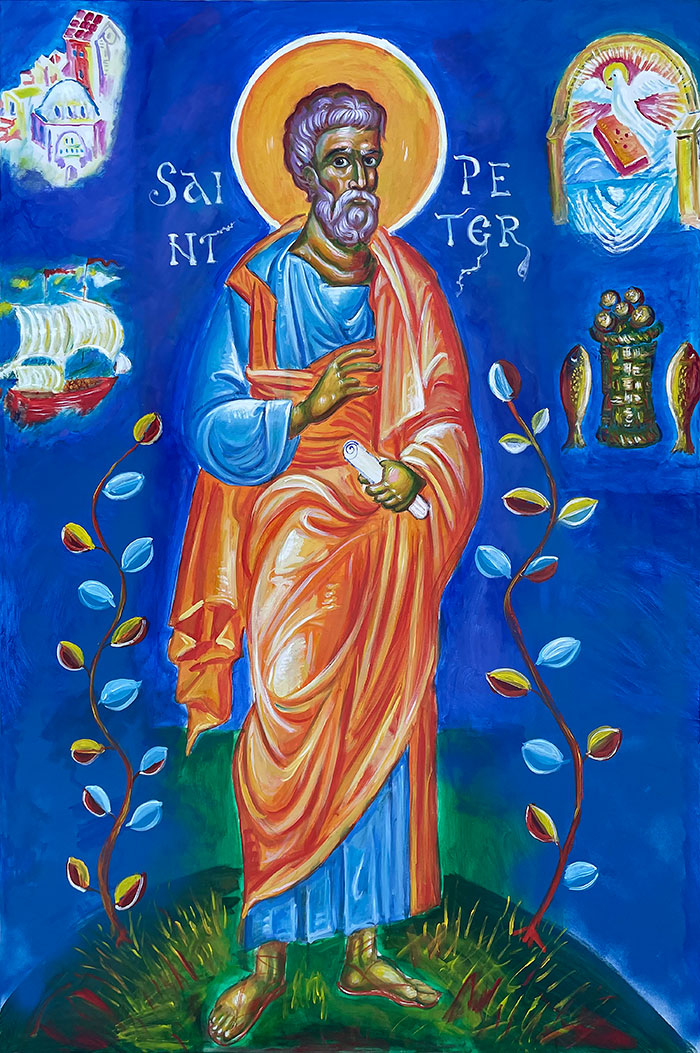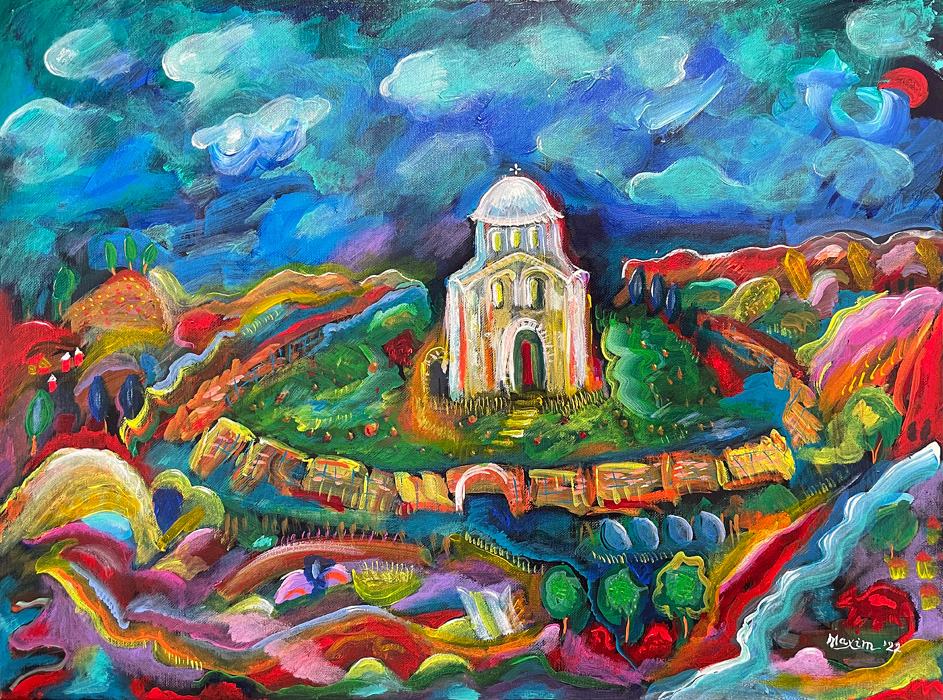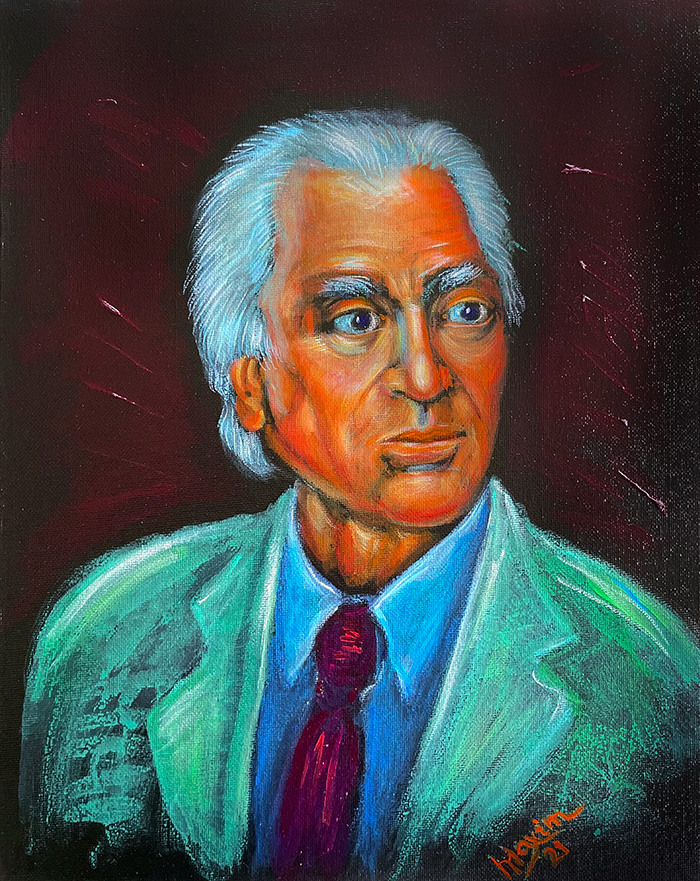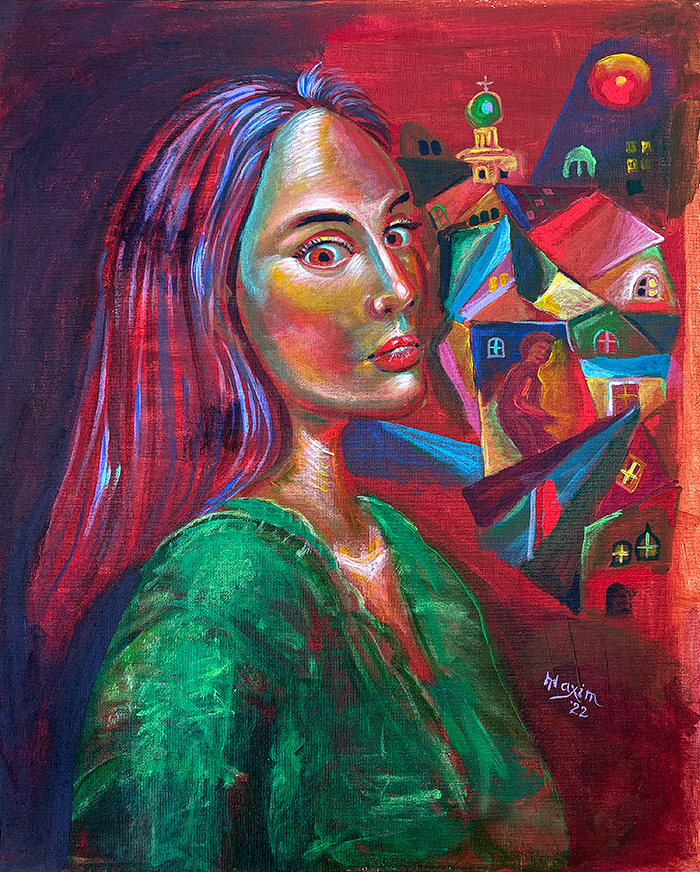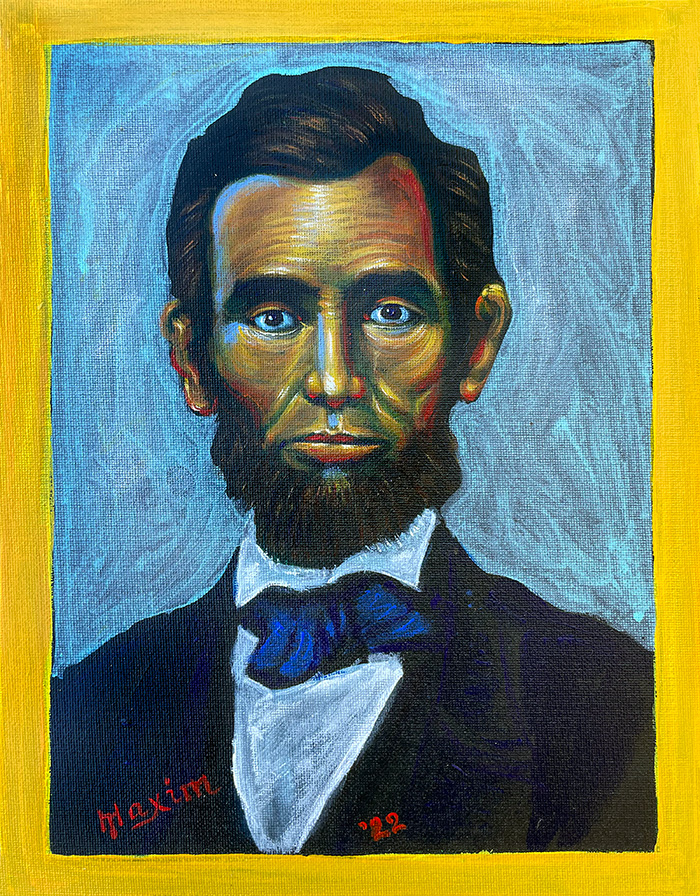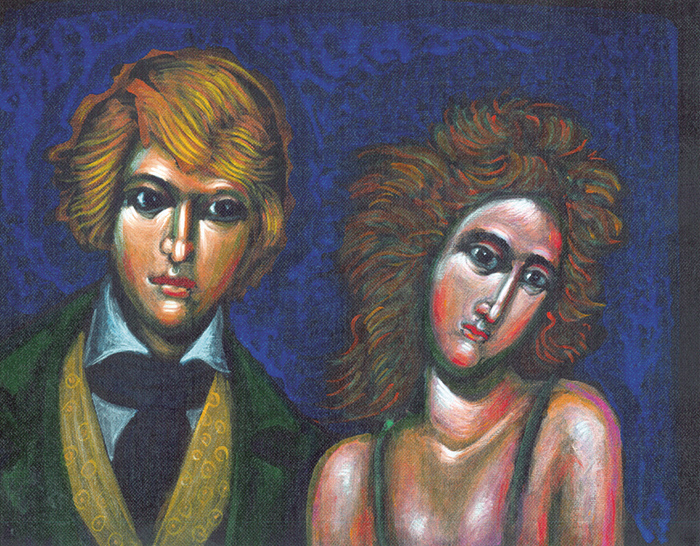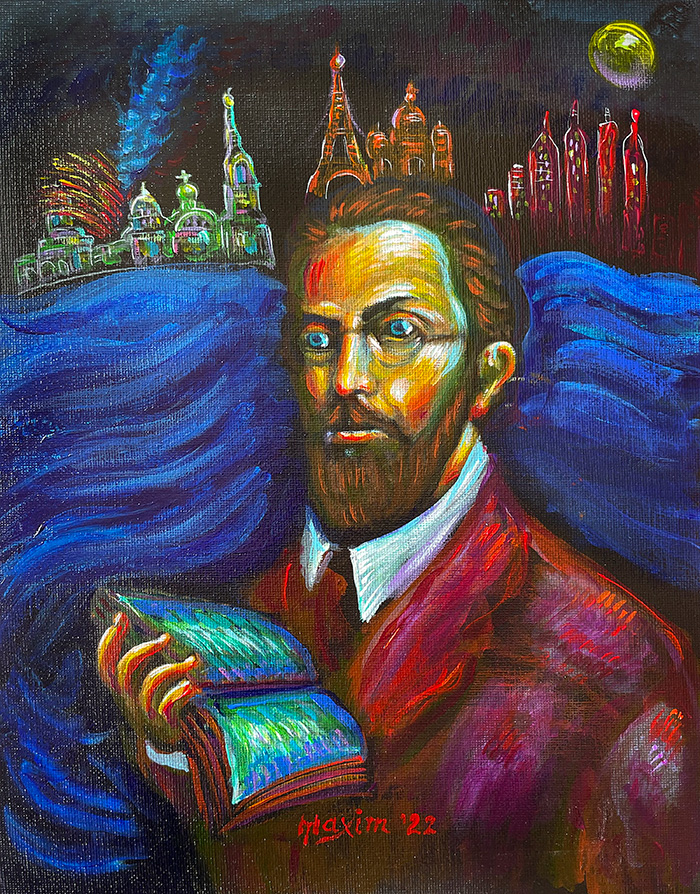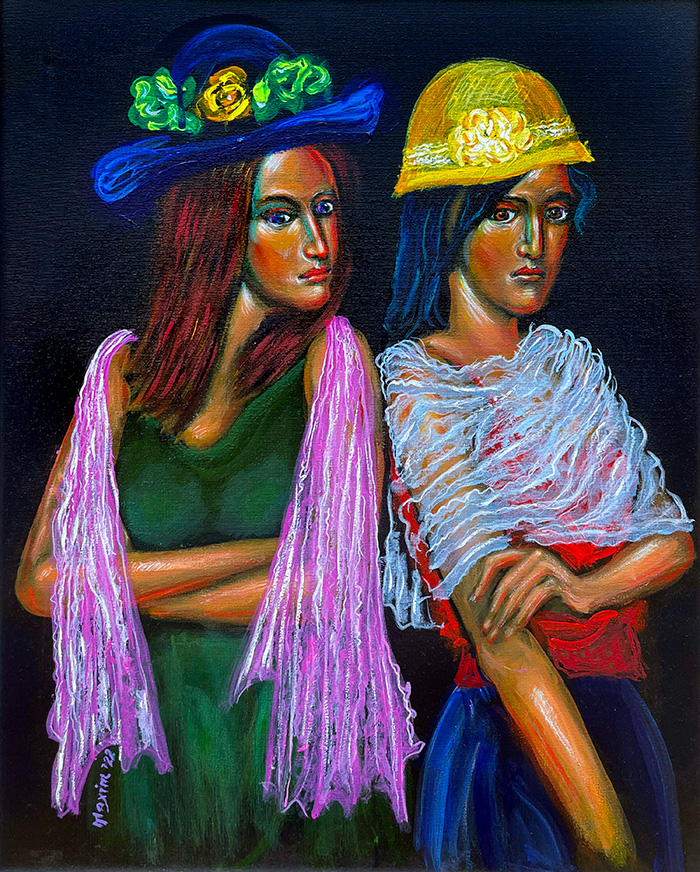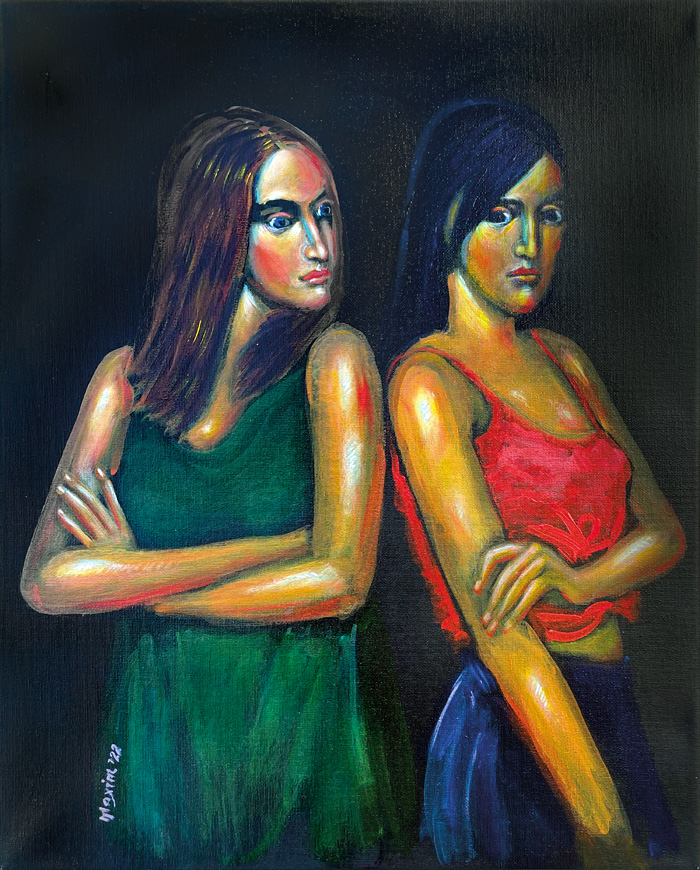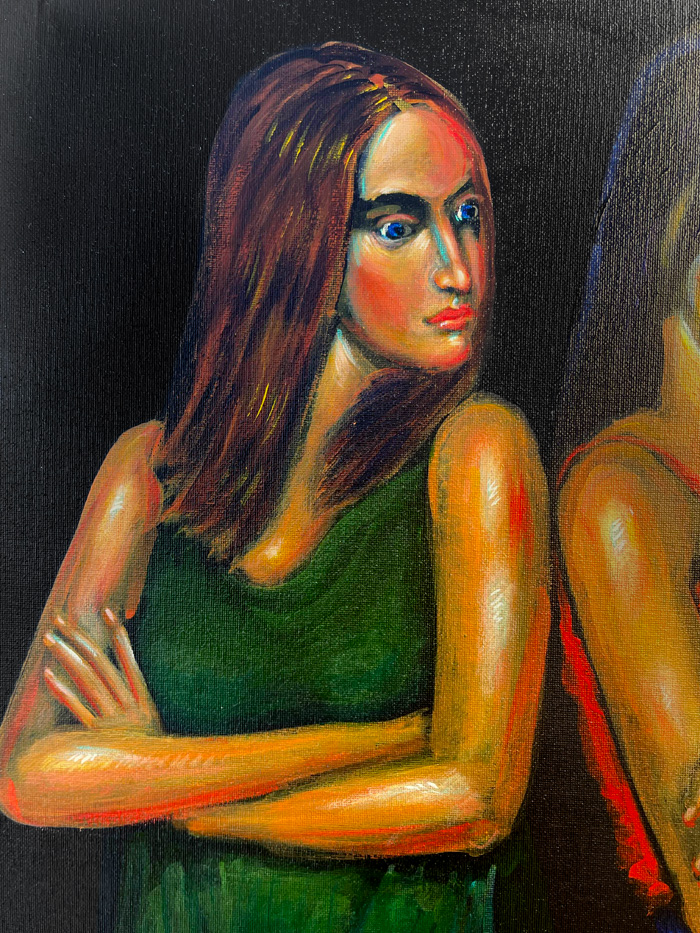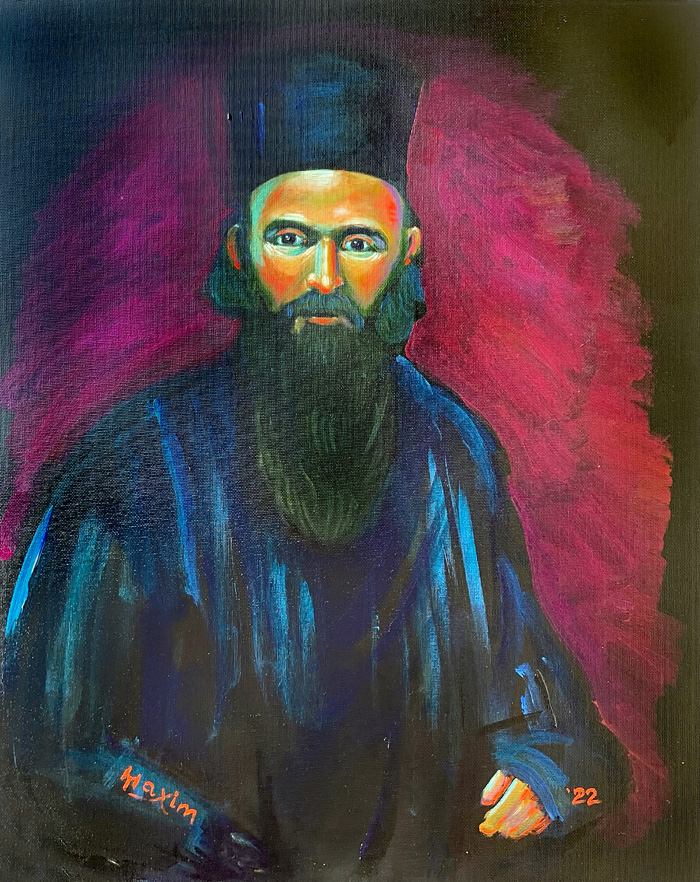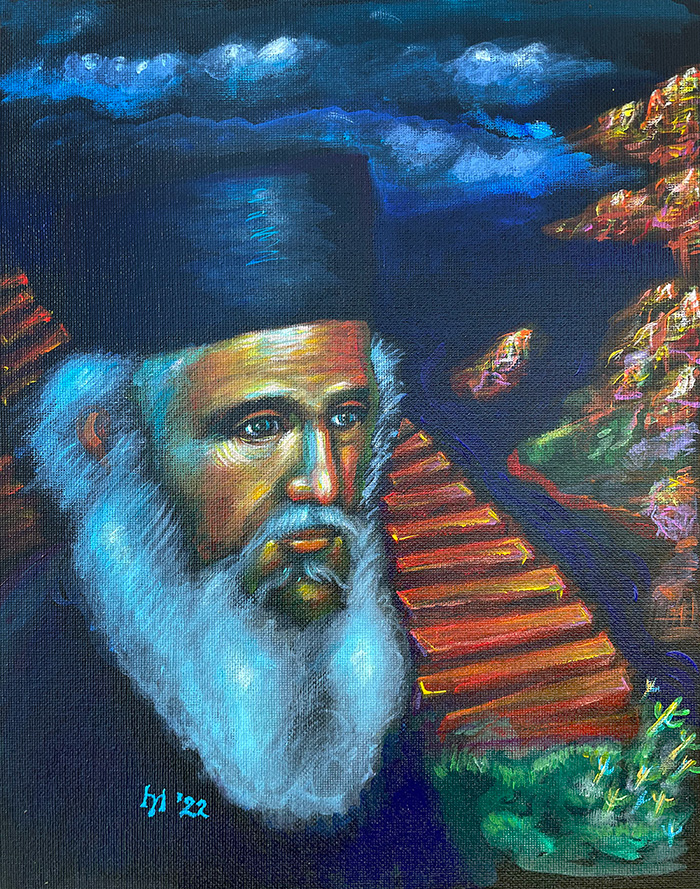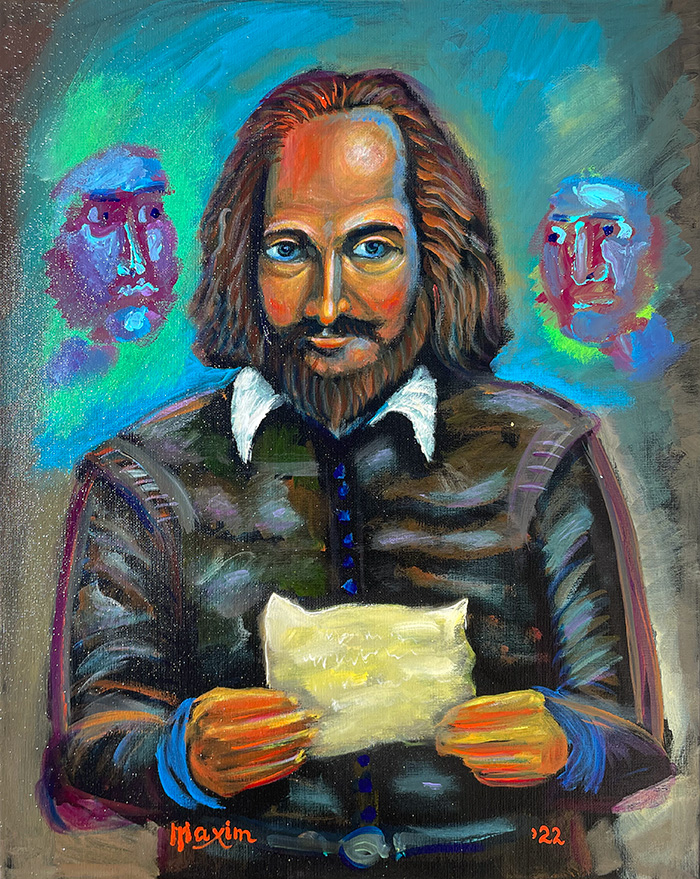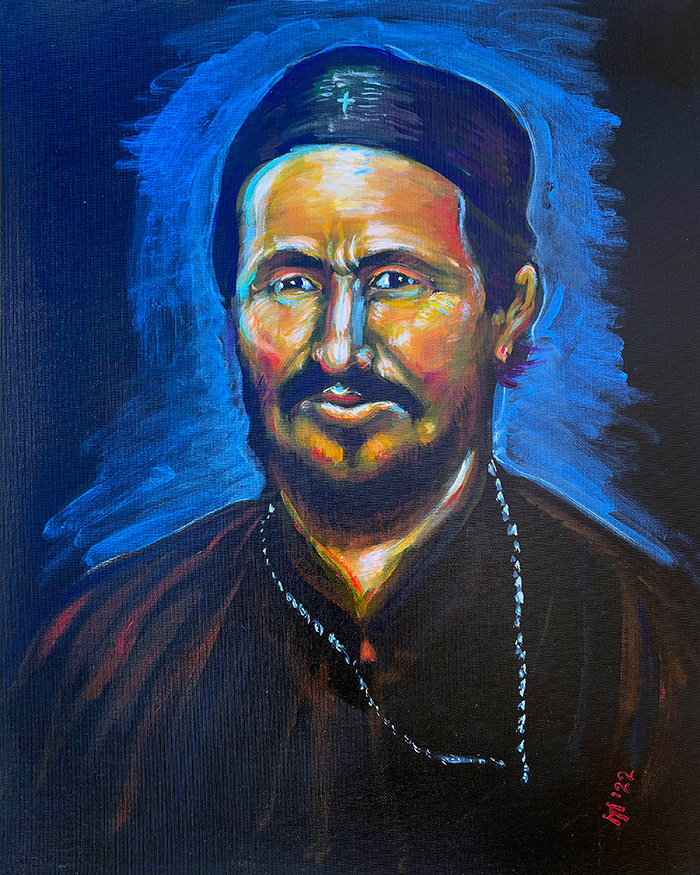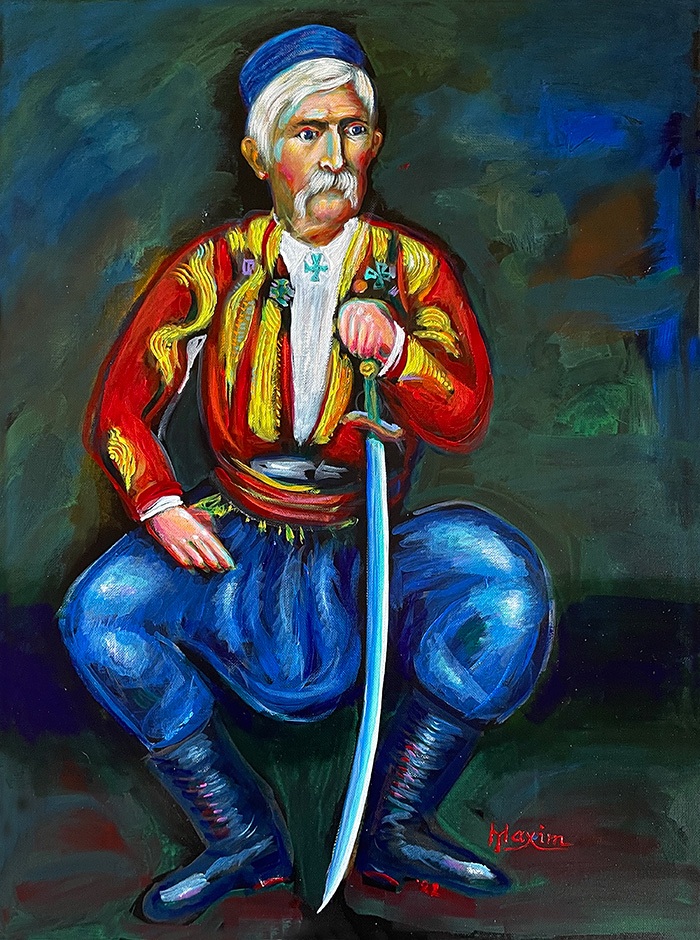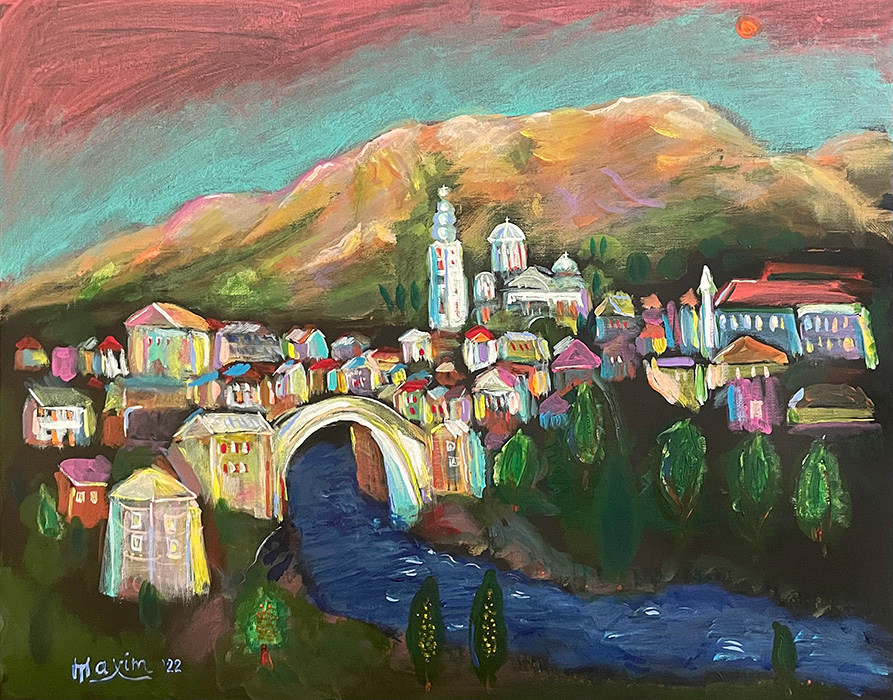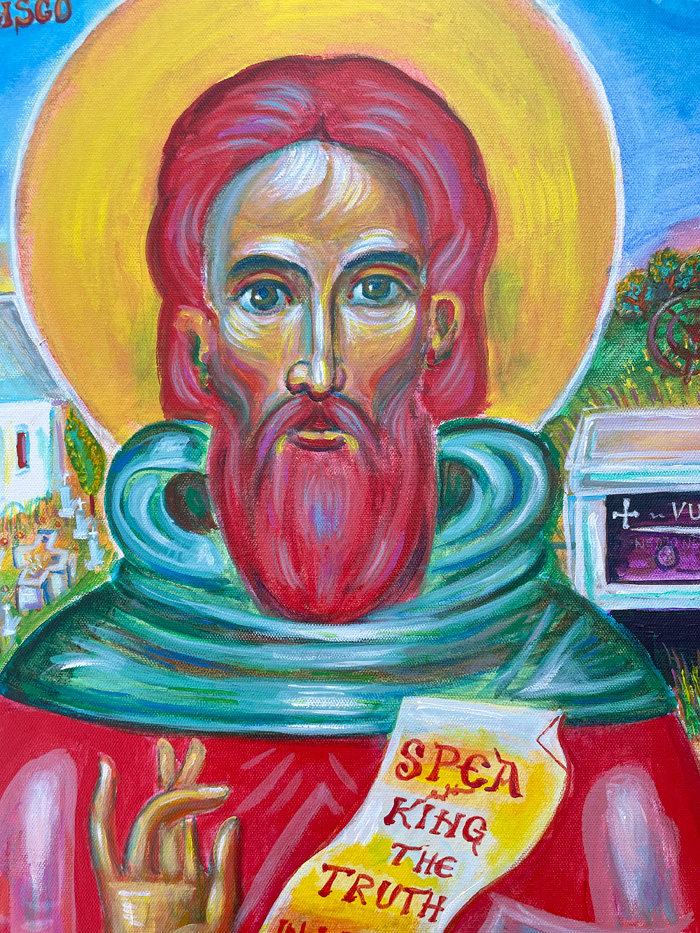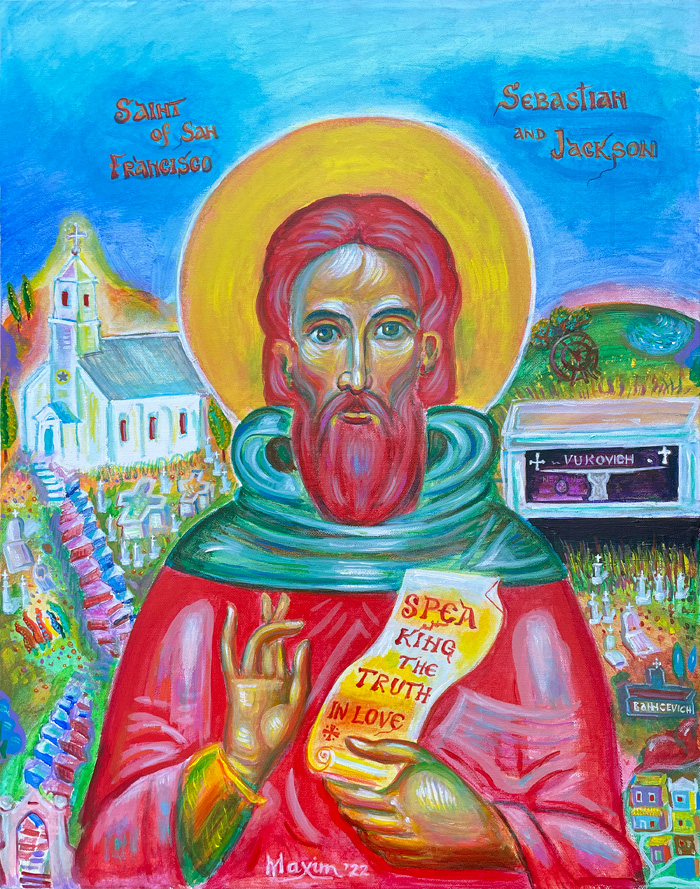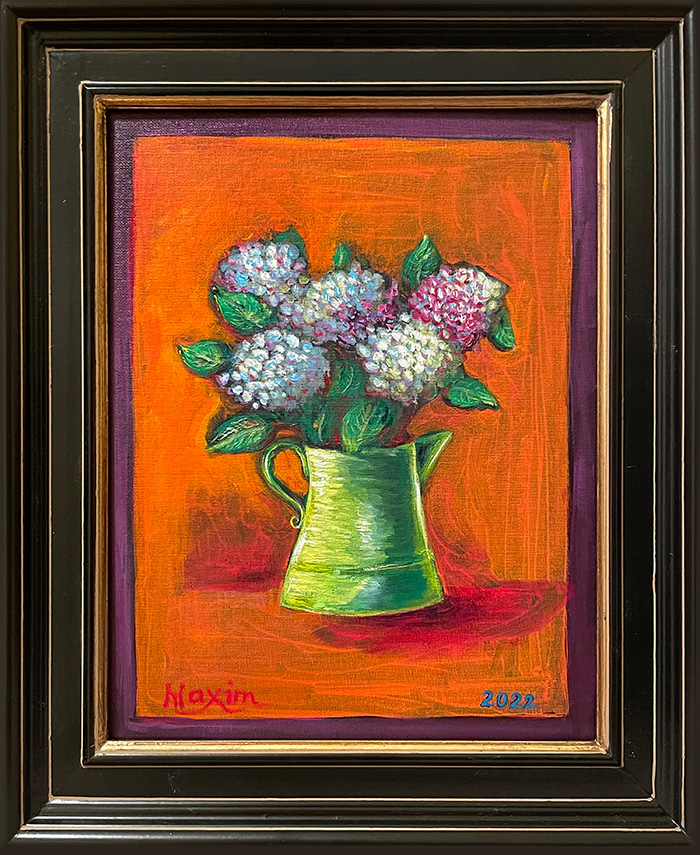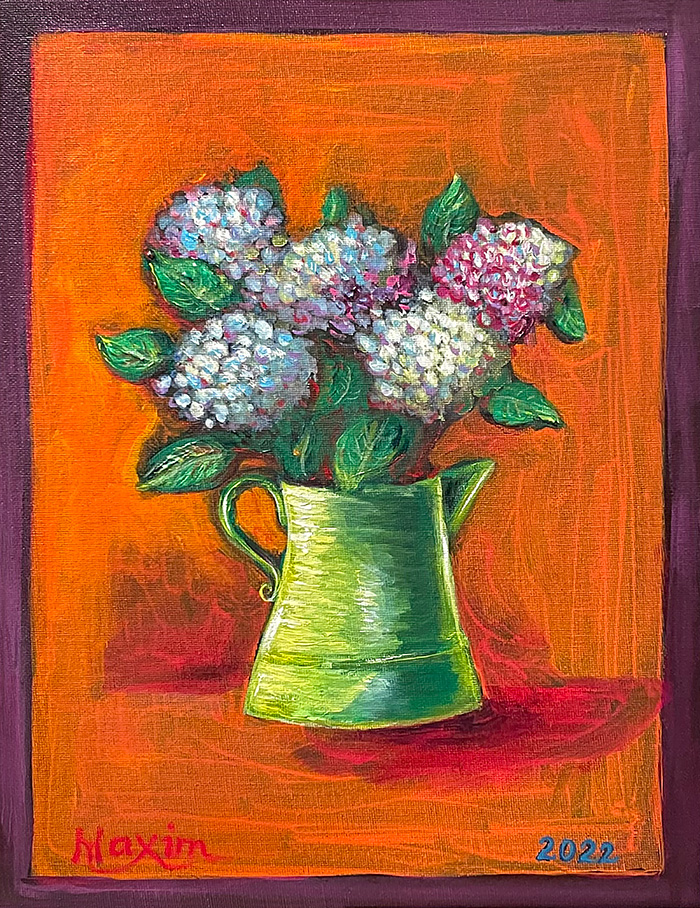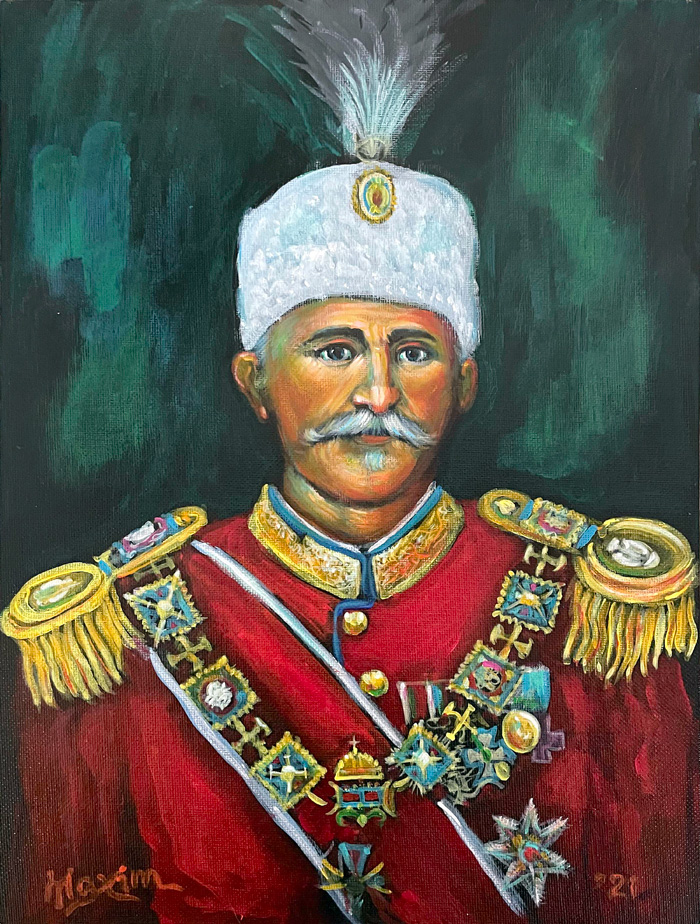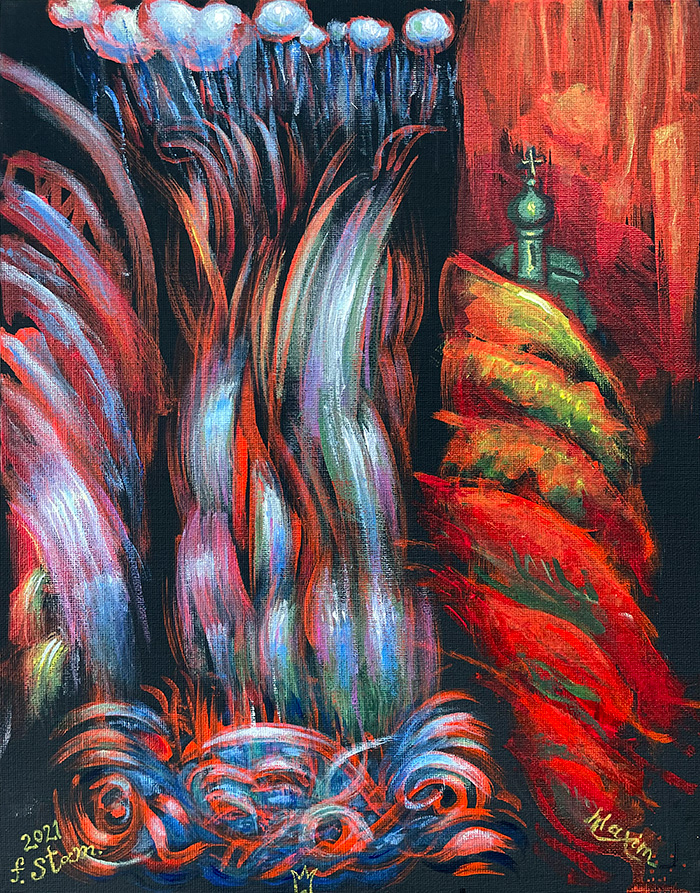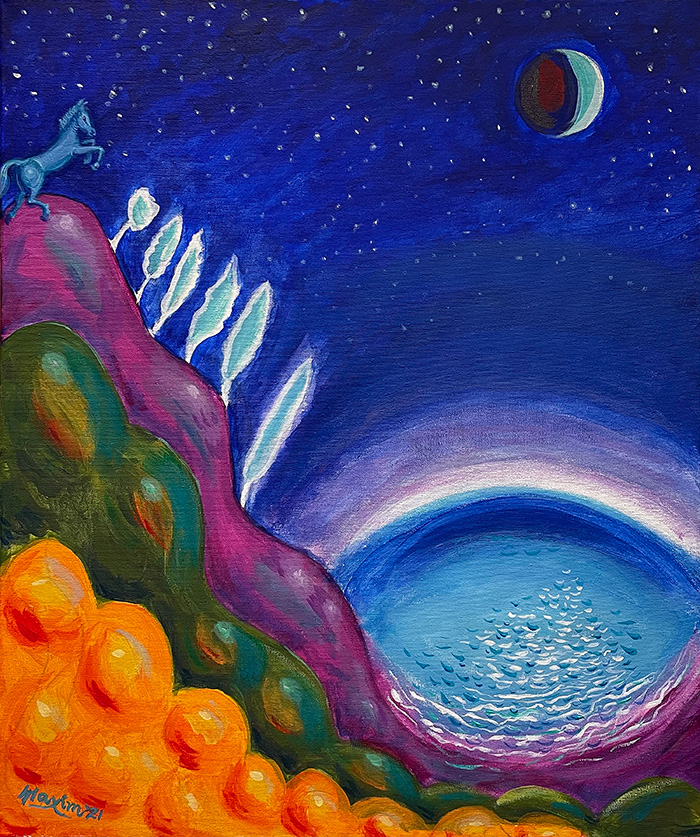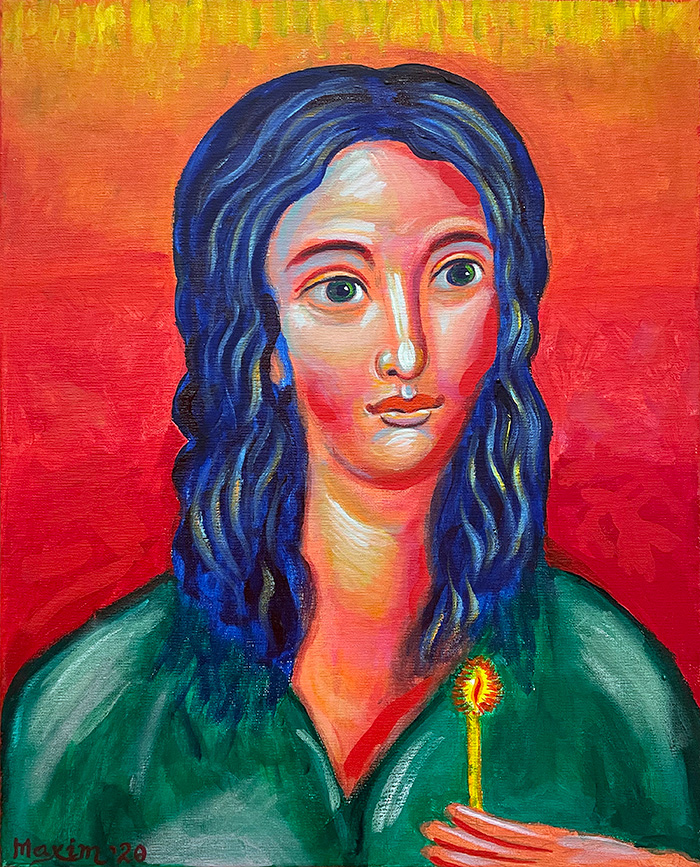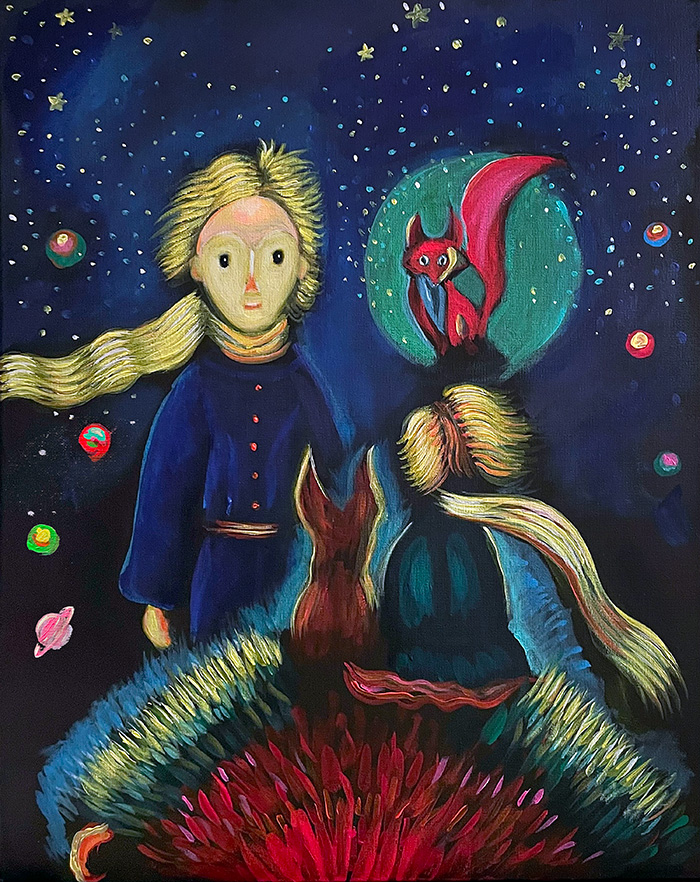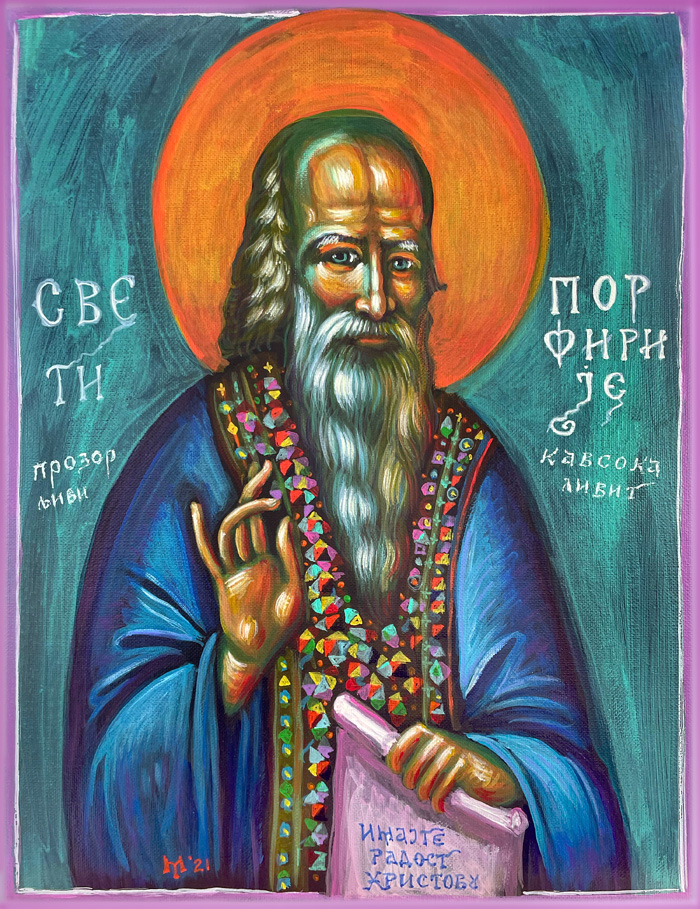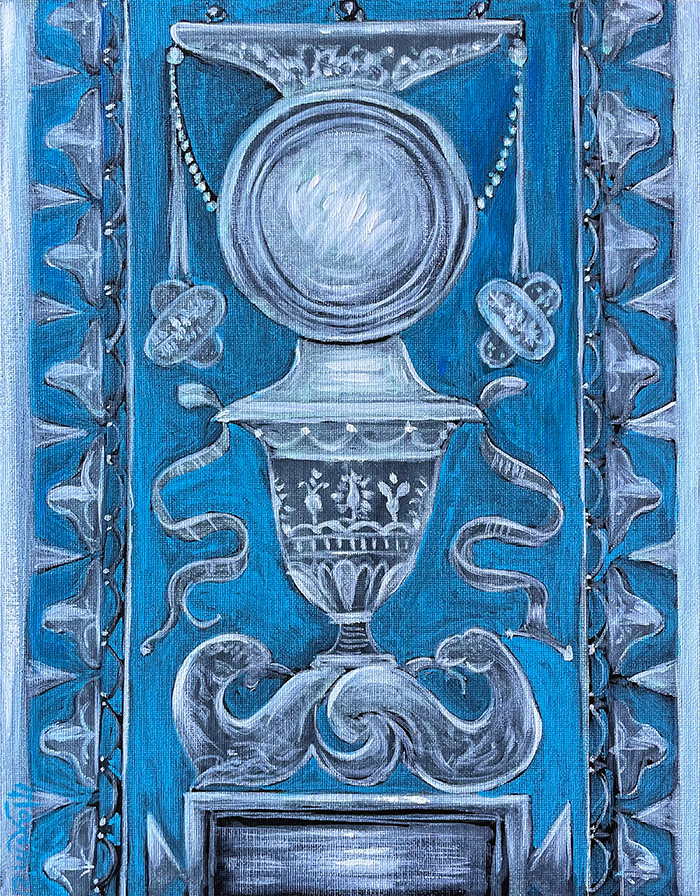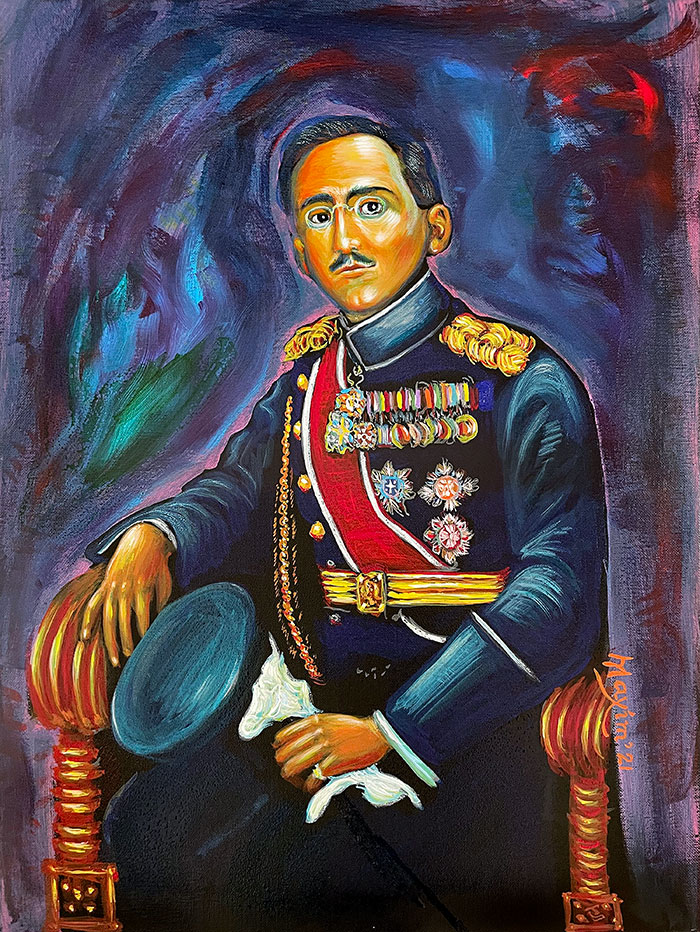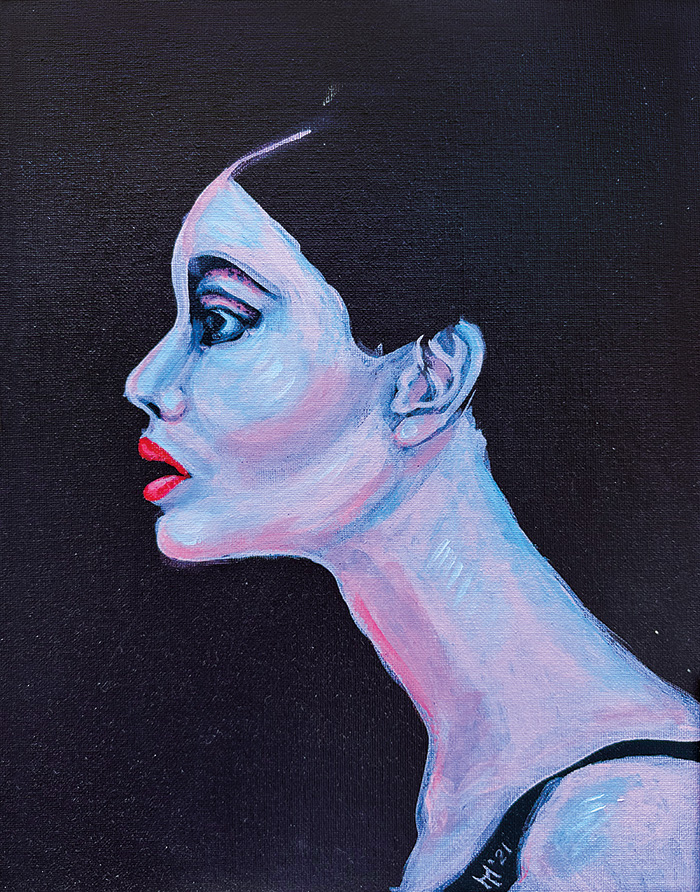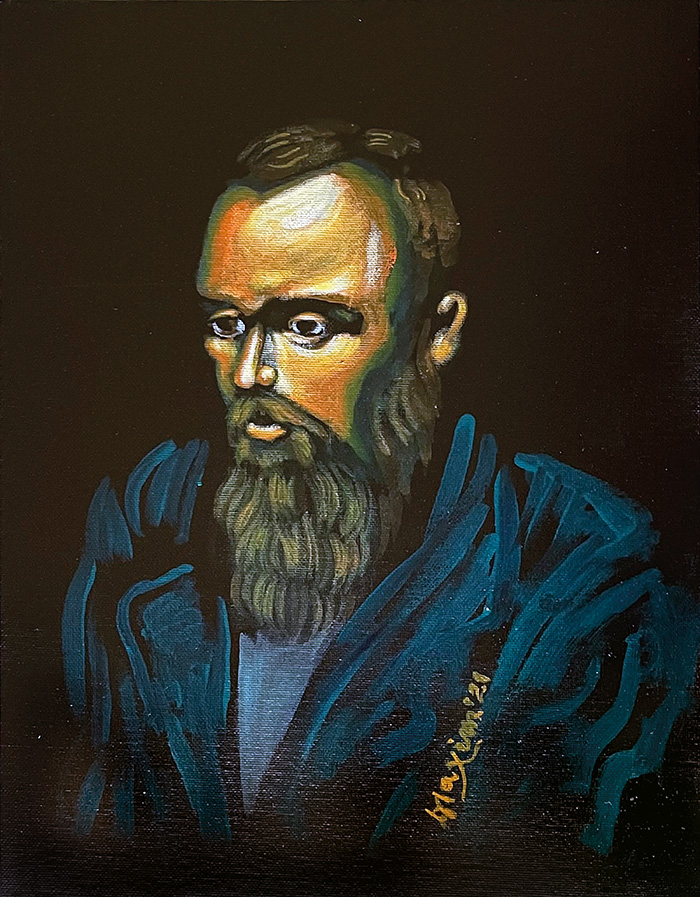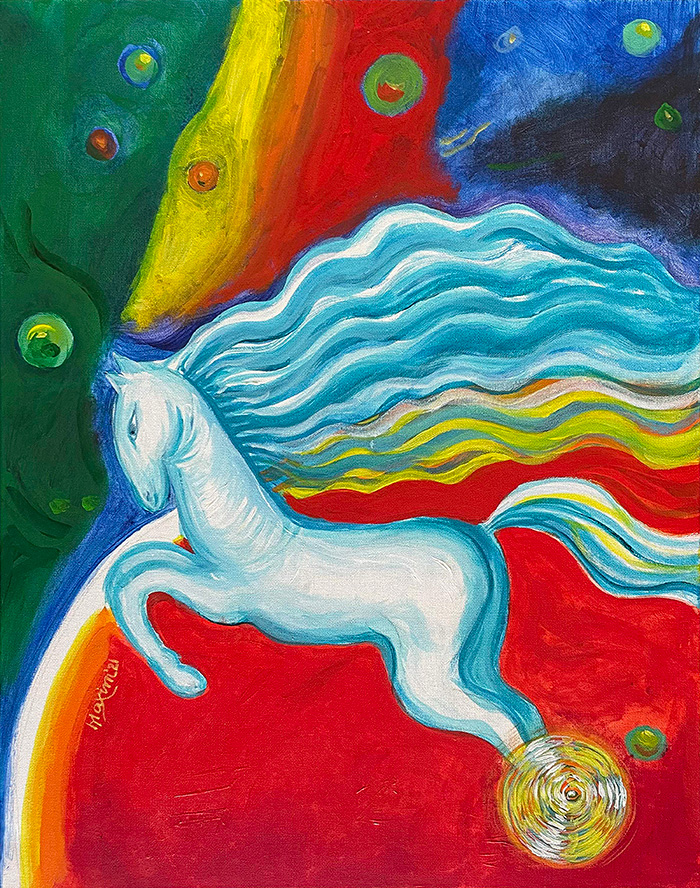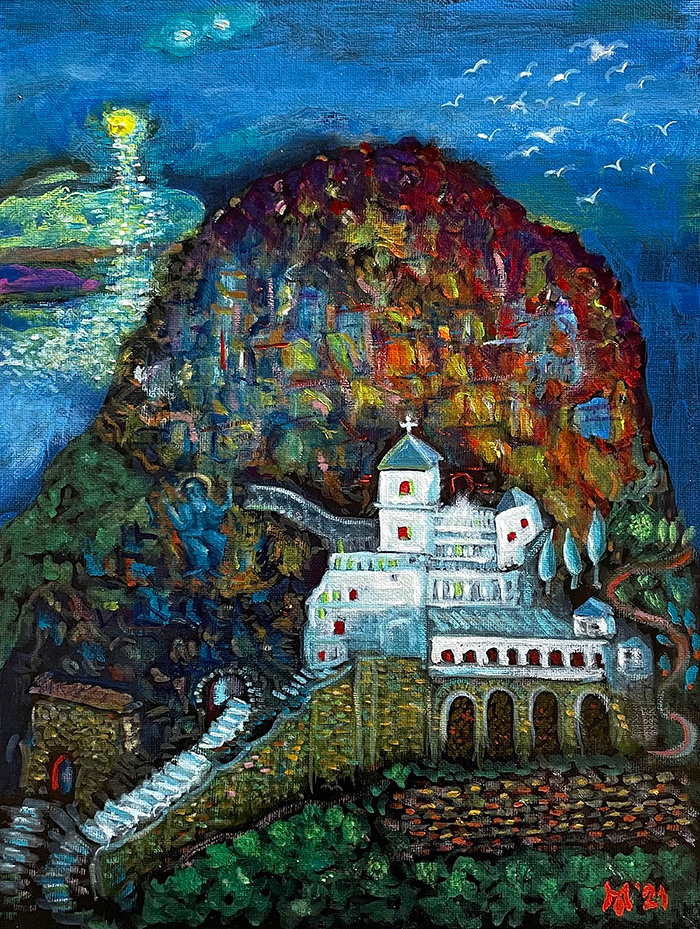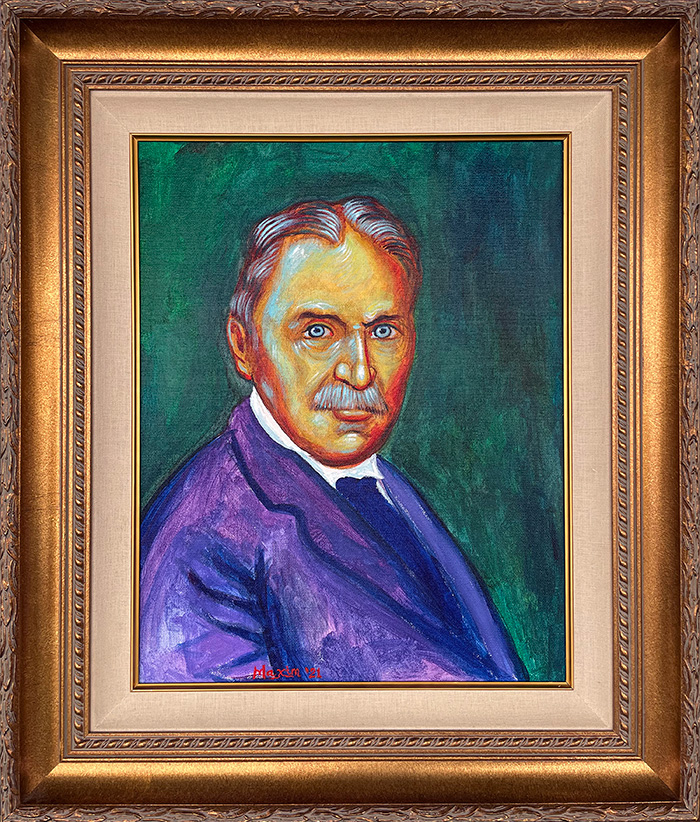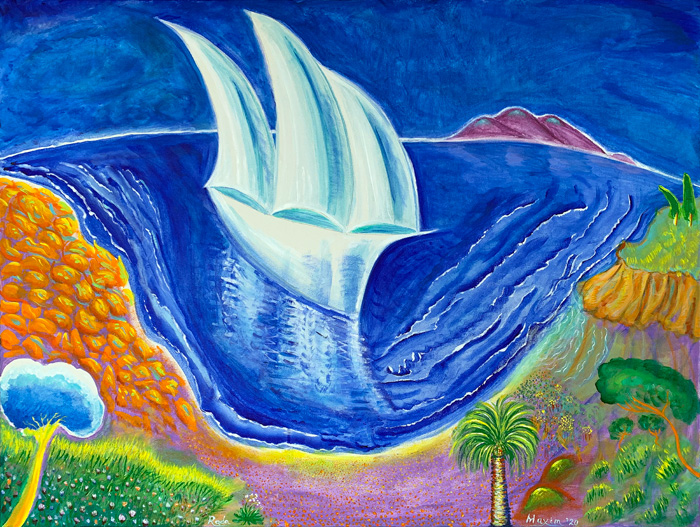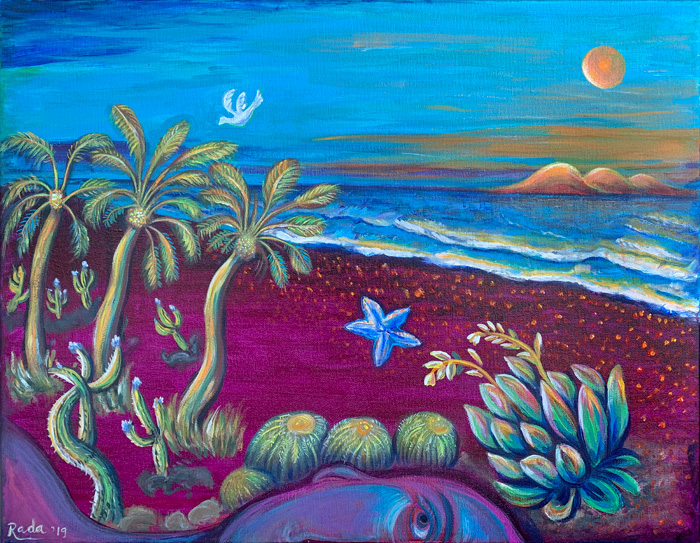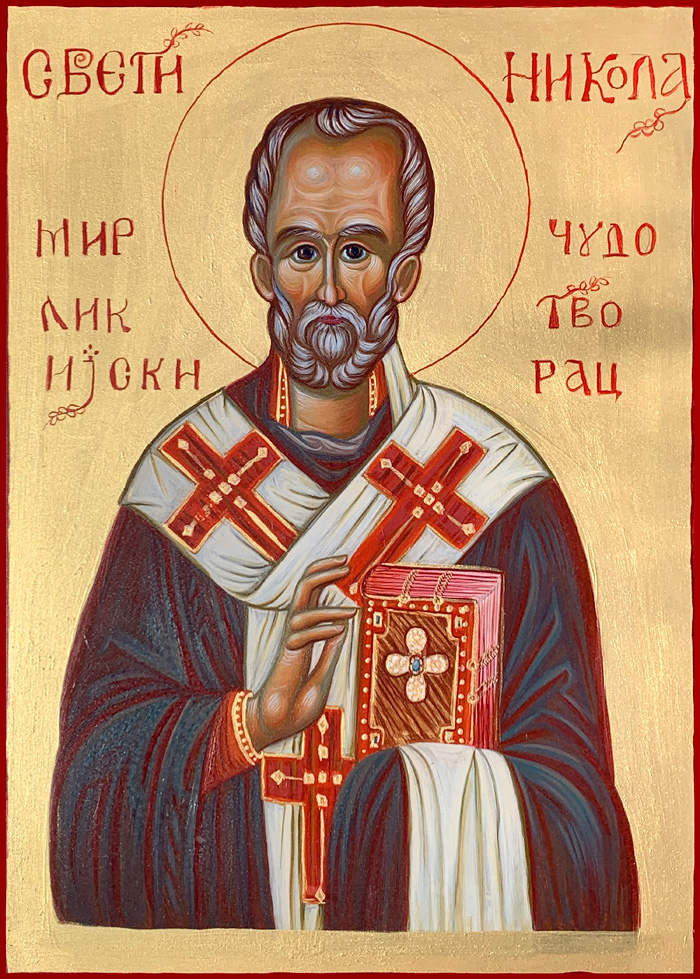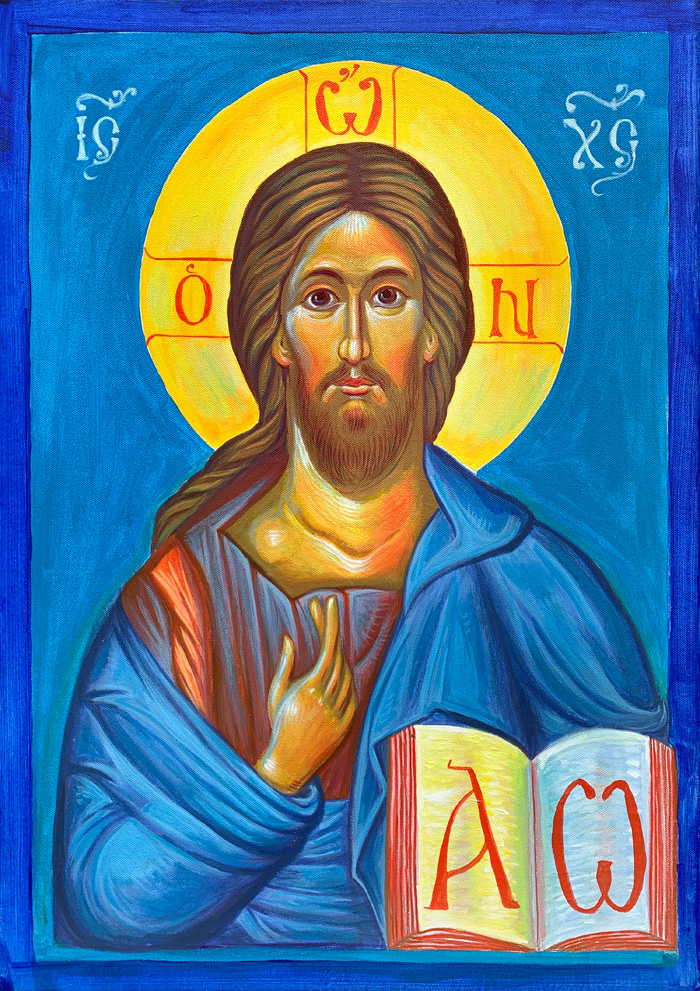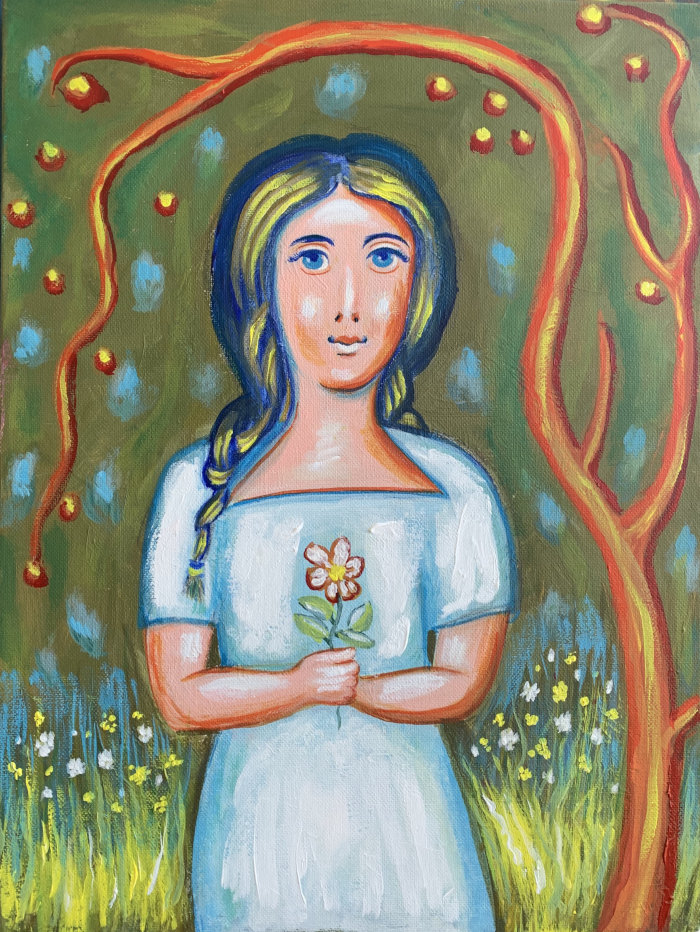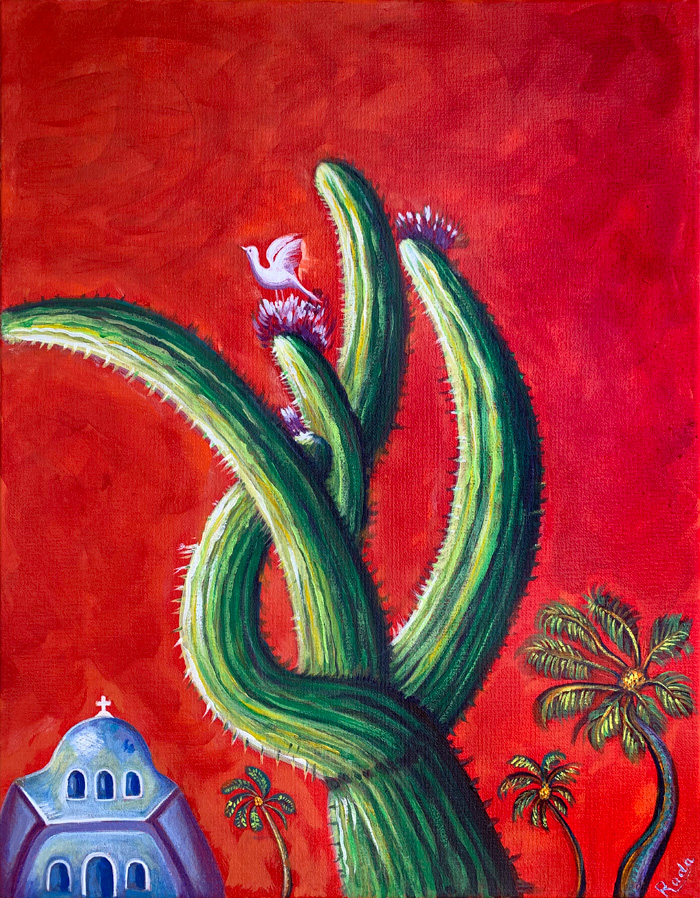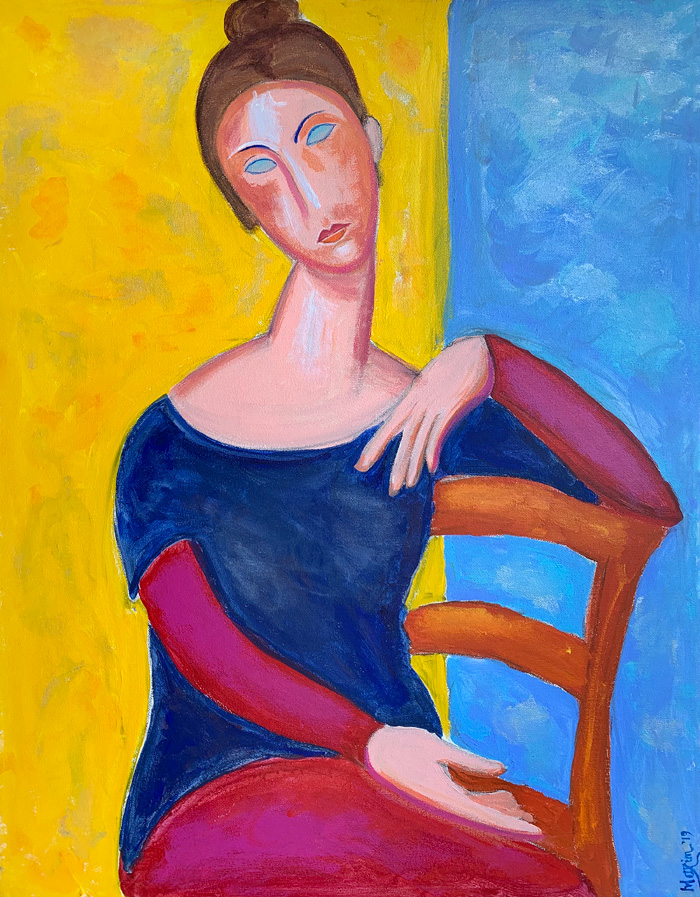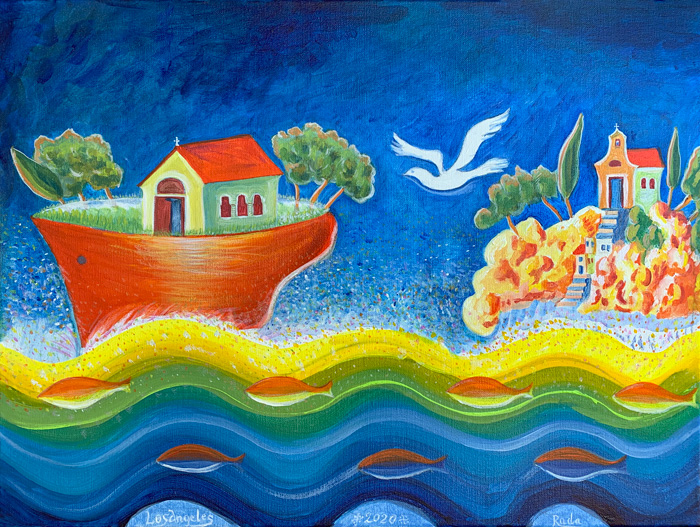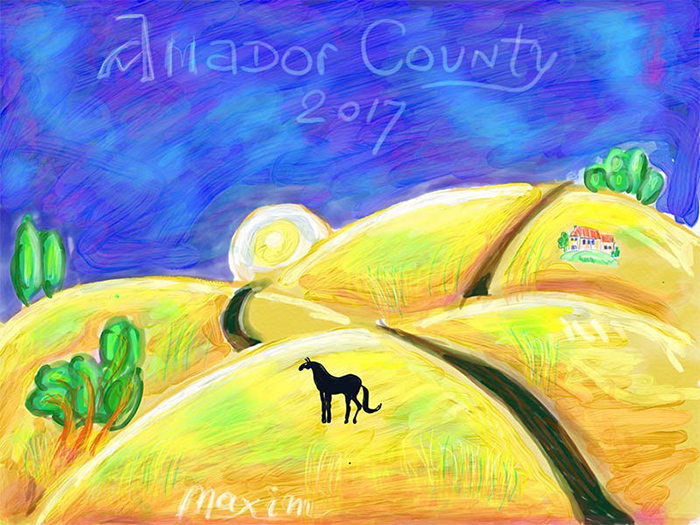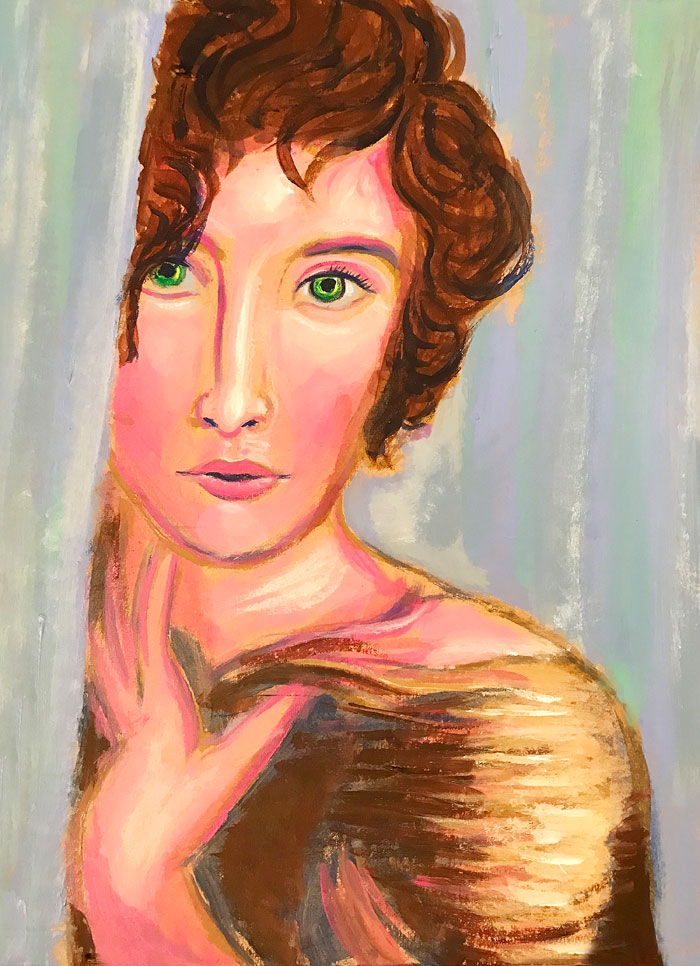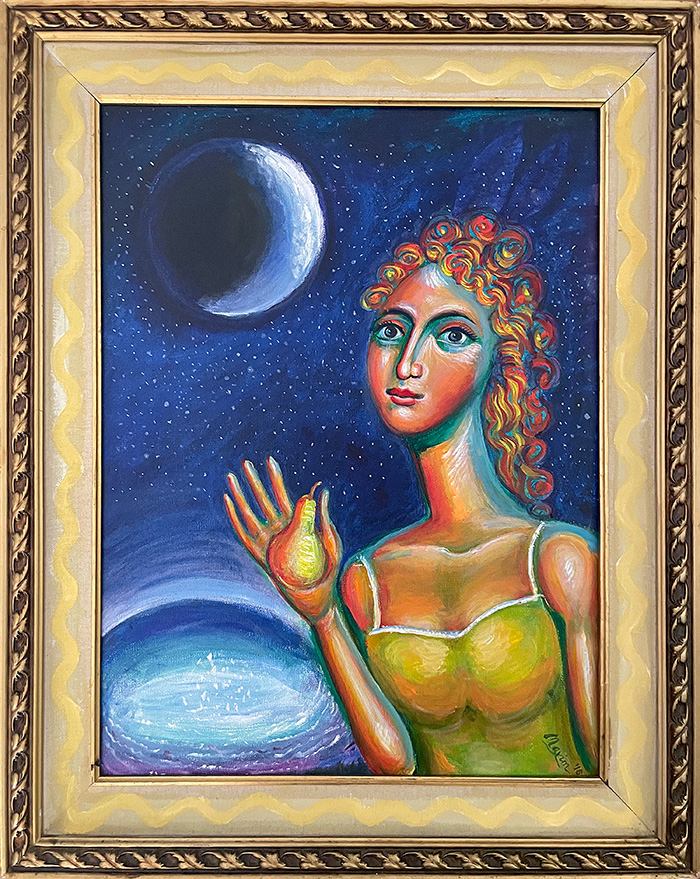"The White Christ Light," acrylic on gesso board, Bishop Maxim, 2024
Only those things we would like to see, such as that it emits light, Christ is the light, that the Saints saw the light, etc. However, let us see it as a portrait. It succeeds in the eyes with that instantaneous glance that looks at us and reads our heart, and we also read it as we would a friend. Because there is a harmony of love, mutual understanding, appreciation, respect, and mutual interest. We see it looking at us, and as we have said before, if it does not say something to you for a long time, ten minutes, a quarter of an hour, if you keep looking at two eyes of a portrait, you cannot understand much about the expression. Now we keep looking, and the more we look, the more we understand that it is saying to me, “Stamati, my Stamati, my Stamati.” It looks as if it has not looked at anything else. An axis is created between the two glances: a line that leaves from me and goes to it and another that leaves from it and comes to me. I am not indifferent to it. Maybe you fell, maybe I am cornering you, maybe you do not feel free? Come, tell me, or in other words, pray, talk to me, and as I look at you, so I will listen to you. However, the listening, how much it is willing to listen to us, is not visible artistically. The glance is what is captured more easily and leaves very simply. Maximus’s lines in the hair, for example, have no hesitation. When you see white, and it has no hesitation, it either has absolute truth or, let us say, absolute certainty. However, here, it has no hesitation at all. How will they turn from the top of the parting downwards, and how will they straighten as they fall down as if, let us say, Maximus studied for a year or two in portraiture and learned some secrets to capture from teachers. He also managed to place lighting on the cheeks, eyelids, and the upper lids, red, which has a glowing orange.
"Saint Magdalene", acrylic on canvas, Bishop Maxim, 2024
The uncertainty of the previous image here turns into certainty, leading to that ecstatic look when He said to her, "MARY!" And she responded eagerly, "RABBONI, TEACHER!"
Both images are interesting. We pinpointed the subtle difference. One is as she goes to the tomb. The second is the joy as she turns and sees Jesus.
- Fr. Stamatis Skliris
"Mostar", acrylic on gesso board, Bishop Maxim, 2024
"The Bridegroom of the Church", acrylic on gesso board, Bishop Maxim, 2024
"Twelve Disciples before Their Illumination" [or: "For those who love us and those who hate us"], acrylic on canvas, Bishop Maxim, 2024
The Last Supper - A group of disciples embraces the Teacher who offers them life. How did the iconographer achieve an ethos of Harmony and identification of the group for two reasons: the fear of impending martyrdom and the faith in the supernatural transcendence of nothingness? They are all one body, the BODY OF CHRIST. An incorruptible body. And they all experience together, as united in spirit and body through divine communion, the unique moment that split history in two. Artistic secret of the painting: the gazes of the disciples that identify with each other and the stage design of the united bodies, where not even a pin could fall!!!
— Stamatis Skliris
A harmonious gathering of expectant faces and vibrant colors surround Christ depicted against the immense backdrop of a star-pitted night, suggesting the all-encompassing cosmic nature of the event. John the beloved leans upon the Lord’s shoulder. All eyes and faces are turned toward him... except for one who turns in the opposite direction. This is the Eucharistic banquet of an unredeemed humanity. The blood red of the cup and the Holy Altar are of one piece with the red of the Savior’s divine quintessence which will be poured out through his human flesh and blood. The overall harmony of the painting, with its diversity of vibrant colors and faces, gives form to the reality that “Christ is in our midst!” Surrounded by untransformed humanity, “those who love us and those who hate us,” he prepares to pour out his life in order to transform ours. Apart from any commentary, this is a vibrantly beautiful painting of harmony, color, and form. Very appealing.
— Stephen Muse
"The Myrrhbearer’s Gaze", acrylic on canvas, Bishop Maxim, 2024
The painter captures the Myrrhbearer’s gaze as she witnesses the Resurrection. Her expression, a blend of surprise, awe, and curiosity, is rendered with exquisite detail. This moment, set on Holy Saturday, encapsulates a profound narrative: her preparation to anoint Him meets the miraculous sight of the Risen Christ. The artwork not only portrays this biblical event but also invites the viewer into the depth of this transformative experience, where the spring’s renewal mirrors her renewed faith.
It appears as if the dawn sweetly breaks, and the Myrrh-bearer goes with fear and inquiry about who will roll away the stone, for it was exceedingly large. She firmly holds the myrrh container, and we recognize her. It has become a mature portrait for artist Maxim, where the eyes, in a wondrous way, and a few brush strokes express everything we discussed. While the dawn sympathetically illuminates the landscape and inanimate nature, conversely, the animate nature—1. eyes wide open, 2. face fearful, and 3. garment wrapped around her body—has all the elements that express the mystery and enigmatic aspect of Baltus’ work. Similarly, here, the Saint is a mystery and enigma until the dazzling angels announce that, indeed, the Lord has risen! The small flowers surrounding her in the background emphasize the contrast. While her face is marked by the turmoil of death, nature, in stark contrast, smiles indifferently, seemingly oblivious to death’s presence and unaffected by it.
— Stamatis Skliris
Φαίνεται σαν να γλυκоχαράζει η αυγούλα κ πάει με φόβο κ διερώτηση ποιος θα κυλίσει το λίθο “ην γαρ ΜΕΓΑΣ σφόδρα”. ΚΡΑΤΑΕΙ το μυροδοχείο κ την αναγνωρίζουμε. Είναι πι για σένα ένα ώριμο πορτραίτο όπου τα μάτια με θαυμαστό τρόπο κ λίγες πινελιές εκφράζουν όλα όσα είπαμε πιο πάνω. Ενώ η αυγή φωτίζει συμπαθητικά το τοπίο, την άψυχη φύση, αντιθέτως η έμψυχη φύση: 1. Ως μάτια διεσταλμένα, 2. Το πρόσωπο φοβισμένο και 3. Το ένδυμα τυλιγμένο γύρω στο σώμα της ΕΧΕΙ ΟΛΑ ΤΑ ΣΤΟΙΧΕΙΑ ΠΟΥ ΕΚΦΡΑΖΟΥΝ ΤΟ ΜΥΣΤΗΡΙΩΔΕΣ Κ Τ ΑΙΝΙΓΜΑΤΙΚΟ ΣΤΟ ΕΡΓΟ ΤΟΥ BALTUS. Έτσι κι εδώ η ΑΓΙΑ είναι ΑΙΝΙΓΜΑ Κ ΜΥΣΤΗΡΙΟ μέχρι να της πουν οι απαστράπτοντα σ ΑΓΓΕΛΟΙ ότι ΑΝΕΣΤΗ Ο ΚΥΡΙΟΣ ΟΝΤΩΣ!!! Τα λουλουδάκια που περιβάλλουν πίσω της στο φόντο την Αγία τονίζουν τη διαφορά: 1. Ενώ το πρόσωπο ταράζεται μπροστά στο πεπρωμένο του θανάτου, 2. Ολως αντιθέτως η φύση χαμόγελα αδιάφορη σαν να μη βλέπει το θάνατο κ μένει αδιάφορη.
— Stamatis Skliris
"Guardian of the Seas: Saint Nicholas", acrylic on gesso board, Bishop Maxim, 2024
This painting depicts Saint Nicholas emerging from the sea, serving as a beacon of comfort in tumultuous times. Cradling a boat in his left hand and bestowing a blessing with his right, he embodies divine safeguarding. His face and vibrant clothing are rendered in a fusion of Byzantine and contemporary art styles, adding a timeless yet modern dimension to his figure. The vibrant blue backdrop and sky highlight the grace and tranquility he introduces amidst the chaos stirred by the restless waters.
"St Catherine of Sinai", acrylic on gesso board, Bishop Maxim, 2024
This rendition of the icon of Saint Catherine is arguably the finest. Her gaze is captivating, seemingly leaning towards us as if to listen; the depiction of her holy garments and the scenic background featuring little trees to the left and a church to the right are exquisitely crafted. The sky, rendered with stunning beauty, symbolizes Paradise—a place we aspire to reach and meet her. Additionally, the elegant backgrounds behind saints like this one, with three small trees on the left and a yellow church on the right—or perhaps Mount Sinai—and libraries and universities on the right, demonstrate a mature artistic language that Vasiljevic mastered slowly but surely. The work is presented as strong and untamed; it has its own identity, and we must take care not to lose sight of it.
— Stamatis Skliris
"Jesus Christ", acrylic on gesso board, Montana, Bishop Maxim, 2024
This portable icon of Jesus Christ the Savior, showcased in Kalispell, Montana, on Saturday, April 20, 2024, captures the essence of traditional Byzantine iconography with a refreshingly communal twist. Executed in a style that reverberates with the simplicity and depth characteristic of Byzantine art, the painting emerges as a collaborative masterpiece. Each brushstroke, contributed by various attendees during the public event, culminates in a unified image that not only honors but revitalizes the age-old techniques of Byzantine painters. This approach not only deepens the aesthetic and spiritual resonance of the piece but also transforms it into a living tableau of community engagement and artistic homage.
The iconography workshop led by Bishop Maxim provided a learning experience for Orthodox Catechumens and inquirers in Kalispell. It was held in the relaxed and friendly atmosphere of a coffee shop, where participants could engage hands-on with the styles and techniques of iconography.
"Mystic Guardians of the Night", acrylic on canvas panel, Bishop Maxim, 2024
This evocative painting portrays a dramatic nocturnal scene on a mountain cliff, where four tree-like figures akin to cypresses emerge bathed in an ethereal glow. Painted in vivid yellows and ochres against a deep blue night sky, these trees stand in stark contrast, imbuing them with a narrative presence as if they were characters in a mystical tale. The unseen light source that casts their forms in such vivid relief adds a layer of mystery, compelling the viewer to ponder the hidden stories these illuminated sentinels might hold. The artist masterfully employs color and contrast to craft a visual narrative that is both enigmatic and deeply engaging.
"Diagonal Dynamics: Contrast and Motion in the Surreal Landscape", acrylic on canvas, Bishop Maxim, 2024
All variations of the painting with the four cypresses by the artist are remarkable. Here, within the burning earth, a transparent snake, a small pond of greenery, and (a very SMART move) the trees are stark white, creating a surreal contrast. An ORANGE COMPOSITION OF COLORS gives us a song of joy. The transparency of the snake and the sky of clouds is impressive. The complementary encounters of warm and cool tones are also beautiful. The diagonal axis that runs through the composition is clever. This is a painting that is free, copying no one, moving in an open space where the diagonal enhances the movement and turns it into action.
- Fr. Stamatis
"Crimson Arboreal Moonlight", acrylic on canvas panel, Bishop Maxim, 2024.
Beautiful is the transparent red of the four trees and the Moon that illuminates them. As well as the miniatures of the houses below and the iridescence of the lake’s waters. “Oh, God, if only You deemed me worthy to live such a magical night!!! Lord, You have crafted around us the entire vast world, which is a true JEWEL, a true adornment! You have graced us with a painter capable of creating his own jewel, which completes and arouses within us divine love!”
— Stamatis Skliris
"Celestial Whispers", acrylic on canvas panel, Bishop Maxim, 2024
This painting exquisitely captures a serene yet enigmatic landscape, blending earthy tones of sienna and umber with a star-studded sky that evokes wonder. The dynamic arrangement of four trees adds depth and invites viewers into the scene’s mystique. The use of acrylic on canvas enhances the vivid colors, making “Celestial Whispers” a compelling fusion of natural elements with a surreal touch. This work invites contemplation, offering a visual feast that beckons the observer into its depths.
“Emerald Silence at Dusk”, acrylic on canvas panel, Bishop Maxim, 2024
This painting presents a warm reddish background transitioning into lush greenish trees, evoking the peaceful and contemplative stillness of twilight.
In a paradoxical and inexplicable way, this second painting (titled “Emerald Silence at Dusk”) is more... ART than the first, titled “Solitary Blues at Sunset.” Of course, many will prefer the first trees. However, the second trees have something inexplicable about them. The first we see as trees that have sprung up on rocks and soil while the second grow on the ridge of a spherical planet, it is not something simple. The painter introduces us to cosmic problems. And our existence is dizzying in this dimension. The first paints landscapes. The second, however, depicts non-existent events. MAXIM, your composition has a rare originality. It is as if the author of Genesis is whispering to us: “In the beginning, God made the four cypresses on the ridge of the earth. And the earth was blood-soaked. And the trees stood above graves. And humans had ‘invented war’.”
Κατά έναν παράδοξο τροπο και ανεξήγητο αυτός ο δεύτερος πίνακας ειναι πιο.... ΤΕΧΝΗ από τον πρώτο. Φυσικά σε πάρα πολλούς θα αρέσουν τα πρώτα. Όμως τα δεύτερα έχουν κάτι σαν ανεξήγητο.τα πρώτα τα βλέπουμε σαν δένδρα που φύτρωσαν πάνω σε βράχια και χώμα ενώ τα δεύτερα φυτρώνουν πάνω στη ράχη ενός σφαιρικού πλανήτη, δεν είναι κάτι απλό. Ο ζωγράφος μας εισάγει σε προβλήματα συμπαντικά. Και η υπάρξή μας ιλιγγιά σε αυτή τη διάσταση. Ο πρώτος ζωγραφίζει τοπία. Ο δεύτερος όμως παριστά ανύπαρκτα συμβάντα. ΜΑΞΙΜΕ, η συνθεσή Σου αυτή έχει σπάνια πρωτογένεια. Είναι σαν ο συγγραφέας της Γενέσεως να μας ψιθυρίζει: «Εν αρχη εποίησεν ο Θεός τα τέσσερα κυπαρίσσια επί της ράχης της γης. Η δε γη ην αιματοποτισμενη. Και τα δένδρα ίσταντο άνωθεν τάφων. Οι δε άνθρωποι δε «είχαν εφεύρει τον πόλεμον».
— Fr. Stamatis Skliris
"Solitary Blues at Sunset", acrylic on canvas panel, Bishop Maxim, 2024
It features a vibrant orange backdrop that fades into bluish trees, encapsulating the tranquil yet melancholic atmosphere of a lone sunset.
"St Justin the New of Chelie", acrylic on canvas, Bishop Maxim, 2024
This modern Orthodox icon painting features St. Justin the New of Chelie, rendered in vibrant acrylic on canvas. The saint is depicted with a gaze that conveys approval, connecting directly with the viewer through his expressive eyes. In his hands, he holds an inscription that reads, "The measure of everything—the God man," highlighting his theological significance. The use of vivid colors in the composition not only enhances the visual impact but also infuses the artwork with a sense of optimism, reflecting the saint's enlightening presence and spiritual guidance. This icon beautifully combines traditional religious art with contemporary artistic elements, making it a captivating piece that both venerates and inspires.
"Angel Waving Me Through the Window of the World", acrylic on canvas, Bishop Maxim, 2024
"Frida Kahlo: Un Lienzo de Vida y Legado", acrylic on gesso board, Bishop Maxim, 2024
In this envisioned portrait, Frida Kahlo emerges as a symbol of resilience, her spirit intertwined with a vibrant canvas of nature reflecting her tumultuous life. Surrounded by a burst of colorful flowers and lush foliage, each element symbolizes her rich fabric of experiences, with the garden mirroring the depths of her soul. Her penetrating gaze draws viewers into her realm of pain, passion, and creativity, revealing a journey marked by both suffering and artistic triumph. The bold colors, especially the striking reds, serve as a secular halo, celebrating her as a pivotal figure in art. Her attire, alive with expressive hues, underscores her bold spirit and artistic prowess. Both a portrait and a color narrative, this is a tribute to Frida Kahlo's enduring legacy as an art icon.
"The Crucified King: Glory in Suffering’s Embrace", acrylic on gesso board, Bishop Maxim, 2024
This portrayal focuses on Christ at His most vulnerable: crucified, lifeless on the Epitaphion, yet declared the “King of Glory.” Through intense colors and expressive detail, the artist captures the paradox of Christ’s sacrifice, transforming the cross from a symbol of defeat into one of ultimate victory. Here, the artist’s free use of vivid hues redefines glory—not through power, but through the humility and sacrificial love of Christ’s lowest moment. This image invites reflection on the true glory found in the depth of self-giving love.
"The Savior of the World", acrylic on gesso board, Bishop Maxim, 2024
"Caring Bishop Nikodim", acrylic on canvas panel, Bishop Maxim, 2024
The painting captures the pensive character of Nikodim Milaš, the bishop of Dalmatia, immersed in thought and faced with the unknown future and the destiny of his flock. His face is rendered with precision, conveying the weight of his reflections. The coastline nature serves as an amphitheater gracefully embracing the central figure, enhanced by the subtle inclusion of a small boat to the left and a smattering of houses. The composition seamlessly melds introspection with the external environment, symbolizing the bishop’s deep bond with his surroundings.
— Fr Stamatis Skliris
“Jesus Christ”, acrylic on gesso board, Bishop Maxim, 2024
“Jesus Christ”, detail, acrylic on gesso board, Bishop Maxim, 2024
"Ship of Happiness", acrylic on canvas, Bishop Maxim, 2023
“An Impressionist Vista: Bocca di Cattaro,” acrylic on canvas, Bishop Maxim, 2024
This impressionist masterpiece captures the ethereal beauty of Kotor Bay in Montenegro, depicted in the magical twilight just before sunset. The vibrant sea, mirroring the still strong light of day, breathes life into the scene, complemented by boats gently sailing, creating a serene narrative across the water. Quaint coastal houses blend the tranquil sea with the dramatic ascent of majestic mountains, highlighting Montenegro’s natural splendor. Above, the sky transitions from day to evening with a dazzling palette of yellow, pink, and deepening blues, showcasing the impressionist’s talent in blending the boundaries between earth and heaven. This painting celebrates nature’s fleeting beauty, presenting Bocca di Cattaro Bay as an immersive experience of peace and vitality.
"Dawn of Genesis", acrylic on gesso board, Bishop Maxim, 2024
The artwork titled “The Dawn of Genesis” employs a distinctive iconographic technique, where the creative process begins with a dark canvas. Shadows are meticulously layered onto this canvas, followed by gradual applications of light, crafting the subject from the depths of darkness. This method symbolically mirrors the biblical account of creation, suggesting that the figure—presumably first created human being—is sculpted from the void, brought into existence by divine light. The title itself evokes the moment of creation, where man emerges from nonexistence, embodying the first dawn of creation. The narrative captured within the painting subtly conveys man’s initial encounter with the divine; his creation by God is marked by an inaugural vision, possibly of God Himself. This profound moment is reflected in man’s expression, particularly in his eyes, which are rendered to convey a sense of awe or surprise at this revelation. Thus, the painting not only depicts the physical emergence of man from nothingness but also captures the spiritual awakening of the first human as he beholds something—or someone—beyond himself for the very first time.
"Voyage of Warmth," acrylic on gesso board, Bishop Maxim, 2024
Created on February 17, 2024, this acrylic painting on the gesso board captures a serene yet profound moment at sea. The viewer’s gaze is drawn to a solitary boat, its sails unfurled, painted a vibrant red that contrasts starkly against the cool, muted tones of a frozen island. This island, an embodiment of isolation and rigidity, stands as a heart of stone amidst the vastness of the ocean. Above, the sky offers just a glimpse of the sun, a subtle nod to hope and renewal. The red sails of the boat symbolize the warmth of life and passion, navigating through the cold, unyielding challenges. This scene is not merely a depiction of a physical journey but a metaphorical voyage toward transformation and awakening. This “Voyage of Warmth” eloquently speaks to the power of resilience, love, and the eternal quest for inner change, bearing the promise of renewal to the frozen recesses of the soul.
"This recent painting by Bishop Maxim uniquely blends elements of both the New England (American) Coast and the British Coast, aligning itself with the great literary traditions of both America and Britain."
- Valerie Glover
"A captivating image of serene and spacious stillness, gliding through silent waters, past glaciers, surrounded by warmth peeking through sky and sea to form an enveloping womb. The tiny bright red sails evoke the pilgrim heart seeking the Spirit’s flame to pass through even in the coldest and loneliest of deserted places. Hesychia! This painting had the effect of evoking inside me stillness and strange, gentle attention focused by the bright red sailing vessel. It created an inner landscape inviting the silence and attention within."
- Stephen Muse
"Jesus Christ—Thearchic Weakness", acrylic on gesso board, Bishop Maxim and Dijana Skoric, 2024
The Iconic Gaze: A Theology of Thearchic Weakness and Divine Love
Exploring the Depth of Christ’s Look in the Iconography school of Bishop Maxim
by Fr. Stamatis Skliris
Friday, February 16, 2024
This icon of Christ belongs to the icons that present Christ with love and concern for the specific person, you and me. We achieve this mainly with wide-open eyes that care about us. It is a subtle movement beyond the Paleologian school of the almighty PANTOKRATOR, here, with “thearchic weakness” (θεαρχική ἀσθένεια—the term by Dionysius Areopagite). In other words, the PANTOKRATOR humbles himself with His image before the specific man with his particular passions and weaknesses. Out of love and identification with the humbled ontological concrete man, He who transcends suffering as God nevertheless willingly humbles himself and takes on human passion. It is a profound theology of the thearchic weakness that gave birth and developed (with “Justin’s” roots, that is, of Fr. Justin Popovic, who always presupposed a Christ who cares for man and who willingly humbles himself for him) the theology of “thearchic weakness.” Bishop Athanasios Jevtic loved the hymn of St. Basil the Great: “What shall we render unto the Lord for all He hath rendered unto us? For our sake, God dwelt among us; for our corrupted nature, the Word became flesh and dwelt within us; unto the ungrateful, He is the Benefactor; unto prisoners, He is the Liberator; unto those who sat in the darkness, He is the Sun of justice; the path unto the Cross; the Light unto Hades; Life unto death; Resurrection for the fallen: to Him, we cry out: ‘Our God, glory be to Thee!’” (Octoechos, tone 7)
"Impressionist Echoes", acrylic on gesso board, Bishop Maxim, 2024
Very enjoyable landscape with simplicity rendered. It recalls happy moments of French Impressionism, after Van Gogh and Cézanne. The blue of the SKY does not rest on the slope of the triangular peak, but leaves a WHITE glow, which, together with the WHITE glow of the seashore, delineates the whole massif. Nature is presented to us here as a JOYFUL face expressing the happy moment of all creation as if personifying inanimate matter and making its presence in the painting friendly to the viewer.
"A childlike face with innocent eyes cradled in the mountain."
- Stephen Muse
"Cosmic Champion," acrylic on canvas, Bishop Maxim, 2023
In this imaginative artwork, a figure who embodies a tennis player stands on a globe, kicking a tennis ball that morphs into a vibrant planet, symbolizing the convergence of sports, creativity, and cosmic forces. With intense focus, the player’s gaze is locked on the ball, reflecting a deep immersion not only in the sport but in the act of creation itself, merging the artistry of athletics with visual expression. The surrounding celestial bodies in the heavens underscore the scene's cosmic scale, elevating the tennis match to an interstellar spectacle that intertwines physical sport, artistic endeavor, and the mysteries of the universe.
"Vigilant Devotion: The Monk’s Prayerful Watch", acrylic on canvas, Bishop Maxim, 2024
This painting encapsulates the monk’s expectant waiting for divine grace and his prayers for the people living amidst the unfolding nature of sea, hills, and cities.
"Harlem Stride: A Lady's Journey", acrylic on canvas, Bishop Maxim, 2024
In this Harlem painting, a young black lady traverses the dynamic streets of New York, her portrait capturing the city's pulsating essence. Amidst the high-rises, her familiar yet reflective expression embodies the unique experiences of city dwellers. The artist juxtaposes the urban hustle with her quiet, extrospective moment, evoking a yearning for connection. This artwork transcends mere cityscape; it's an existential narrative, celebrating both personal existence and the broader, ever-evolving tapestry of urban life. A vivid testament to the personal journeys within the bustling Harlem streets.
"25,550 Sunrises: A Tapestry of Spirituality and Life", acrylic on canvas, Bishop Maxim, 2023
This painting intertwines celestial and earthly themes. A woman emerges from the sea in the foreground, symbolizing rebirth, against a vibrant backdrop of a coastal village, mountains, and playing children, suggesting innocence and devotion. The presence of the Mother of God with Christ, surrounded by angels, in the upper left corner adds a celestial dimension, implying protection or blessing. The woman’s face captures the essence of the painting, with one eye reflecting calmness and the other surprise, drawing viewers into a deeper engagement with the artwork. The resemblance to Our Lady of Guadalupe and the expressive gaze of the Panaghia and Christ towards the woman create a strong emotional impact. This combination of elements and the focal point of Claudia under the watchful eyes of her heavenly protectors infuse the scene with a dynamic energy, inviting the viewer into a harmonious blend of the divine and the mundane.
"St. Nicholai", acrylic on canvas, Bishop Maxim, 2023
"Praise Him, Sun and Moon... All You Shining Stars", acrylic on canvas, Bishop Maxim, 2023
"Reflections of the Soul: Ode to Tarkovsky's Mirror", acrylic on canvas, Bishop Maxim, 2023
We can say that this girl from the “Ode to Tarkovsky’s Mirror” is one of those works by painter Bishop Maxim in which the calm power of painting truth graces and highlights pieces of the soul of many people who identify with this mental state. Deep inner spiritual proficiency is expressed densely and without any chatter. Despite her greatness, a simple psyche recalls in the face of this girl memories of ancient Virgin Marys, where the innocent daughter emerges as "the shield and bulwark" of all humanity. Indeed, Tarkovsky brings out a subtle but true theology in his cinematographic shots and his stylistic modernity.
In any case, the eyes play an important role here as well. They do not look at us but sink into a fathomless inner depth. Just as the Virgin Mary in the Byzantine trope exclaims in awe: "What about me, this mysterious event?".
We must conclude the analysis of the work with the observation that the garment, no matter how little it appears, succeeds with its peculiar network of touches to highlight an exciting transparency of complementary colors—Orange, blue, and olive play on the dark secret color that runs underground in this extraordinary painting.
- Fr. Stamatis Skliris
"The Old Mostar Bridge and the Cathedral of Resurrection", acrylic on canvas, Bishop Maxim and Rada Vasiljevic, 2022
“Nikola”, acrylic on canvas board, Bishop Maxim, 2023
"Synced with Gospel: Patriarch Pavle", drawing, Bishop Maxim, 2023
"Synced with Gospel: Patriarch Pavle", acrylic on canvas, Bishop Maxim, 2023
"Hortensia 3", acrylic on canvas, 2020-23, by Bishop Maxim & Rada Vasiljevic
"Eternal Christ: The Way, Truth, and Life", acrylic on gesso board, Bishop Maxim, 2023
This modern Byzantine painting, titled "Divine Light: The Way, Truth, and Life," captures Jesus Christ with a powerful gaze that radiates divine certainty, conveying His role as our Savior. Christ's hand is raised in blessing, indicating His divine mission, while His left hand holds the Gospel, the bearer of His joyful teachings. The vibrant, layered colors enhance His depiction as a divine beacon, guiding humanity with light and spiritual truth. This artwork blends traditional Byzantine elements with a contemporary flair.
"Divine Mosaic: The Savior Amidst Colors", acrylic on canvas panel, Bishop Maxim, 2023
The painting depicts the serene and compassionate face of Jesus Christ, rendered with striking artistry. The canvas itself is unique, previously used by the artist to mix colors for various other paintings. This results in a vibrant, multi-colored background filled with an array of mixed hues. Against this colorful chaos, the final brush strokes skillfully bring forth the face of the Savior. The image of Jesus emerges radiantly, capturing a blend of divinity and artistry. His expression is calm and benevolent, creating a sense of awe and reverence. The overall effect is a stunning portrait that blends the chaotic beauty of mixed colors with the serene depiction of Jesus, reflecting both the human and divine aspects.
"Light-Giving Revelation 4", acrylic on canvas, Bishop Maxim, 2023
In this distinctive painting, the artist uses metaphysical and pictorial approaches to depict the profound impact of electricity and inventor Nikola Tesla. The illumination of the city symbolizes enlightenment brought by the Holy Spirit, mirrored in the tranquil waters for balance. Tesla stands at the center as the harbinger of a new era. Employing Impressionistic techniques, the artist highlights electricity's transformative power in society. The dove and radiant city emphasize this technological revolution. Tesla's gaze hints at a profound secret, marking a pivotal moment where science and spirituality reshaped human history in "Tesla's Light-Giving-Revelation."
"Peaceful Insight: Saint Sava's Timeless Vigil", acrylic on canvas, Bishop Maxim, 2023
In this painting, Saint Sava the Sanctified, a key figure in early Palestinian monasticism, is portrayed with a penetrating gaze, symbolizing his deep spiritual insight. He faces the viewer, his right hand raised in a gesture of peace and welcome. Dressed in the traditional attire of ancient monasticism, his outfit reflects his ascetic lifestyle. The artist blends a modern Byzantine style with less colors and dynamic brushwork, creating a contemporary feel while respecting historical accuracy. The background subtly suggests an ascetical environment, with minimal but meaningful details that enhance the painting's spiritual ambiance.
"Patriarch Pavle", acrylic on canvas, Bishop Maxim, 2023
"Archbishop Demetrios of America", acrylic on canvas, Bishop Maxim, 2023
"Čiča Draža", acrylic on canvas, Bishop Maxim, 2023
"Stephen of Dechani: The Knightly Saint", acrylic on canvas, Bishop Maxim, 2023
The rulers of medieval Serbia had as a familiar feature the combination of chivalry (I mean they were knights, heavily armed warriors, brave) with holiness (they went to church, started the service of the king with a PRAYER, participated in the Holy Eucharist and even built many churches and monasteries that decorated them with the best iconography of the time). The ICONOGRAPHER Bishop MAXIM, expressing this tradition, began to illustrate portraits of these kings. The specific portrait of the ruler bearing the family name of the Decani monastery projects together with the royal decorations of his uniform and the expressiveness of his eyes. According to historians’ testimonies, Stephen was a powerful king but also a merciful one. He could listen to the grievances of his subjects and judge with leniency. The illustrator presents this very side of the Saint to us very convincingly. It would be as if he had the Saint come out through a mesh of heavy garments of great luxury as a gentle HUMBLE figure who looks at us with love as if to say: “Don’t see all these things that I wear. In essence, we are brothers as children of the Lord, and when we meet in the Kingdom of God, you will see that you all are equal!”
We notice that here Bishop Maxim creates his own particular visual identity, which preserves its Byzantine iconographic roots but introduces something new: the expression of the loving relationship with the pious observer of the icon. Perhaps now we do not understand in depth that a vital promotion of iconography is taking place in our days. But we believe that the historian of the future will indeed mark it one day as the progress of a painting with a history of centuries, which both in the past and in the present does not stand still but has in store for us rare and welcome surprises. — Stamatis Skliris.
"The Coming One", acrylic on board, Bishop Maxim, 2023
"A Revolutionary’s Gaze: Gavril Princip Reimagined", acrylic on canvas, Bishop Maxim, 2023
In a notable departure from the conventional portrayal of Gavril Princip as a frail, ailing, and tormented figure, the artist offers a refreshing perspective in this acrylic masterpiece, dated 2023. Gone is the image of a weakened assassin, as captured in a poignant photograph taken shortly before his demise. Instead, Princip emerges as a resolute revolutionary, “a young man with an angel’s name and a surname with a powerful message.”
The painting captures the essence of a man driven by profound convictions, fully aware of the non-Christian nature of his actions, yet firmly believing in their contribution to the liberation of his people. His gaze speaks volumes, reflecting the complexity of his motives and the weight of his mission.
The backdrop showcases the city of Sarajevo, expertly rendered with impressionist brushstrokes. The elements of the city come to life—the bridge, churches, mosque, and houses—all set against a sky adorned with luminous clouds, suggesting a sense of serenity amidst the tumultuous narrative.
"Champion", acrylic on canvas, Bishop Maxim, 2023
"St Demetrios of Thessaloniki", acrylic on gesso board, Bishop Maxim, 2023
This painting captures Saint Demetrius on a gesso board using acrylics, portrayed as a Greco-Roman soldier with a direct and engaging gaze that transcends time, embodying both the valor of a soldier and the serene fortitude of a martyr. A radiant halo emphasizes his glorification as a Christian, subtly contrasting with his martial appearance. The composition marries the reverence of traditional iconography with a modern palette of vibrant colors, bringing an ancient sanctity into contemporary light. The artwork stands as a bridge between the classical and the modern, reverent yet alive with chromatic intensity.
"Two Kings: Peter and Alexander", acrylic on canvas, Bishop Maxim, 2023
"St Luke", acrylic on gesso panel, Bishop Maxim, 2023
"Interstellar Reflections: The Little Prince and the Fox", acrylic on board, Bishop Maxim, 2023
This captivating artwork, rendered in acrylic on a wooden board, beautifully captures the spirit of Saint-Exupéry's "The Little Prince." At its core, it presents a unique dual portrayal of the Little Prince and his loyal fox companion. One pair gazes outwards towards us, while the other resides on their own tiny planet, their reflections echoing this cosmic connection. This ingenious composition hints at an undying dialogue, an unending exchange between different dimensions of existence.
The celestial backdrop sets the stage for a serene cosmic ballet, with a multitude of celestial bodies contributing to the tranquil yet profound ambiance. Amidst this celestial journey, a revelation dawns upon us—the viewers—we are the cherished rose in the heart of the Little Prince, an integral part of this enchanting narrative.
"Transforming the Desert: St. Parasceva's Message of Metanoia" ["Radiant Asceticism: St. Parasceva of Epibatima"], acrylic on board, Bishop Maxim, 2023
In "Radiant Asceticism: St. Parasceva of Epibatima," the artist captures the heart of Christian optimism in portraying this saint of Serbian descent. St. Parasceva's serene face reflects her profound devotion to Christ, born out of a life dedicated to asceticism. Her years in the Jordan wilderness, marked by relentless commitment and trials, are conveyed through her unwavering gaze. The face of St. Parasceva emanates a longing for asceticism in the name of Christ, now met with the radiant countenance of her heavenly Bridegroom. The artist skillfully conveys the saint's enduring spirit and triumph over challenges, inviting viewers into her world of spiritual resilience. The vibrant colors in the painting symbolize the transformation brought about by the saint's presence in the wilderness, reflecting the profound impact of her holy life.
"Transforming the Desert: St. Parasceva's Message of Metanoia", detail, acrylic on board, Bishop Maxim, 2023
"The Radiant Prophet: St. John the Baptist", acrylic on canvas, Bishop Maxim, 2023
In this acrylic canvas painting, the iconic figure of St. John the Baptist emerges from the desert with a prophetic gaze, calling for a transformative change in our lives as we prepare for the Lord's arrival. Despite his ascetic appearance, evident in his rugged appearance and simple attire, the artist uses Byzantine lighting techniques to illuminate his figure, symbolizing the radiant transformation that comes from orienting our lives toward the future Kingdom.
This juxtaposition of asceticism and divine luminosity is a powerful visual metaphor for the transformative journey that awaits all who turn their hearts toward the future Kingdom and endeavor to live according to the logic of the Eighth day.
"The Great Archpriest", acrylic on wooden board, Bishop Maxim, 2023
This is an icon of Christ the Archpriest, that we can unlock our hearts before it. He will hear us because he has clear eyes that look at us as if they are listening to us. With care (he cares about us, we are not indifferent to him). PEACE and HONESTY reign in this work. He is "the Eternal One", the Universal Lover! The fiery love is painted on His red cheeks by painter Maxim. Some would say that his colors are too bright and to tone them down. But we say, leave them as they are. Because the iconographer is LITERAL. When he puts on the pure red, he wants to tell us: “CHRIST is all flame, all warmth, all love, all revolution!”
— Stamatis Skliris
"Saint Thomas", acrylic on board, Bishop Maxim, 2023
"Gavrilo Princip: A Portrait of Resolve," acrylic on canvas, Bishop Maxim, 2023
In this evocative portrait, Gavrilo Princip emerges as a figure of unwavering dedication, the artist skillfully blending the turmoil of revolution with a calm sincerity. Princip’s countenance is portrayed with gentle strokes, imbuing him with a kindness that encourages viewers to see the revolutionary through empathetic eyes rather than passing judgment. The backdrop, a deep shade of red, stands not as a stark reminder of violence but symbolizes a complex blend of martyrdom, fervent passion for his cause, and the turbulent backdrop of his life. It engulfs him not as a symbol of violence but as a representation of the sacrifices and consequences borne from his unwavering commitment. Most compelling is Princip’s gaze—a silent narrative of determination. It neither harbors malice nor regret but resonates with profound sincerity. His eyes, delicately depicted by the artist, fixate on a distant yet imminent horizon—a testament to a man prepared to sacrifice everything for the love of his homeland.
"Theologians", acrylic on canvas, Bishop Maxim, 2023
"French Tulip", acrylic on canvas, Bishop Maxim, 2023
"Portrait of a Park Bench", acrylic on canvas, Bishop Maxim, 2023
"Coastal Cubism: Santa Barbara Serenity", acrylic on canvas, Bishop Maxim, 2023
"St. Silouan the Athonite", acrylic on canvas, Bishop Maxim, 2023
In “St. Silouan the Athonite,” the artist skillfully unravels the profound journey of Elder St. Silouan. From his modest origins in Russia to his spiritual ascent on the Holy Mountain through asceticism, the painting pays homage to Byzantine art with its color palette. St. Silouan’s humble attire mirrors his simple way of life, emphasizing detachment from worldly possessions. The artist captures the monk’s deep understanding of humanity, born from moments of supplication and a sense of divine abandonment, resulting in a life guided by grace.
The artist captures the monk's profound realization of the human condition, depicting the Elder after moments of supplication and the profound sense of abandonment that ultimately led him to live by divine grace. The painting exquisitely juxtaposes heroism and compassion, evoking deep feelings within the viewer. This artwork speaks to the enduring quest of some rare persons among us in search of the love of God. It serves as a poignant reminder of the profound insights and solace that can be found amid the complexities of modern life, offering a timeless message of hope and inspiration.
"The Little Prince", acrylic on canvas, Bishop Maxim, 2023
Inventive and imaginative work of child naivety that speaks to children and pure innocence, invoking nostalgia in adults who long for the simplicity of youth. It offers a direct portal into Antoine de Saint-Exupéry's enchanting universe, featuring the beloved Little Prince and the wise fox against a celestial backdrop of planets and stars. As we search for the iconic Rose, the artist playfully suggests it resides within the viewer's heart, making the painting a mirror of our connection to love, innocence, and childhood magic. It invites us to rediscover simplicity and the power of imagination, keeping the spirit of youth alive in our hearts.
"Violet Reverie: Prince Myshkin's Divine-Human Insight", acrylic on canvas, Bishop Maxim, 2023
In this painting depicting Prince Myshkin from Dostoyevsky’s novel “The Idiot,” the central focus is on his penetrating gaze. Myshkin’s hair appears to be in motion, creating a sense of dynamic energy around him. The portrayal of St. Petersburg in an abstract manner suggests a dreamlike or symbolic representation of the city. The violet-colored sky adds an ethereal and mystical atmosphere to the scene.
The key element of the painting is the Christ-like presence of Prince Myshkin, who seems to connect with the viewers on a profound level. His expression and demeanor convey a sense of wisdom, compassion, and understanding that transcends the boundaries of the canvas. This painting serves as a powerful reminder of Dostoyevsky’s literary genius, as it captures the essence of the character and his ability to offer solace and insight to both confident and insecure individuals alike. It symbolizes a spiritual connection with the author’s deep themes and characters.
"George Washington's Intimate Gaze: An Artistic Exploration", acrylic on canas, Bishop Maxim, 2023
In this portrait, George Washington stands before us, his gaze engaging and intimate. It beckons us to delve into the portrait through three lenses: the symbolic, the biographical, and the artistic. Draped in the regal attire of his era, Washington's face reveals a deep humanity, marked by the anxieties of his time and a resolute commitment to his historical role. This portrait transcends time, portraying a figure of courage, leadership, and timeless significance, inviting us to explore his character, history, and artistry in a profound exchange.
“Washington’s Solitary Supplication at Valley Forge,” acrylic on canvas, Bishop Maxim, 2023
The artist masterfully achieves a compelling composition—simple, pristine, and evocative. President George Washington is depicted in the foreground, caught in a transitional moment between standing and kneeling, his left knee hovering just above the earth. In quiet obeisance, his horse stands sentinel in the backdrop. The natural surroundings—from the stoic trees to the imposing black mountain and the emotive purple sky—appear unresponsive, almost indifferent to Washington's profound distress. The focal point gravitates toward his closed eyelids, tracing a line from his eyes to his nose, mouth, chin, and fingers. Amidst palpable solitude, his PRAYER deepens, resonating potently with its divine receiver. One can’t help but feel the echoes of Gethsemane in this solemn tableau. — Stamatis Skliris
"Leader Karadjordje and Prince Milos: Redemption in Unity", acrylic on canvas, Bishop Maxim, 2023
This evocative masterpiece weaves a narrative of historic significance. Depicting two figures, Leader Karadjordje and Prince Milos, who have transcended a past marred by bitter animosity, they now unite in a moment frozen by the artist's vision.
The backdrop, saturated in a deep, opulent red, chronicles their tumultuous past—a past tinged with the pain of conflict. Yet, amidst this overpowering crimson, the figures bask in a soft, ethereal light that bathes their countenances in a gentle radiance. Their faces, no longer marred by anger or bitterness, now bear the serene expressions of those who have transcended their differences. The artist's brushwork captures the essence of redemption, revealing a shared journey of forgiveness and healing.
In this canvas, history is rewritten, and the viewer is drawn into a world where adversaries become allies, and the very colors on the palette conspire to tell a story of hope, transformation, and the power of reconciliation.
"Monk Nicholai: A Confluence of Spiritual Traditions", acrylic on canvas, Bishop Maxim, 2023
Within "A Confluence of Spiritual Traditions," the canvas pulsates with a captivating dance of colors—the fiery reds juxtaposed against tranquil greens, manifesting the delicate interweaving of Eastern and Western spiritual narratives. Central to this vibrant tableau is the ascetic figure of young monk Nicholai. His visage, imbued with the wisdom and tranquility of both traditions, stands as a testament to the universality of spiritual insight. His eyes, deep wells of benediction and insight, serve as a portal, challenging viewers to transcend dichotomies and embrace the harmonious convergence of human spiritual journeys.
"Visions of Transcendent Leadership: The Enigmatic Njegoš", acrylic on canvas, Bishop Maxim, 2023
Njegoš is depicted not merely as the striking figure he undeniably is, but also as a symbol of Montenegrin leadership, adorned with his distinct insignia. Yet, beneath the emblematic heroism, there resides a heart brimming with sensitivity, contemplation, and compassion. The artist, Maxim, conveys these layers of complexity through the portrayal of Njegoš’s eyes. They do not gleam with suspicion or fixate on tangible entities; instead, they veer slightly sideways, lost in expansive contemplation, exploring abstract dimensions. They emit emotions and navigate through intricate queries, discarding the superficial and delving profoundly into the enigma of existence.
These eyes are not caught in passive abstraction but are actively engaged in the realm of vision, perceiving the unseen and the incomprehensible, tapping into the unspoken and unseen facets of existence, akin to discovering the unseen side of the moon. They seem to anticipate the unforeseen, reflecting concern for the profound destinies of his people. Every element of this portrait echoes the unprecedented perceptiveness and sensitivity of the artist bishop.
Each rendition of him feels like a venture beyond established boundaries, a dance of colors, lines, landscapes, and human forms. It’s as if Maxim is enamored with every stroke and hue, pushing the boundaries of artistic expression. We might be witnessing the inception of an artistic journey, an ascent aiming to redefine the realms of high painting!
- Stamatis Skliris
"Resilient, Passionate Champion", acrylic on gold foil canvas, Bishop Maxim, 2023
"Jesus Christ", acrylic on canvas, 2023
"Christ the Savior", acrylic on canvas, Bishop Maxim, 2023
This image of Christ conveys an immediate and intense heat in the rich vibrance of the colors which command attention, but slowly the focal point of the icon becomes the face and particularly the eyes. Their gaze matches the intensity of the colors that blaze out as an expression of the “O W N.” Gradually they reveal a subtle difference, like the eyes of the famous St Catherine Icon of the Pantokrator. The left eye of Christ is wide open, all-seeing of the human condition yet with a subtle gentleness and humility evident, while the right eye has a more sustained and sober focus. Subtle differences in the left and right side of the face in addition convey the mystery of human and divine that remains true, even with the intensity of the now risen Lord. In its vivid expressionistic caste the image moves beyond the more representational icons that emphasize the human qualities of Christ more than the infinite power and love of God that shines through him to reveal the "glory of God in the face of Jesus Christ!" - Stephen Muse
"Discovering Pacifica", acrylic on canvas, Bishop Maxim, 2023
On a vast canvas that seems to capture the untouched spirit of the Pacific, we are met with a harmonious blend of land, sea, and sky. The dry, golden grasses underfoot serve as nature's rugged carpet, swaying gently, hinting at the coastal breezes. Amidst this sea of grass stand four majestic horses, each distinct in color and stature, perhaps representing the diverse spirit of the land itself.
Two imposing mountains rise to the sides, framing the scene, their jagged peaks reaching for the skies as ancient guardians of the terrain. These natural behemoths cast faint shadows, providing contrast to the luminous day.
Beyond, the grand Pacific stretches infinitely, its vastness broken only by three boats sailing gracefully. They float in the distance, their sails capturing the essence of exploration and adventure. Above them, a solitary cloud drifts, a gentle reminder of the unpredictable yet nurturing nature of the world.
The abundant sunshine seems to be nature's affirmation of life's endless possibilities.
"Discovering Pacifica" invites viewers to observe and feel the pulse of this wild, magnificent world, where land, sea, and sky converge in a timeless dance.
"Andrei’s Journey (Nostalghia)", acrylic on canvas, 40x40cm, Bishop Maxim, 2023
In Tarkovsky’s “Nostalghia,” the delicate dance of a candle's flame encapsulates life's fleeting essence within the vastness of existence. A lone figure's journey across an empty pool becomes a mesmerizing ballet against the capricious winds of fate. Entranced by the artist's lens, we are drawn into a timeless waltz, where heartbeats, droplets, and fire’s whisper intertwine. This poignant tableau captures humanity’s eternal cycle of birth, longing, and inevitable end. Amid the dance of existence, Eugenia’s silhouette with flowing curls subtly graces the background. Her ethereal presence adds mystery, witnessing and partaking in life’s transient tapestry. Her shadow, set against the broader narrative, poetically captures the interplay of individual paths within life’s endless cycle.
"Piazza del Campidoglio (Nostalghia)", acrylic on canvas, 40x50cm, Bishop Maxim, 2023
In the heart of the square, a solitary voice weaves a tapestry of existential lament while dispassion-ate onlookers steep in veils of skepticism. The artist bathes the scene in an alchemy of diffused luminescence and the vibrant hues of a fleeing stallion, anchoring the moment in dreamlike surrealism. Within this ethereal tableau, the artist's brush strokes evoke humanity's eternal quest for connection amidst the fragments of a splintered cosmos. In Tarkovsky’s “Nostalgia,” the square becomes a poignant backdrop for Domenico’s heartfelt speech, epitomizing deep longing and existential angst. As Domenico fervently speaks, the initially indifferent crowd transforms into a canvas of skepticism and understanding. Tarkovsky’s diffused light and ambient sounds immerse the viewer, grounding the scene in palpable realism. Amidst this setting, the film captures humanity's ceaseless search for purpose and connection in a disjointed world.
"Sacrifice No 1", acrylic on canvas, 45x35cm, Bishop Maxim, 2023
In Tarkovsky’s enigmatic film “Sacrifice,” the main character is Alexander, an intellectual and former actor. Alexander’s character grapples with profound existential and spiritual questions in the shadow of impending nuclear apocalypse. On the eve of his birthday, amidst news of the impending doom, he makes a desperate plea to God: he offers to give up everything he holds dear, including his beloved family and newly acquired home, in exchange for the world's salvation. Alexander’s character serves as a symbol of humanity’s deep-seated spiritual anguish and the lengths one might go to find meaning and redemption. The act of “sacrifice” stands as a testament to the profound human need for spiritual connection and the internal battles one faces when confronting the abyss of despair. In essence, through Alexander, Tarkovsky delves deep into the themes of faith, despair, and redemption, challenging viewers to confront their own beliefs about sacrifice and the nature of existence.
"St. Panteleimon", acrylic on canvas, Bishop Maxim, 2022
“Life Rushes into a City Museum”, acrylic on canvas, Bishop Maxim, 2023
In history's archived “class”, the disorder of youthful otherness invades! As a city museum, Venice is unexpectedly visited by the swelling life of youthful freedom, which awakens the archived past from its museum enchantment. A girl balancing on a boat gondola associates a carefree walk-through of antiquity and the present—toward the future. The details of the hair and hat of the young woman, all scenes from behind, make a focal point as she surveys the way ahead unfolding in front of her. This future is what is all promised and unknown. Her hands suggest a delicate balance as she moves with the current without oars, trusting the water and more interested in what she is seeing and experiencing than in rushing to get somewhere. It is an image of active presence to “what is” embodied and watchful. We cannot see her feet or whether there is one in the boat who steers it for her and protect her. A glorious sunset beckons with billowing clouds hiding the fullness of the sun. She feels free enough to stand, suggesting there is someone with her even though there are no other people to be seen in the painting. She is the center of our attention, and the world is the center of hers.
"St. Maximus the Confessor", acrylic on board, Bishop Maxim, 2023
"Jesus", acrylic on paper, Bishop Maxim, 2004
"The Enigma Has Not Been Explained", acrylic on canvas, Bishop Maxim & A. Thermou, 2023
"Midnight Scene in Alaska Lit Up by Moonlight and Aurora Borealis", acrylic on canvas, Bishop Maxim, 2023
Although it is modern and has many arbitrary elements due to modernité, it still maintains realism in convincingly rendering the wet element, the frozen element, and the feeling of being illuminated by the sun, as in the cabin of the ship shining in the sunshine.
The little church is a golden jewel; you feel like leaving the ship and going down to pray. The opposite icebergs are mirrored very successfully in the waters of the sea. The painter has put some purple highlights on them successfully.
The most successful is the steamboat that dominates the middle of the painting, thanks to its original shape and bright colors, red, yellow, and blue. Here the painter achieved real originality. He did what Picasso wrote: "When I build a boat, I want it to be my own boat and not an imitation of another."
"A Realism of Dream", acrylic on canvas, Bishop Maxim, 2023, 12x16 inch
"Mirror", acrylic on canvas, Bishop Maxim, 2023
"Paradise of Deer", acrylic on canvas, Bishop Maxim, 2023
"Surreal Landscape", acrylic on canvas, Bishop Maxim, 2023
The dazzling clarity of the atmosphere and the almost metaphysical purity of the colors are the virtues of the painting, which transports us to a surreal landscape, where all the depicted beings and all their details are illuminated by an endless light.
"Belgrade is Awakening—Pobednik (The Victor) Monument in Belgrade”, acrylic on canvas, Bishop Maxim, 2023
With simple means, it gives the sense of “here I am, in the middle, the hero, and beyond the others.” The hero is another light source parallel to the sun or moon. Here my loneliness (perhaps very fruitful), in the middle, is the ONTOLOGY of the hero who has no complex but the greatness of his TRUTH, which was tested and remained historical, self-evident. And beyond the crowd that is made up of lonely people, each of whom might emerge as a hero. There are two kinds of existential relationships in this painting: 1. The crowd and me. What role am I playing? Will I become a great hero one day or sink into obscurity? 2. The hero and me. I admire him. I honor him and his ethos. But will I succeed in becoming a person, someone who has something special? Will the gifts I admire in the hero lead me to become an archetypal persona, or will I simply remain in admiration? — Stamatis Skliris
"Paradise of Deer", acrylic on canvas, Bishop Maxim, 2023
"Uncle Tom's Cabin", acrylic on canvas, Bishop Maxim, 2023
“Mother of God”, acrylic on canvas, 2023, Rada Vasiljevic
"Holy Forerunner", acrylic on canvas, Sarajevo-Kraljevo, Bishop Maxim, 2005-2023
It is one of the mature works of Bishop Maxim, with which he is now listed as one of the important and original Orthodox iconographers. Without imitating any specific School from the old ones, but also without escaping from the real traditional ethos of the icons of the Orthodox Church, he gives us an image that presents all the hagiological characteristics that constitute the Orthodox icon of the Holy Forerunner John. This image can enter the churches, and we can pray to this Preacher of repentance, in the desert of Jordan, to the courageous judge of authority, and at the same time to the Saint who experiences the adventure of man and cares and helps him to overcome temptations walking with difficulty the path of love towards Christ and people. In front of us is a significant portrait that looks at us with a strong eagle’s gaze that prophetically refers to the words that Christ would later address to his disciples: “Take courage; I have overcome the world.”
This image, which we believe will inspire iconographers of the future, is addressed mainly to young people who struggle with spiritual courage against evil and indifference. No less, however, it refers, with the unbeatable strength it emanates, to the future Kingdom, where we will live the overcoming of evil and love one another “in the likeness” of the Christ Archetype throughout the ages.
- Fr Stamatis Skliris
"Beholding the Trinity - Andrei Rublev of Andrei Tarkovsky", acrylic on canvas, Bishop Maxim, 2023
"Myrrh-bearing Women", acrylic on canvas, 11x14 inch, Bishop Maxim, 2023
Leaving their spices behind, Myrrh-bearing Women fled from the tomb trembling and astonished, having been anointed themselves with the scent of holiness, its fragrance trailing behind them.
"How a Wood Sprouted and Grew into a Fruitful Tree", acrylic on canvas, Bishop Maxim, 2023
John the Dwarf is best known for his obedience. The most famous story about his obedience is that one day Abba Pambo gave John a piece of dry wood and ordered him to plant and water it. John obeyed and went on watering it twice a day even though the water was about 12 miles from where they lived. After three years, the piece of wood sprouted and grew into a fruitful tree. Pambo took some of this tree's fruits and went around to all the elder monks, saying "take, eat from the fruit of obedience". Postumian, who was in Egypt in 402, assured that he was shown this tree which grew in the yard of the monastery and which he saw covered with shoots and green leaves.
"Apocalyptic Imagery in Tarkovsky's 'Andrei Rublev'," acrylic on canvas, 16x20 inch, Bishop Maxim, 2023
"I’d like to point out the film ['Andrei Rublev'] ends with an image of horses in the rain. It is a symbolic image as the horse for me is a synonym for life. When I’m looking at a horse, I have a feeling I’m in direct contact with the essence of life itself. Perhaps it’s because the horse is a very beautiful animal, friendly to man, and is moreover so characteristic of the Russian landscape. There are many scenes with horses in Rublev. Take the scene in which a man dies after an unsuccessful attempt to fly. A sad-looking horse is a silent witness to the scene. The presence of horses in the last, final scene means that life itself was the source of all of Rublev’s art." - Andrei Tarkovsky (Interview L'artiste dans l'ancienne Russe et dans l'URSS nouvelle, 1969)
"Myrrhbearer", acrylic on canvas, Bishop Maxim, 2023
A Myrrh Bearing Woman brings her spices to the tomb to honor the body of Jesus, trembling and astonished. And with myrrh, she wants to show that she does not compromise with the body's decay and that the final purpose of the body is not its decay but life. This treatment of the Lord’s body with myrrh shows us that love and tenderness is the only way to face death. Death hurts love, and love reacts in this way, so it seems that in the end, with the resurrection, love will win and not separation, which death seeks. As we heard in the Gospel passage, the myrrh-bearing women going to the Lord’s tomb were preoccupied with a question: “Who will move the stone for us so that we can anoint the Lord's body with myrrh?” Somehow, however, they found the stone moved. That the stone was moved tells us that death does not have the final word in history, in the life of the world, but life does, God does—this is the great message of the Lord's Resurrection.
"Miloš Crnjanski", acrylic on canvas, Bishop Maxim, 2022
"St. Sebastian of Jackson and San Francisco", acrylic on canvas, 14x18 inch, Bishop Maxim, 2023
"Ukraine Resurrected", acrylic on canvas, 16x20 inch, by Bishop Maxim and Rada Vasiljevic, 2023
"A Study of Andrei Tarkovsky's Portrait", acrylic on canvas, 11x14 inch, Bishop Maxim, 2023
"Jesus Christ", acrylic on canvas, 12x16 inch, Bishop Maxim, 2023
"The Saint of the City—Metropolitan Germanos of Theodoroupolis", acrylic and pastel on canvas, Bishop Maxim, 2023
In a simple way, the face of Bishop Germanos shines a benevolent expression of love towards God and creation. On the one hand, it goes towards the great God and, on the other, towards His little tiny creatures to whom He gives something of His greatness. The work’s success is that it doesn’t scream joy and love but lives them without being tight-lipped. This charisma adorns the author’s character in this painting and is genuinely and spontaneously expressed in his work.
This masterpiece shows that the new language that Orthodoxy should speak has already been found by a few and is being spoken. This work announces a bright future for our Iconography. The author should take his steps without fear. We will not be the ones to make the “big bang,” but God sends us as forerunners to foreshadow the ways of the Lord.
Book Cover
"Theodora", acrylic on canvas, Bishop Maxim, 2023
"Portrait of a Friend", detail, acrylic on canvas, Bishop Maxim, 2022
"Portrait of a Friend", acrylic on canvas, Bishop Maxim, 2022
"Mariora", acrylic on canvas, Bishop Maxim, 2023
"Saint Sava Cathedral At Night, Belgrade", acrylic on canvas, Bishop Maxim, 2023
"Light-Giving-Revelation 3", acrylic on canvas, Bishop Maxim, 2023
"Waterfall", acrylic on canvas, Bishop Maxim, 2023
"Мoon Fell Asleep in the Canopy" (Thank You Rene Magritte), acrylic on canvas, Bishop Maxim, 2023
"Still Life", acrylic on paper, Bishop Maxim, 2023
"Jesus Christ the Savior", egg tempera on wooden board, Bishop Maxim, Volos, January 12, 2023
This Christ has the following significant thing, the Lord's eyes have a visionary look, that is, not usual but the revelatory look that reveals that he is not a simple person but something very remarkable, that by worshiping this icon, we enter into an existential relationship with the God-Man. Time stops before His gaze, and the image calls us into a eucharistic and doxological relationship with the King of Kings. Jesus, with His significant gaze, does not simply invite us to Him. He changes our minds to have nothing else to look at because the culmination of the adventure of this life is to stick to Christ with what the Holy Fathers say, DIVINE LOVE (which is the only ontologically eternal and permanent and faithful love according to the experience of the Saints of our Church, whose love and faith in Christ was unwavering and unwavering and endless as the eternal love of the Beloved. Our Iconographer reveals that, ultimately, the image of CHRIST is a matter of love expressed through bright colors. For her here, our lives, moreover, the Iconographer proves to us the positive power that emanates from the Theandric Face, which infuses us with a divine and joyful tenacity for a life full of action and struggle. As if to say to us: "Take courage; I have conquered the world." In other words, the Iconographer caught the quiet power of a RISEN BRIDEGROOM CROWNED WITH THORNS.
"Alyosha Karamazov", acrylic on canvas, Bishop Maxim, 2023
"As long as I look at him, I go crazy. He is so simple and small and close to us, but he is also a giant hero of the Gospel of Christ. Glory be to You, Lord, who shows the light of Your FACE and the light of the face of Your humble servant Alyosha. By... mistake, you did something so big and so simple. Kind of like a self-taught genius." - Stamatis Skliris
"Albert Einstein", acrylic on canvas, Bishop Maxim, 2023
"Krotka: A Gentle Creature by Dostoevsky" (Fayum style), acrylic on canvas, Bishop Maxim, 2023
"Apocalyptic Battle", acrylic on canvas, Bishop Maxim, 2023
"Albert Einstein", acrylic on canvas, Bishop Maxim, 2022
"Christ the Word of the Father," acrylic on canvas, Bishop Maxim, Los Angeles, 2023
"Euterpe the Muse of Music and Lyric Poetry," acrylic on canvas, Bishop Maxim, Half Moon Bay, 2022
"Awaiting," acrylic on canvas, Bishop Maxim, New Jersey, 2022
"Last Letter to Christian Bobin", acrylic on canvas, Bishop Maxim, 2022
"Ancient Battle", acrylic on canvas, Bishop Maxim, 2022
"Ichthys", acrylic on canvas, Bishop Maxim, 2022
"On this forefeast of the Nativity, the painter gives us ICHTHYS (the fish, Greek ichthys, ἰχθύς, is a symbol for Christ, an acronym for Ιησους Χριστος Θεου Υιος Σωτηρ = Jesus Christ Son [of] God [our] Savior) marked by a star as he leaps from the vibrant blue life-giving and life-destroying waters. Above, bearing similar colors of red and yellow as the central figure of ICHTHYS, along with the blue reflection of the waves upon his head, the partially submerged figure drifts toward the edge of the tumbling tidal wave.
Both figures have their eyes fixed on the small disc of the sun in the upper right-hand corner linking these three in an invisible triangle which deepens the question that is posed by the tension captured between them at this precise moment of the painting.
Dividing water and air is a thin white space, and only the image with two eyes and a partially revealed head unites both water and air. The fish with one eye visible and one hidden, though in the air, is a creature of the water. The man is a creature out of his depths in need of solid rock upon which to regain his balance." — Stephen Muse
"Pride of the Pacific", acrylic on canvas, 22 x 28 inch, Bishop Maxim, 2022
"If the sails had a soul, if the little houses had life inside them and laughed at us, if the children of the sea were constantly chattering, then all these would write a painting like the one here by painter Maxim. God knows how he experiences them in the depths of his being and calls them to "write" with strokes the glory of the Creator." — Stamatis Skliris
"Theotokos—It is Truly Meet”, egg-tempera on cotton, by Radmila Vasiljevic, 2020
The Full of Grace, or the Mother of God, is the person within whom was revealed all the love of God, and the salvation of world was accomplished. Through her all mankind freely said “yes” to God. The Mother of God became the revelation of God’s love for the world, and for all of us! For that reason she is linked inseparably with Christ. Fittingly, the icons of Orthodox Churches always and according to canon depict her holding Christ in her arms. She is neither depicted as individual, nor is her presence ever solitary.
"St. Isidore of Seville", acrylic on canvas, 16x20 inch, Bishop Maxim, 2022
Jn 3:13! All ‘Words into Spirit’ are translations of Spirit into words. The eyes of Isidore suggest great attention to the pages of the book. He is looking down at what is coming from above—in a sense, the pages go in both directions, like Jacob’s ladder. The meaning written on pages of the book comes to life moving in his heart to lift him in the heart to direction from which the Spirit illumines them. This is the position of a true Bishop and shepherd of the people! Historically his scholarly ‘assembling of many books’ might give it another turn! Isidore (636) is remembered for being the most learned person of his time, defending the true Faith, and assisting in the conversion of the Arian Goths. During his episcopate, he was known as a defender of justice, he founded schools and monasteries, and developed the Mozarabic Liturgy. His many writings became a primary source of knowledge in the West during the Middle Ages.
"St. Catherine the Great-Martyr", acrylic on canvas, 11x24 inch, Bishop Maxim, 2022
St. Mardarije of Chicago and Libertyville", acrylic on canvas, Bishop Maxim, 2022
The great Montenegrin guslar, Petar Perunovic-Perun epically described the Holy Bishop Mardarije as not only a martyr but a great-martyr, who suffered at the hands of his clergy and laity, while battling his own illness.
Bishop Maxim was thus inspired to select a brilliant red with which he executed the felon, which appears as the fire of Christ in which the Saint was clothed, while at the same time, it is associated with blood and his illness, soothed by the cooling pale blue highlights.
Situated before his spheres of influence and legacy, we are summoned by their calm dynamics, as an expression of elements that call for their own attention. Lovćen and Libertyville mostly, which are on high and illumined, while Chicago and Moscow are quietly present in the background.
The ship, in which he so often traversed the seas of the world, forms a unique tandem with the Gospel, and becomes a symbol that indicates the constancy of these journeys.
The quietly highlighted boat in the tranquil haven of the encompassing azure sea, also represents the Church. Together with the Gospel, radiating with the Light of Christ, Alpha that emanated at Creation, and Omega from the Tomb alike, they are the very symbols of Saint Mardarije’s life.
"From Georg Cantor’s Set Theory to Kurt Gödel’s Incompleteness Theorem", acrylic on canvas, Bishop Maxim, 2022
"Ivo Andrić and the Bridge on the Drina", acrylic on canvas, Bishop Maxim, 2022
“Albert Einstein”, acrylic on canvas, Bishop Maxim, 2022
"Thou, Who, as God, adornest the heaven with stars
Who through Thy Saints dost enlighten
and guide with splendor all thē earth,
O Thou Creator of all things,
save them that hymn Thee with praises."
(Exapostilarion of Saturday)
"Djurdjevi Stupovi: Pillars of St George Monastery 2", acrylic on canvas, Bishop Maxim, 2022
"Borislav Pekic", acrylic on canvas, Bishop Maxim, 2022
"Still Life With Fruit", acrylic on canvas, Bishop Maxim, 2022
"The Legend of a Wild Horse", acrylic on canvas, Bishop Maxim, 2022
"Jovan Ducic", acrylic on canvas, Bishop Maxim, 2022
"Thanksgiving Basket", acrylic on canvas, Bishop Maxim, 2022
Bishop Maxim presently sets before us his unique, lavishly festal, Thanksgiving Basket. In verity, this bold, colorful bouquet of fragrant appreciation is an embellished presentation of such delectable resplendence—les fruits de la terre, for which humanity offers gratitude to the Creator of all and in all.
Vested in its glory and splendor, beyond Solomonic riches, this plentiful harvest offering of such radiant flora and sumptuous, edible delights is a metaphysical rendition of plenty offered through the free and laden strokes of the artist’s brush, vivifying the magnificent bounties of the earth.
Through our anointed senses of inviting sight and, in anticipation, tantalizing smell, gratifying touch, flavorful taste and the sounds of satisfaction, we come to comprehend how our Lord has truly sealed creation with His beauty and goodness, for which we now offer thanksgiving and worship.
"Father Terapont", acrylic on canvas, Bishop Maxim, 2021
"Holy Archangel Michael", acrylic on canvas, Bishop Maxim, 2022
"Dostoevsky's Room", acrylic on canvas, Bishop Maxim, 2022
The artist succeeded in the shading; the leather on the desk shines, and the wood shines with a subtle touch of yellow within and adjacent to it, with complementary olive and crimson lava cinnabar. Very good and convincing. Also, the chair is a masterpiece, as the frame, the wall, etc. The artist has come (because of his love of images) to the point of controlling his means of expression and painting whatever he wants. Now that he has learned the language, what rests is—Freedom! No copy, no imitation! Discover your solutions! Constantly change things! Monet’s impressionism taught us constant transformation!
"St. Agnes of Rome", acrylic on canvas, 25x35cm, Bishop Maxim, 2022
"Umberto Eco: Opera Aperta", acrylic on canvas, Bishop Maxim, 2022
"Doctor Angelicus", acrylic on canvas, Bishop Maxim, 2022
"Roman Martyr", acrylic on canvas panel, 11x14 inch, Bishop Maxim, 2022
The figure of one between two worlds toward life to come. On the figure’s left is the Colosseum built from the gold taken by the conquering Romans from the Jewish Temple. It is a place where gladiators and lions devour Christians for the entertainment of the people. Above the Colosseum is a pillar of cloud, half hidden as a mandorla, reminding of the Holy Spirit’s invisible presence comforting and strengthening the martyr. On the right, idyllic scenes of peace and abundance fill the space, sails lifted by the Spirit who is in all places and filling all things. A table with a chalice of paradisical fruit overflows as the foundation of the restored Eden. The figure is clothed in a white baptismal garment indicative of the purified martyr and the wedding garment of Grace for the betrothed of Christ. The head of the central figure stretches from left to right accentuated by an elongated neck, away from the colosseum of death, tilting toward the life to come, while the face remains facing fully toward the onlooker thus bringing the action of the scene and its intent toward the viewer face to face. The wreath of the victorious struggler adorns the head and the central action of the painting coalesces to the plaintive face with doe-like eyes who turns toward the onlooker with a beckoning question to the heart. — Stephen Muse
"S.F.", acrylic on canvas, 8x10 inch, Bishop Maxim, 2022
"Rowan Williams", acrylic on canvas panel, Bishop Maxim, 2022
"Cosmic Liturgy", acrylic on canvas, 16x20 inch, Bishop Maxim, 2022
One of the rarest things in life is to meet the innocent, the blameless, and the childish in a good sense. Such a rare and indescribably innocent thing is encountered by whoever sees this painting by Bishop Maxim Vasiljevich. First, the black universe (due to the lack of atmosphere) seems to us as if it were breathing and pulsating with its blue shimmers. It is not the vast faceless space in which the fixed stars run their curved courses. And the stars do not seem to be of the hard and heavy material of the congealed lava but rather appear like soft and juicy fruits in a heavenly fruit bowl. Their lighting, which results from the artist’s rare color work, makes us feel like children playing a space game in a friendly and welcoming environment. And suddenly, in the center of the enormous sphere, we perceive a gigantic child’s face, looking at us with innocent eyes, which look at us as if to detect if there is any trace of unfailing love left in the depths of our hearts. Perhaps the Little PRINCE on the right has the innocence that gives him the audacity to stretch out his little arms and embrace the mysterious majestic FACE OF THE UNIVERSE. In this painting, the unexpected originality achieves three points: the unique color work, the incredible lightness that holds the meteor planets, and the waving scarf that transforms the Little Prince into a flying CHERUBIM.
"St. Vasillije of Ostrog", acrylic on canvas, 12x16 inch, Bishop Maxim, 2022
"Victor Hugo", acrylic on canvas, 35x27cm, Bishop Maxim, 2022
"Cafe del Principe, Madrid", acrylic on canvas, Bishop Maxim, 2022
"Federico Garcia Lorca", acrylic on canvas panel, 33x24 cm, Bishop Maxim, 2022
"Miguel de Cervantes", acrylic on canvas panel, 27x22 cm, Bishop Maxim, 2022
“Сosmic Liturgy” (Kandinsky & Stamatis in Dialogue), acrylic on canvas, 16x20 inch, Bishop Maxim, 2022
"Perennial Fayum Lady", acrylic on canvas, Bishop Maxim, 2022
The bejeweled Fayum woman is portrayed with elegance, sophistication, and sweet, refined features. The necklace is inset with precious stones; the hat and jewelry detail add an external element to her nobility.
"Christ the Merciful", acrylic on canvas, 14x18 inch, Bishop Maxim, 2022
"Light-Giving Revelation 2", acrylic on canvas, 18x24 inch, Bishop Maxim, 2022
METAPHYSICAL APPROACH. We can say that the megalopolis’ illumination comes from the illumination of the Spirit. And we have evidence that the great inventor had powerful metaphysical tendencies. The dove’s descent refers to the Holy Spirit, who leads to discoveries and theological surprises with His inspiration. And the reflections of the city in the waters balance the action of the painting from the left side with the surprise of electrification in a world dark before. In the middle of the painting, the author of the surprise of a new era for humanity.
PICTORIAL APPROACH. Having all the tools of Impressionism in his quiver, the painter convinces us that the depicted dove, a symbol of the Spirit, and the shining electrified city, express the significant change brought about by electricity in society, which is equivalent to a cultural revolution. The existential side of this miracle is painted in Tesla’s gaze, which takes on a metaphysical dimension. The inventor is depicted as knowing some great secret as if something has been revealed to him that the rest of us are unaware of. And the body language speaks of certainty, of a new reality—a photo transformation of people’s lives.
"Light-Giving Revelation", acrylic on canvas, 18x24 inch, Bishop Maxim, 2022
METAPHYSICAL APPROACH. We can say that the megalopolis’ illumination comes from the illumination of the Spirit. And we have evidence that the great inventor had powerful metaphysical tendencies. The dove’s descent refers to the Holy Spirit, who leads to discoveries and theological surprises with His inspiration. And the reflections of the city in the waters balance the action of the painting from the left side with the surprise of electrification in a world dark before. In the middle of the painting, the author of the surprise of a new era for humanity.
PICTORIAL APPROACH. Having all the tools of Impressionism in his quiver, the painter convinces us that the depicted dove, a symbol of the Spirit, and the shining electrified city, express the significant change brought about by electricity in society, which is equivalent to a cultural revolution. The existential side of this miracle is painted in Tesla’s gaze, which takes on a metaphysical dimension. The inventor is depicted as knowing some great secret as if something has been revealed to him that the rest of us are unaware of. And the body language speaks of certainty, of a new reality—a photo transformation of people’s lives.
"Argonaut California Gold Mine 1922", acrylic on canvas, Bishop Maxim, 2022
This moving painting presents two different worlds above the indifferent society where "life goes on" under the indifference of everyone who deals with indifference regarding the tragic event. Below is the world of the mine where we see workers performing various collaborations while they search for the lost persons in the treacherous darkness where we humans search to find coal, gold, or silver. At the same time, we know it is fate some will be lost in the earth's bowels.
"Argonaut Miner", acrylic on canvas, Bishop Maxim, 2022
"Ivan Karamazov: I Hasten to Give Back My Entrance Ticket", acrylic on canvas, 11x14 inch, Bishop Maxim, 2022
We observe a suit painted with “heavenly” colors that we cannot find in any clothing store. The jacket’s structure is warm, brownish-red, and the collar and shoulders come out of those lines, with a combination of greenish, yellowish, and azure-turquoise brush strokes, from which a miracle jacket is obtained! This miracle jacket allows a thin, noble neck and a face lit by direct light to be shown, with eyes that are “protruding” (ecstatic) because they see something we have not seen, and the character remains ecstatic and voiceless. This ecstatic figure is covered with hair with bluish strands, similar to the mustache and beard. But all this is similar to a decorative frame that frames the bright face of an ecstatic look.
"Starets Joseph of Optina", acrylic on canvas, 12x16 inch, Bishop Maxim, 2022
The venerable father Joseph (Litovkin) of Optina was starets and hieroschemamonk among the group of monastics of Optina Monastery in the nineteenth century who were known as the Optina Elders. Elder Joseph is venerated on May 9 and with the Synaxis of the Optina Elders on October 11. In June 1861, Joseph was asked by the Superior of the skete, Fr. Paphnutius, to become the cell attendant of the Elder Ambrose, a position he would retain for the next fifty years. As Fr. Ambrose's cell attendant, he found time to read spiritual books, especially the Philokalia and the writings of the Fathers, finding in them spiritual wisdom that he shared with those who came to him for advice. Foreseeing that Fr. Joseph would serve as Elder after him, Fr. Ambrose blessed some people to start going to Fr. Joseph for their spiritual needs. The Russian novelist Fyodor Dostoevsky said that Saint Ambrose was the model for the character of Father Zossima in his novel "The Brothers Karamazov."
"The Gold Country Miner Coming Out of the Mine", acrylic on canvas, 16x20, Bishop Maxim, 2022
I admire the expression of the Californian red man, who is young, dynamic, and fighting with his destiny. The contrast between red and blue and the cave is impressive, while the colors of the colorful land are captivating. The much-loved Moon with the orange crescent is very original. This miner is the heart of the earth that beats deep within it and churns its blood; in terms of the earth, we call it "lava" (when it comes out as a volcano) and "magma" when it is hidden in the depths. - Stamatis Skliris
"Sergei Bulgakov", acrylic on canvas, 9x12 inch, Bishop Maxim, 2022
"A Portrait", acrylic on canvas panel, 9x12 inch, Bishop Maxim, 2022
"Majesty", acrylic on canvas, 28x22 inch, Bishop Maxim, 2022
With imaginative observation and creative freedom of expression in painting, the artist stands in earnest awe before the Queen, awaiting permission to speak, contemplating within: "I do not see in your person merely a woman of such longevity, rather one of a venerable multitude of years of devoted and steadfast service, who deserves our respect in not daring to touch sensitivity of Majesty within."
In the portrait, one can see the elements of an elusive royal persona, whose eyes reveal a sense of humor and joy. She possesses a silent firmness, a subtle authoritarianism, yet the caring guise of a likable grandmother. She ruled wisely and efficiently, commanding respect, without a demanding power complex.
"Praise Him, Sun and Moon... All You Shining Stars", acrylic on canvas, by Bishop Maxim, 2022
"Dostoevsky and the Symbol of The Crystal Palace", acrylic on canvas, by Bishop Maxim, 2022
In his Winter Notes on Summer Impressions, Dostoyevsky presented the Crystal Palace as a symbol of the controlling mechanism of utilitarian rationalism, a creation of Baal that would offer material abundance while demanding the sacrifice of spirit, autonomy, and authenticity. The painter sees this place as a cold, senseless emptiness of hell for many generations with the involuntary handicap of a loveless life. The other--although close to me--is my failure to live fully; he confirms my loneliness. Our emotions don't coincide, but our inner pain of traveling together without companionship is the same. Our nakedness reveals us as impersonal objects of pleasure, outside the bounds of relation, of mutual self-offering. The blindness in the eyes points to the deprivation of the vision of our real goal.
"Dostoevsky's White Nights (Beliye Nochi) in Sankt Petersburg", acrylic on canvas, by Bishop Maxim, 2022
Dostoevsky spent much of his life in St. Petersburg, which became the backdrop to his many novels. Like in his books so also in this painting, Dostoevsky's characters inhabit the streets of St. Petersburg and come to life. Here one can recognize the house of Raskolnikov and Sonya Marmeladova.
In the "White Nights," he conveys the experience of his hero, who walks in the streets of St. Petersburg during the so-called "White Nights." He loves the city at night and feels comfortable in it. He drew his emotions from people: if they were content, he was content; if they were disheartened, he was discouraged. As he walked, the houses would talk to him and tell him how they were being renovated, painted a new color, or torn down.
“Unknown Dostoevsky’s Character”, acrylic on canvas, by Bishop Maxim, 2022
“The Wedding That Didn't Happen—Myshkin and Nastasya”, acrylic on canvas, by Bishop Maxim (with the assistance of Savo Miljic), 2022
"Drunk the drug of forgetfulness-Jim Morrison", acrylic on canvas, by Bishop Maxim, 2022
"The Mystical Island and the Ship of Salvation", acrylic on canvas, by Bishop Maxim, 2022
"Jesus Christ" (à la Rublev 4), acrylic on canvas, by Bishop Maxim, 2022
"Saint Isaak Syrian and Dostoevsky", acrylic on canvas, by Bishop Maxim, 2022
St. Isaac the Syrian, a seventh-century monk mentioned by name several times in "The Brothers Karamazov"; to whose "Ascetical Discourses" Dostoevsky is said to have returned repeatedly; and who likely inspired many of the ideas expressed by Dostoevsky’s figure of Zosima. St. Isaac of Syria had a substantial and decisive influence on Dostoevsky’s thought, especially regarding the relationship between God and nature and its meaning for humanity. Dostoevsky’s heroes revere the earth, kiss it and water it with their tears, and admit to it its darkness, mystery, and holy integrity.
"Тhe miracle of eternal surprises bursts forth...", acrylic on canvas, by Bishop Maxim, 2022
"Amour Propre of Nastasya Filippovna", acrylic on canvas, by Bishop Maxim, 2022
Of the many characters we see in Dostoyevsky's novels, few of the principal characters are female. However, in one of his more famous novels, The Idiot, we find perhaps one of the strongest female characters of most nineteenth-century literature, if not of Europe, then at least of Russia. Nastassya is the most dramatic and complex character in the novel The Idiot. Defined by her sensual beauty and remarkable looks, she steers the course of this novel and the fate of Prince Myshkin and Rogozhin. Nastasya Filippovna, a proud, yet exploited woman, is by far one of Dostoyevsky's most intriguing characters. She has an instantaneous and dramatic effect on the characters surrounding her. The Idiot can understand Nastasya Filippovna's abrupt changes of mood, and perhaps we should not attempt to narrow the formula for her motivations.
"Annandale Golf Club in Pasadena", acrylic on canvas, by Bishop Maxim, 2022
"Sonya Marmeladova", acrylic on canvas, by Bishop Maxim, 2022
"Christ and the Grand Inquisitor", acrylic on canvas, by Bishop Maxim, 2022
"Canon Edward West", acrylic on canvas, by Bishop Maxim, 2022
"The Endless, Blue Circle with a Cross in It—Hieromonk Atanasije", acrylic on canvas, by Bishop Maxim, 2022
"Majestic Mountain", acrylic on canvas, by Bishop Maxim and Sava, 2022
"St. Nicholas" (à la Stamatis), acrylic on canvas, by Bishop Maxim, 2022
"Jesus Christ" (à la Rublev 3), acrylic on canvas, by Bishop Maxim, 2022
"Jesus Christ" (à la Rublev 2), acrylic on canvas, by Bishop Maxim, 2022
"Saint Peter", acrylic on canvas, by Bishop Maxim, 2022
"St. Basil of Ostrog", acrylic on canvas, by Bishop Maxim, 2022
"Isidora Sekulic", acrylic on canvas, by Bishop Maxim, 2022
"Great American Novelist - Mark Twain", acrylic on canvas, by Bishop Maxim, 2022
"The Sacred Pillars of Orthodoxy in the West", acrylic on canvas, by Bishop Maxim, 2022
“St. Nicholas”, acrylic on canvas, by Bishop Maxim, 2022
"The Last Look of Nastasya Filippovna", from Dostoevsky's The Idiot, acrylic on canvas, by Bishop Maxim, 2021
"The Last Look of Nastasya Filippovna", from Dostoevsky's The Idiot, acrylic on canvas, by Bishop Maxim, 2021
The painting depicts Nastasya’s death scene. Rogozhin stabbed her under the left breast, and there was no more than half a tablespoon of blood; the bleeding was internal. Without a doubt, Nastasya is the most dramatic and complex character in the novel The Idiot; she steers the course of this novel and the fate of Prince Myshkin and Rogozhin. No one in The Idiot can understand Nastasya Filippovna’s abrupt mood changes. Nastasya is highly emotional, full of guilt, and out for revenge. Prince Myshkin insists that Nastasya is not what she seems; she is more kind than her haughty demeanor indicates. One can see suffering beauty in her eyes. She sees an absurd morality play with good and evil on either side. So, not knowing what role she must play, she plunges into the comedy and turns the course of events upside down. Nastasya’s imminent death hovers ominously throughout the novel. What makes the scene horrible is not the murder but Myshkin’s comforting of Rogozhin. Myshkin’s goodness and compassion are more terrifying than Rogozhin’s murder of Nastasya. Dostoevsky shows us the ultimate in goodness, and it is paradoxical: Myshkin’s embracing the murderer, forgiving him as it were, weeping on his cheek as though in sorrow but also in relief that, at last, the fate of the three has unraveled itself.
"Jesus Christ" (à la Rublev), acrylic on canvas, by Bishop Maxim, 2022
"Carl Jung", acrylic on canvas, by Bishop Maxim, 2022
Pipe-smoking founder of analytical psychology is depicted as he methodically analyzes a person's ego, personal unconscious, and collective unconscious.
"Grand Vožd Karageorge and Bishop Rade-Njegoš", acrylic on canvas, by Bishop Maxim, 2022
"Grand Vožd Karageorge and Bishop Rade-Njegoš", acrylic on canvas, 18x24, by Bishop Maxim, 2022
Ivo Andrić, the 1962 Yugoslav Nobel prize laureate, called the Montenegrin Bishop Rade-Njegoš (1830–1850) “the Jeremiah of Kosovo” who carried “the message of Obilić.” In his philosophical epic, The Mountain Wreath, Njegoš prophesied, “the name of Montenegro will be resurrected from the Kosovo graveyard.” “Praise to the ashes of Serbia’s father (Karageorge),” wrote the poet: “…Their crowns will shine again …The dawn is coming to our mountains!” The Kosovo tradition also deeply influenced the revolutionary youth in Bosnia. Gavrilo Princip knew Njegoš’s Mountain Wreath by heart. “There was not a single struggle of the people for liberation in which the heroes from the Kosovo battle were not present. The Montenegrins, fighting in their rocky mountains quenched their thirst from the Kosovo spring. Karageorge breathed the air from Kosovo” (Čedomilj Mijatović).
“Cosmic Music”, acrylic on canvas, by Bishop Maxim, 2017
"Grushenkа's Maid", acrylic on canvas, by Bishop Maxim, 2021.
I don't know how to portray a maid, a character who entered the paintings "like Pilate in the Faith". But the painter Maxim conveys her world not only with her clothes and characteristic scarf and simple work clothes but also with her eyes, mouth, and eyebrows. To understand a person's character, it is important to consider the eyes, together with the eyebrows and mouth. I don't know how the painter managed to crystallize in her eyes the expression of a girl who works, listens, works, and suffers in calm. The lips also contribute to that, as if asking the question: why am I enduring all this? The maid has a lay expression, but also a blessed expressive activity of the anatomical elements of the character. This picture is so convincing that we think that the girl seemed to have just finished cleaning with rags, put her hands on her hips, and walked toward us. From the painter's point of view, we ask how this painter bypasses the mere stylistic expression of the painted character and with free hands shows a wide forehead and eyes, and a strong neck which represents a girl who has matured and strengthened through work and suffering, so she is now ready to endure hard days. The way in which the painter painted this girl serves as a halo that crowns her character. (Fr Stamatis Skliris)
“Netochka Nezvanova 2", acrylic on canvas, by Bishop Maxim, 2022
This is a woman who, from an uninvited girl to high society, managed, despite obstacles, to become an artist. But how to show all this in a painting? The face and neck stand upright like a pillar holding the whole temple. The look of two strong eyes of a strong female idiosyncrasy is added to this factor of balance. The portraitist made his eyes beautiful and his eyes strong. Eyelids and eyelashes contribute to that, as well as lips that show a woman, on the one hand beautiful, but also strong, who won and proved herself despite the opposite reactions and jealousy of others. An aristocratic hat on her head introduces an imbalance towards the vertical axis and assures us that this woman fought and achieved through struggle.
"Metropolitan Anthony Bloom of Sourozh", acrylic on canvas, by Bishop Maxim, 2022
Metropolitan Anthony of Sourozh, who served as a bishop in London from 1957 to 2003, was best known as a writer and broadcaster on prayer and the Christian life. This remarkable, indeed saintly, bishop said: "We should try to live in such a way that if the Gospels were lost, they could be re-written by looking at us.” After reading classics, he went on to study physics, chemistry, and biology at the Sorbonne School of Science. In 1939 he was qualified as a physician. During the years the German army occupied France when he was a physician active in the Maquis, a section of the French resistance, he had the occasion to use his medical skills to save the life of a German soldier. In 1953 he was appointed hegoumen, in 1956 archimandrite, then in 1962 archbishop of the newly created Diocese of Sourozh, encompassing Britain and Ireland.
Full Moon Africa, acrylic on canvas, by Bishop Maxim, 2022
Blue Moon Africa, acrylic on canvas, by Bishop Maxim, 2022
"New Mexico Dream", acrylic on canvas, by Bishop Maxim, 2022
"Young Wakening Dostoevsky", detail, acrylic on canvas, by Bishop Maxim, 2022
"Young Wakening Dostoevsky", acrylic on canvas, by Bishop Maxim, 2022
"The Little Prince, No 5", acrylic on canvas, by Bishop Maxim, 2022
"Djurdjevi Stupovi" (Pillars of St George Monastery), acrylic on canvas, by Bishop Maxim, 2022
"Philosopher Christos Yannaras", acrylic on canvas, by Bishop Maxim, 2021
"St. Sava Cathedral in Belgrade", acrylic on canvas, by Bishop Maxim, 2020
"Bogorodica Molebnica", egg tempera on canvas, by Radmila Vasiljevic, 2022
"Portrait of Sonya Marmeladova, Dostoyevsky’s Heroine," acrylic on canvas, Bishop Maxim, 2022
The architecture of the axes of the painting is well-constructed. The left half is occupied by the protagonist, and the other half by her environment, unfolding the narrative for us.
What stands out in this painting is Sonia’s expression. The way the painter has crafted this face is striking, presenting a personality that challenges social conventions and affirms freedom as the ultimate purpose of the universe's creation. Everything exists to move from inanimate to living, and all living things culminate in “living in freedom.”
This concept is symbolized by the lightning we observe. As Elder Athanasios said, man found his troubles from the moment God granted man freedom.
However, we examine these existential, theological, and anthropological issues from an aesthetic perspective. How did the painter make colors, strokes, and lines embody freedom? How does this Spartan being reveal itself, making us forget we are observing a composition of materials? Essentially, the way materials are composed transcends materiality. In such moments, we witness the miracle of art. These moments are beyond interpretation; they are like structures that overcome the stress of building, sidestep anxiety, and seem not handcrafted.
Such moments defy time and remain eternally significant in art history. Opinions like “I like it or I don’t like it” do not apply here. It is what it is. These moments advocate for the mystery of creation ex nihilo.
Creating from nothing defines arbitrariness, the ultimate challenge to logic. It’s as if the artist is saying: “Listen, understand this well. There was nothing. Then ‘something’ was made. From this ‘something,’ various conventions developed.” The true novel creates masterpieces that remind us of the existential freshness of creation from nothing.
The environment around the protagonist: A wise decision led Maximus to use a rosy to magenta brulée color in the right half of the background, overlaying it with decorative embroidery dominated by wonderful complementary green. This green appears in the foreground as the protagonist’s dress and in the background’s upper right corner as a luminous dome, bringing a metaphysical whisper, a “mining,” as Papadiamantis would say. From the front dress to the distant dome, it encompasses human suffering.
Suffering is expressed through jagged lines contrasting the gentle curves of the face, forming cube-like, conical, or pyramidal houses that create a three-dimensional space. In these narrow alleys, a Dostoevskian existence, pained by the unfulfilled and irreparable, grazes its dreams. Some buildings, with their knife-like tips, threaten to strike her neck, symbolizing existential torment. Henri Focillon was right to exclaim, “Oh, brush stroke, you contend with fate to extract from it rare innovations.”
Destiny corresponds to death. Our innovations bring a scent of eternal life. Dostoevsky drew his ink from the darkness of sunless alleys, but his writings illuminate the darkness.
Fr. Stamatis Skliris
Πορτραίτο Σόνιας Μαρμελάντοβα, ηρωίδας Ντοστογιέφσκι, Bishop Maxim, 2022
Καλοχτισμένη η αρχιτεκτονική των αξόνων του όλου πίνακα. Το αριστερό μισό καταλαμβάνει η πρωταγωνίστρια και το άλλο μισό είναι το περιβάλλον της ιστορίας της, του αφηγήματος που μας ξεδιπλώνει.
Αυτό που κάνει μπαμ (!!) σ᾽ αυτόν τον πίνακα είναι η έκφραση της Σόνιας.
Είναι ο εντυπωσιακός ο τρόπος που δουλεύτηκε από το ζωγράφο αυτό το πρόσωπο ούτως ώστε να πέφτει πάνω μας σαν κεραυνός μια προσωπικότητα που ακυρώνει τις συμβατικότητες της κοινωνικής ζωής και αποδεικνύει την ελευθερία της ύπαρξης ως τον κυριαρχικό σκοπό της δημιουργίας του σύμπαντος. Όλα τα υπαρκτά αποκορυφώνονται στην κίνηση από τα άβια (τα μη ζωντανά) προς τα έμβια. Και όλα τα έμβια όντα αποκορυφώνονται στο “ζην εν ελευθερία” (στο να υπάρχεις ως ελεύθερη ύπαρξη).
Αυτό αναδεικνύει ο κεραυνός που προείπαμε. Οπως έλεγε ο Γέροντας Αθανάσιος, ο Θεός από τη στιγμή ου έδωσε ελευθερία στον άνθρωπο βρήκε τον... μπελά του.
Εμείς όμως αυτά τα υπαρξιακά θεολογικο-ανθρωπολιγικα τα εξετάζουμε από την πλευρά της αισθητικής. Πως αυτός ο ζωγράφος έκανε τα χρώματα, τις πινελιές, τις γραμμές , να αναπνέουν ελευθερία; πως, πως μας φανερώνει ένα όν σπαρταριστό, ώστε να ξεχνάμε πως έχουμε ένα συμβάν που αρθρώθηκε με μια ορισμένη σύνθεση δομικών υλικών; στην ουσία ο τρόπος που συνθέτει τα υλικά υπερβαίνει αυτήν τούτην την υλικότητα. Και σε τέτοιες στιγμές μιλάμε για το θαύμα τις τέχνης. Αυτές οι στιγμές είναι μη ερμηνεύσιμες, είναι ωσάν κατασκευές που ακυρώνουν το άγχος του χτισίματος (της δομήσεως), παρακάμπτουν την αγωνία και φαντάζουν ως αχειροποίητες!!!
Αυτές οι στιγμές νικάνε το χρόνο και μένουν ως άφθαρτες στην ιστορία της τέχνης. Δεν ισχύει εδώ “μ᾽ αρέσει η δεν μ᾽ αρέσει, να του προσθέσουμε η να του αφαιρέσουμε κάτι”. Είναι αυτό που είναι. Αυτές οι στιγμές είναι που λειτουργούν ως δικηγόροι που αθωώνουν την αυθαιρεσία και επικεντρώνουν στο ένα και μοναδικό μυστήριο: την εκ του μηδενός δημιουργία.
Η εκ του μηδενός δημιουργία είναι ο ορισμός της αυθαιρεσίας. Η par excellence πρόκληση της λογικής.
Είναι σαν να μας λέει ο καλλιτέχνης δημιουργός: "Ακουστέ, χωνέψτε το καλά. δεν υπήρχε τίποτε. Και κάποιος έκανε το "κάτι". Και μετά ανελίχθηκαν οι λογής λογής συμβατικότητες. Και (για να μη ξεχνάμε το κύριο νόημα, το απόλυτα και μοναδικά καινούργιο δημιουργεί αριστουργήματα, τα οποία μας επαναφέρουν στην υπαρξιακή φρεσκάδα της εκ του μηδενός δημιουργίας.
Το περιβάλλον γύρω από την προταγωνιστρια
Μια σοφή έμπνευση οδήγησε τον Μάξιμο στο να βάλει στο δεξιό μισό του φόντου χρώμα ροz προς το magenta brullee για να κεντήσει πάνω ς αυτό ένα κέντημα διακοσμητικό, όπου κυριαρχεί το υπέροχο συμπληρωματικό πράσινο. Αυτό το τοποθετεί σε πρώτο πλάνο ως φόρεμα της πρωταγωνίστριας και σε τελευταίο πλάνο πίσω πίσω δεξιά στην επάνω γωνία ως ένα φωτεινό τρούλλο που μας φέρνει με το απαλό αγέρι κάτι σαν απόμακρες ομιλίες σαν ψίθυρος μεταφυσικός, σαν "μινύρισμα", όπως θα έλεγε ο Παπαδιαμάντης, ώστε από το μπροστινό φόρεμα μέχρι τον απόμακρο τρούλλο να συμπεριλάβει τα βάσανα του ανθρώπου.
Τα... Βάσανα
Τα βάσανα εκφράζονται με τις τεθλασμένες γραμμές που αντιστρατεύονται τις απαλές καμπυλότητες του προσώπου. Σχηματίζουν σπίτια σαν κύβους η σαν κώνους η σαν πυραμίδες, τα οποία σκορπίζονται και δημιουργούν το αίσθημα του τρισδιάστατου χώρου. Μέσα στα στενόχωρα σοκάκια βόσκει τα όνειρα της η δακρυσμένη από τον πόνο του ανεκπλήρωτου και του ανεπανόρθωτου ντοστογεβσκική ύπαρξη. Μάλιστα μερικά απ’ αυτά τα κτίσματα με τις μύτες τους είναι σαν μαχαίρια που απειλούν να πλήξουν το λαιμό της, όπως βασανίζει την καρδιά της η υπαρξιακή πνιγμονή. Ω πόσο δίκιο είχε ο Henri Focillon όταν εκραύγαζε: "ω, πινελιά, εσύ αναμετριέσαι με το πεπρωμένο για να του αποσπάσεις σπάνιες καινοτομίες".
Το πεπρωμένο αντιστοιχεί στο θάνατο. Οι καινοτομίες μας φέρνουν άρωμα αιωνίας ζωής. Ο Ντοστογιέφσκι παίρνει το μελάνι για να γράψει από τη σκοτεινάγρα των στενών ανήλιαγων σοκακιών. Όμως τα γραπτά του κάνουν τα σκοτάδια να φωσφορίζουν.
Π. Σταμάτης Σκλήρης
“St. Porphyrios Greeting Us”, acrylic on canvas, by Radmila Vasiljevic, 2022
“Abraham Lincoln “, acrylic on canvas, by Bishop Maxim, 2022
"The Little Prince, No 4", acrylic on canvas, by Bishop Maxim, 2022
"Alexander Schmemann: Fr. Paschal Eucharist”, acrylic on canvas, by Bishop Maxim, 2022
At Pascha during the service before the closed doors of the chapel, everyone noticed how his face would entirely transfigure and be full of light.
Alexander Dmitrievich Schmemann (1921-1983) was an influential Orthodox priest, theologian, and author who had most of his career in the United States. Born in Estonia to émigrés from the Russian Revolution, he grew up primarily in France, where there was a large émigré community in Paris.
Alexei & Polina, acrylic on canvas, by Bishop Maxim, 2021
“Every now and then I would glance at Polina Alexandrovna, but she paid me no attention; until eventually I became so irritated that I decided to play the boor… Polina was not at all pleased with my questions; I could see that she was doing her best to irritate me with the brusquerie of her answers. But I took no notice of this… Again, therefore, I put to myself the question: ‘Do I, or do I not love her?’ and again I could return myself no answer or, rather, for the hundredth time I told myself that I detested her.” Through The Gambler Dostoevsky rationalized his dependence on gambling. From that point on, the novel can be considered as some kind of self-condemnation and excuse.
"Kallistos Ware", acrylic on canvas, by Bishop Maxim, 2022
Peaceful look, without the need to control. As if experiencing the weight of the blessing given to him, the Bishop lifts the blessed weight of the Divine gift he has received and says: “For my yoke is easy, and my burden is light.”
Kallistos Ware is an English bishop and theologian of the Eastern Orthodox Church. Since 1982, he has held the titular bishopric of Diokleia in Phrygia, later made a titular metropolitan bishopric in 2007, under the Ecumenical Patriarchate of Constantinople. From 1966 to 2001, he was Spalding Lecturer of Eastern Orthodox Studies at the University of Oxford.
"Young Georges Florovsky from his hometown Odessa, through Paris to New York", acrylic on canvas, by Bishop Maxim, 2022
Young Florovsky is immersed in his thoughts, while on the horizon are discerned his hometown Odessa in flames of a then distant war, Paris and New York. Georges Florovsky was born on August 28, 1893, in Elisavetgrad (the city of Kirovograd in present-day southern Ukraine) and grew up in the cosmopolitan city-port of Odessa. He moved between different European centers-Sofia, Prague, Paris, and Belgrad. In 1925 he became a professor of patristics at the St. Serge Institute of Orthodox Theology in Paris. He spent his working life in Paris (1920–1949) and New York (1949–1979). With Sergei Bulgakov, Vladimir Lossky, Justin Popović, and Dumitru Stăniloae he was one of the more influential Eastern Orthodox Christian theologians of the mid-20th century.
"How on earth all this happened?—Alexandra and Aglaya Ivanovna", acrylic on canvas, by Bishop Maxim, 2022
"Madeleine Was Still an Enigma to Her", acrylic on canvas, by Bishop Maxim, 2022
"TWO GIRLS
A canvas that came out simply and gave the unpretentious sophistication of the sloppy young people with great success. Their expression and attitude are very natural and convincing. Clothes with SIMPLICITY express immobility and, at the same time, restrained movement.
I can not understand how this painting expresses a real relationship between the two friends while they have turned their backs. Their FRIENDSHIP is imprinted on the canvas with tremendous conviction." (Fr. Stamatis Skliris)
"Madeleine Was Still an Enigma to Her", detail, acrylic on canvas, by Bishop Maxim, 2022
"Madeleine Was Still an Enigma to Her", detail, acrylic on canvas, by Bishop Maxim, 2022
“Young Nicholai of Ohrid”, acrylic on canvas, by Bishop Maxim, 2022
"My Foundations Are in the Mountains" (Elder Vasileios of Iveron in Sedona, Arizona, 2012), acrylic on canvas, by Bishop Maxim, 2022
My foundations are in the mountains (Odysseus Elytis, Axion estin)
My foundations are in the mountains
and people carry the mountains on their shoulders
and memory is burning on top of them
like an unburnt bush.
Memory of my people your name is Pindos, your name is Athos.
“Shakespeare”, acrylic on canvas, by Bishop Maxim, 2022
A strong portrait, nice posture, especially the face, weighty, thinking, with a discrete smile. The paper he reads has tremendous success as a little crumpled, maybe a little stained. However, on paper, imprints of lived time, the portrait brings to life the inanimate time. The garment is as convincing as it is of its time. Тhe horizontal strokes of Shakespearean clothing point to a writer who meditates and walks, a little bent over and is the intellectual who writes the history of the spirit, and does not need uniforms, medals, and crowns. The background discreetly but expressively reveals the inner spiritual storms that Shakespeare lived while fighting with the spirits.
“Elder Sophrony”, acrylic on canvas, by Bishop Maxim, 2022
"Vladika of Herzegovina", acrylic on canvas, by Bishop Maxim, 2022
"Тhe painting of Bishop Athanasios of Herzegovina--like all the works of Bishop Maxim--is a completed work. He has succeeded the Elder’s indescribable dynamism and calm power, a challenging combination. It is a painting with complex risks, a piece with difficult keys." - Fr. Stamatis Skliris
“Marko Miljanov”, acrylic on canvas, by Bishop Maxim, 2022
"The Old Mostar Bridge and the Cathedral of Resurrection", acrylic on canvas, Bishop Maxim, 2022
A city with a pink sky is another approach as a naif, like a painting of a willingly childish soul. It has the features of Matisse with a balanced perspective. A very personal, authentic expression that approaches the world and the landscape with optimism. - Stamatis Skliris
"St. Sebastian of San Francisco and Jackson", detail, acrylic on canvas, by Bishop Maxim, 2022
"St. Sebastian of San Francisco and Jackson", acrylic on canvas, by Bishop Maxim, 2022
"Nastasia Filippovna 2", acrylic on canvas, by Bishop Maxim, 2022
"Father Dumitru: The Theologian of the Prisons", acrylic on canvas, by Bishop Maxim, 2021
Fr Dumitru “sits in silence, with no wish to speak” (Saint Silouan), recalling the joy of life in prison described by Elder Sofian Boghiu: “I can say that I had days, many days, in prison that were more joyful than outside, because joy comes from within, not from outside". He remembers entering his cell and seeing other inmates writing biblical verses from memory on their boot soles–verses which he as a professor of theology had not yet inscribed on the tablet of his heart; he longs for the unceasing prayer God granted him amidst the inhumane tortures and deprivations; he gazes upon God’s suffering people, wishing to console them through the living, grace-filled theology welling up in his heart, through the experience of Christ Whom he met within the four walls of a prison cell.
“Hortensia”, acrylic on canvas, by Bishop Maxim, 2022
“Hortensia”, acrylic on canvas, by Bishop Maxim, 2022
"Beethoven 2", acrylic on canvas, by Bishop Maxim, 2021
This is a surprising "Beethoven". Hair flies from the urge of inspiration. The eyes - the strongest point of the painting - are in ecstasy. The red cow also participates in ecstasy. A book, a keyboard, and a clock - everything floats, terrified by the invisible waves of fate. The presence of a floating clock is important, indicating the connection between the mystery of time and the mystery of music. Beethoven's wide gaze and the semicircular keyboard indicate the comprehensiveness, enormous energy, and great momentum which envelops the drama of existence, from the germ of the Big Bang to the future mystery (Eschaton).
"King Peter I of Serbia and Yugoslavia" No 6, acrylic on canvas, by Bishop Maxim, 2021
"King Peter I of Serbia and Yugoslavia" No 5, acrylic on canvas, by Bishop Maxim, 2021
Lemon and Pomegranate 2 (Still Life), acrylic on canvas, Bishop Maxim, 2021
“Melody of Waters”, acrylic on canvas, by father Stamatis and bishop Maxim, 2021
"Metropolitan John (Zizioulas)", acrylic on canvas, Bishop Maxim, 2021
INTERPRETATION OF THE PORTRAIT OF THE METROPOLITAN OF PERGAMON JOHN (ZIZIOULAS) by the hand of Bishop MAXIMOS (VASILJEVIC)
An invisible axis connects the gaze of the depicted Metropolitan with the spectator. This gaze looks at us seriously and thoughtfully, and together with the soft wrinkles of the forehead and the ambiguous lips, it is as if they immobilize time and look not exactly at us, but as if they are penetrating our being and exploring something deep and hidden. The painter succeeded with great simplicity in expressing something ontological: the question of the depicted about life and its meaning. The raised eyebrows of the portrait also contribute to this. After all, this very profound look is like wondering: do you really exist, spectator? Is this relationship real? In other words, they allow for hope to transpire in a relationship of the eyes that brings us into a real relationship. It is what we say in theological language: a true eschatological loving relationship of persons.
Here Bishop Maxim surpassed himself and reached the ideal of the orthodox iconographer. And we are left with the right to ask ourselves: could Maxim get there if his long patient and obedient apprenticeship in Metropolitan of Pergamon hadn’t preceded?
In Athens on the 24th of November 2021.
Fr. Stamatis Skliris
"Mexican Lady", acrylic on canvas, Bishop Maxim, 2021
"Abstract Painting with a Horse", acrylic on canvas, Bishop Maxim, 2021
Night, with a moon and a silent starry sky above the landscape of rocks and a lake. Suddenly, a raging white horse in a dream jumps and sweetens the lonely desert landscape. The silent and peaceful presence of the night and of the lake converse with the dynamic relationship between animal and nature. The scene is pervaded by a sense of loneliness, quiet peace and of man’s awe before the indeterminism of nature. Abstract painting changes the way we look at the world around us. Rather than presenting a strict likeness abstract art focuses on achieving an effect. The shapes and colors of the various natural elements are used to form a rhythm of the composition.
"St. Sebastian of Jackson and San Francisco", acrylic on canvas, Bishop Maxim, 2021
"Marija Receives the Light", acrylic on canvas, Bishop Maxim, 2018
Marija comes for the vigil on the Holy Saturday night outside the temple with wakeful and vigilant face and candles (its flame burning brightly) in her hands to celebrate Christ’s resurrection. “Come, receive the light!” is exclaimed three times as a promise that no matter how dark our world gets, the light will never be overtaken. After Holy Friday, she is transported to the moment “very early in the morning” when the light of the Resurrection is just beginning to dawn. A gladness of soul is a record of the Eucharistic experience.
"King Peter I of Serbia and Yugoslavia, No 4", acrylic on canvas, Bishop Maxim, 2021
"The Little Prince, No 3", acrylic on canvas, Bishop Maxim, 2021
"The Little Prince, No 2", acrylic on canvas, Bishop Maxim, 2021
"St. Porphyrius the Kafsokalyvite", acrylic on canvas, by Bishop Maxim, 2021
"Pittsburgh Downtown Plaque", acrylic on canvas, by Bishop Maxim, 2021
"African Child", acrylic on canvas, by Bishop Maxim, 2021
Among the traditional characteristics of African children are (a) the early maturity in self-discipline, (b) the aspiration for education, (c) respect for traditional values, (d) early search for identity, and (e) a wholesome spirit of cooperation and dependence on one another.
In his “Four Studies of the Head of a Black Man” Peter Paul Rubens explored a variety of facial expressions and poses of a black person. Using a single dim source of light, he created strong contrasts of brightness and shadow on the man's skin, varying these along with the different expressions.
"Young King Alexander I of Before All", acrylic on canvas, by Bishop Maxim, 2021
"King Peter I of Yugoslavia After All", acrylic on canvas, by Bishop Maxim, 2021
"St John the Baptist", acrylic on canvas, by Bishop Maxim, 2021
Inspiration: Rodin, Norton Simon Museum and Fr. Stamatis Skliris: http://holyicon.org/images/01/expressionism/292.jpg
Theotokos (unfinished), acrylic on wooden board, by Bishop Maxim, 2021
"The Angel of the Lord", acrylic on canvas, 2021
"Tale of Dreams That Never Die", acrylic on canvas, 2021
Existence created by light and love. A character staring at a scene with a vague outcome. Plasticity achieved by applying thick brush strokes. In this two-tone canvas a being emerges with the call of love (red) and shedding of light (white).
"Like a Horse Prepared for Battle", acrylic on canvas, 2021
The expression and body language of this swift horse with lightning-fast reflexes, communicates the wonder caused by viewer’s sudden presence. Physically refined, it is shown as jumping for joy (horse can jump 8 ft 1.25 or 2.47 m). This wonder horse, having high energy, is very powerful due to its strong muscles and leg structure. The author “immortalies” this waltzing horse on the very crust of the earth which hides a fiery maze beneath.
Dostoevsky 4, acrylic on canvas, by Bishop Maxim, 2021
"Dostoevsky’s face is the face of a peasant. An ashen hue pervades the hollow cheeks, making them appear almost grimy, emphasizing the furrows caused by many years of suffering; the skin, dry and parched, is stretched tight over the bony framework, and is bereft of blood and color, sucked clean of life by the vampire which has preyed on it for a score of years. To right and left, two huge boulders jut forth, the prominent cheekbones typical of his race; a sparse moustache and a straggling beard veil the sad-looking mouth and delicate chin. Earth, rock, and forest; a tragic and primitive landscape; such are the basic lineaments of Dostoevsky’s countenance. All is dark and preeminently earthly in this unbeautiful face. I have called it a peasant’s, but I might almost term it a beggar’s, so flat and colorless is it, so lacking in brightness: a piece of the Russian steppe cast high and dry upon the stones. Even the deep-set eyes, gleaming from within their sockets, are incapable of imparting a spark of light to the grim visage, for their radiance is directed inward. As soon as the lids close over them, the face becomes a death mask, and the nervous tension which otherwise grips the frail features is relaxed into a lifeless lethargy". (Dostoevsky by Stefan Zweig)
"Angel Mermaid", acrylic on canvas, 2021
“It is as if he takes out his soul to give it to you, as if he is looking at you in the middle floors of Your existence, he accompanies you not to hit your foot on the rock, it is your “deacon” that the Maker of life gave you. Do not forget him, do not set him aside, do not turn your back on him. When you catch such company with your Angel, then whatever happens to you, you will be able to overcome it. His fiery hair, his fiery eyes, his fiery cheeks, remove the contour, unite with the hair color like a divine lava to smell the angelic face. And yet he is a person like a mermaid, a mermaid Angel, Angel of youth, Angel of power, Angel that we dare and paint since the Son of God took flesh!” (Stamatis Skliris)
"Stationary Movement", acrylic on canvas, Bishop Maxim, 2021
In eternity, the human existence will “acquire an ever-moving repose and a stationary movement”. This signifies the existential freedom from every necessity of motion or repose, the realization of existence as relation, the freedom of love as the mode of the fullness of existence. “A stationary movement that is simultaneously eternally-moving stasis, presupposes that outside of this is the Other in whom room is found: movement turns toward God and is stationary in Him. Stasis is also eternally-moving, because it is not exhausted in its limits, but turns out of itself.” (St. Maximus the Confessor)
"Emily from Our Town (1938)", acrylic on cardboard, 2018
In a 1938 metatheatrical play Our Town by an American novelist and playwright Thornton Wilder, an extremely interesting dialogue between Emily, one of the characters, and the stage manager takes place. Emily returns to earth to relive one day, her twelfth birthday. She watches with joy at being able to see her parents and some of the people of her childhood. Her joy, however, quickly turns to sorrow when she realizes how little people appreciate the simple joys of life. The memory proves too painful for her, and she turns toward the stage manager and asks: "Do any human beings ever realize life while they live it, every, every minute?" At first, he responds, "No," but after a moment he adds, "saints and poets, maybe—they do some."
"Abraham Lincoln 2", acrylic on canvas, 2021
"Čiča Draža", acrylic on canvas, 2021
Father Stamatis Skliris: "This work establishes the distinctive artistic identity of the painter Bishop Maxim. We emphasize the particular way of writing the sky that contains the warmth of red, with the glittering city in the far distance, the rivers, forests, flowers, and fields neo-Impressionist, with the houses echoing of Serbian folk art and the "hard realism" of the General's uniform and especially his face that dominates in the center of the composition. A strong face like a wood-carved bust of a hard statue, but which distills from the bluish pearly glare of his eyes and nose the sensitivity of his ideals: We fight not to kill, but to prevent impending dehumanization."
Lemon and Pomegranate (Still Life), acrylic on canvas, 2021
"Ostrog", acrylic on canvas, 2021
"King Peter I", acrylic on canvas, 2021
After the Albanian Golgotha, one of the greatest exoduses in Serbian history, King Petar I the Liberator stands upright, dignified, and honorable, while the snow-capped mountains of Albania and Montenegro, from the winter of 1915/16, can be seen behind him, during the First World War.
"King Alexander I of Yugoslavia", acrylic on canvas, 2021
A Study of а Russian Saint, acrylic on canvas, 2021
“Klara Olsufyevna” (The Double, by Dostoyevsky), acrylic on canvas, 2021
In the novel The Double, Klara Olsufyevna, “pale, tired and sad, but richly dressed”, gradually becomes a “enchantress” for Goliadkin’s bipolar personality. Klara is Osulfy Ivanovitch’s only daughter. Engaged to marry a Prince she doesn't want to marry, Klara contacts Golyadkin and asks him to take her away.
"The Grand Inquisitor", acrylic on canvas, 2021
“George Washington”, acrylic on canvas, 2021, by Bishop Maxim
“It's a serious work with all the seriousness they owe to the founding fathers who made the United States truly the United States of America. I like the seriousness of the lips of the nose and the paths of the face, and the scarf around his neck and the deep red background that leaves the dark model visible.” (Fr. Stamatis Skliris)
“George Washington”, acrylic on canvas, 2021, by Bishop Maxim
“It's a serious work with all the seriousness they owe to the founding fathers who made the United States truly the United States of America. I like the seriousness of the lips of the nose and the paths of the face, and the scarf around his neck and the deep red background that leaves the dark model visible.” (Fr. Stamatis Skliris)
"Sonya Marmeladova à la Fayum", acrylic on wooden board, 2021
"This is a noble portrait, which after many centuries continues the tradition of Fayum portraits (naturalistic painted portrait on wooden boards attached to upper class mummies from Roman Egypt). It is characterized by an unspeakable aristocratic nobility, for which we cannot understand how it came about. This painting follows all the Byzantine lessons that the artist has in himself, but at the same time he has one ‘fabric’ of high artistic breath, one breath that can turn and speak to modern man. It is a portrait that we can say is contemporary, a portrait of the 21st century." (Stamatis Skliris)
“Abraham Lincoln”, acrylic on canvas, 2021, by Bishop Maxim
"Prayers by the Lake of Ohrid and a Fish", acrylic on canvas, 2021
This is the Lake that inspired the ascetic of Ohrid to utter prayers—vibrant in their lyrical mood and characterized by a Christian view of the cosmos. It invites us to express reverently and poetically our longing for Christ, inflamed by divine eros. The fish appears as a mysterious presence.
"Fyodor Dostoevsky and Maria Skobtsova", acrylic on canvas, 2021
Mother Maria Skobtsova admired the dramatic Dostoevsky. In this contemporary icon of young Maria, it can be seen that she is eagerly rushing toward her martyrdom. Here, the painter-portraitist, who put the Moscow domes and the Eiffel Tower in the background, conveys a restrained but persuasive smile, which, combined with a sideways glance, hints at her future life as a martyr. Young and beautiful, foreboding where she is going, Marija reveals that unique personal expression with an incomparable smile, which is rarely found in portraits.
"Dostoyevsky at Night", acrylic on canvas, by Bishop Maxim, 2021
"King Peter I of Serbia and Yugoslavia", acrylic on canvas, 2021
"Prayers by the Lake of Ohrid 2", acrylic on canvas, 2021
This is the Lake that inspired the ascetic of Ohrid to utter prayers—vibrant in their lyrical mood and characterized by a Christian view of the cosmos. It invites us to express reverently and poetically our longing for Christ, inflamed by divine eros.
"A Monologue from the Underground", acrylic on canvas, 2021
"Dostoevsky 2", acrylic on canvas, 2021
"Dostoevsky’s face is the face of a peasant. An ashen hue pervades the hollow cheeks, making them appear almost grimy, emphasizing the furrows caused by many years of suffering; the skin, dry and parched, is stretched tight over the bony framework, and is bereft of blood and color, sucked clean of life by the vampire which has preyed on it for a score of years. To right and left, two huge boulders jut forth, the prominent cheekbones typical of his race; a sparse moustache and a straggling beard veil the sad-looking mouth and delicate chin. Earth, rock, and forest; a tragic and primitive landscape; such are the basic lineaments of Dostoevsky’s countenance. All is dark and preeminently earthly in this unbeautiful face. I have called it a peasant’s, but I might almost term it a beggar’s, so flat and colorless is it, so lacking in brightness: a piece of the Russian steppe cast high and dry upon the stones. Even the deep-set eyes, gleaming from within their sockets, are incapable of imparting a spark of light to the grim visage, for their radiance is directed inward. As soon as the lids close over them, the face becomes a death mask, and the nervous tension which otherwise grips the frail features is relaxed into a lifeless lethargy". (Dostoevsky by Stefan Zweig)
Mihajlo Pupin / Michael Pupin, acrylic on canvas, 2021
This work is painted after a portrait of Mihajlo Pupin, done in 1903 by the great Serbian painter Paja Jovanović in the USA. Feeling confident in himself, Pupin has a decisive and direct look into investing in new technologies understanding the risks. The warmth of red represents the heat of the laboratory and the passion of a scientific experiment. The viewer feels the warmth in red color and the coolness in blue. Blue color of Pupin’s suits represents complete calmness, peace and tranquillity and has a pacifying effect on the entire atmosphere. Blue means responsibility and reliability.
“Stairways to the Underground”, acrylic on canvas, 2021
“Nasturtium”, acrylic on canvas, 2021
“A Vase of Evangelism”, acrylic on canvas, 2021
Leaves and flowers rejoice in a transmission of joy that overflows from the vase and fills our hearts.
Elder Tikhon, acrylic on canvas, 2021
“The Little Prince”, acrylic on canvas, 2021
"Stavrogin", acrylic on canvas, 2021
"Brothers Karamazov", acrylic on canvas, 2021
"Nastasya Filippovna", acrylic on canvas, 2021, by Bishop Maxim
"Netochka Nezvanova", acrylic on canvas, by Bishop Maxim, 2021
Blaise Pascal, acrylic on cardboard, 2021
Pascal was a brilliant child prodigy, who went on to become one of the greatest mathematicians, physicists, inventors, and writers of the seventeenth century. The author of Pensees and the Provincial Letters has said, “Eloquence is a painting of the thoughts.” This work of older Pascal, with long and curly hair, seated and facing to the left, is painted after a portrait done by French painter Philippe de Champagne (1602-1674). Adopting an ascetic lifestyle, Pascal wrote eloquently about the insoluble paradoxes of the human condition, blending stoic and skeptical arguments to bring his readers to a point of confusion and despair, at which they would accept his famous wager and embrace God.
“The Elder Atanasije Breaks Through The Darkness Of Night With Prayer”, acrylic on canvas, by Bishop Maxim, 2021
Divinity emanating through his expression, the broad shoulders and the blessed peace of mind of the Elder Atanasije describe the balance between physical and spiritual strength.
“Dostoevsky”, acrylic on cardboard, by Bishop Maxim, 2021
Father Stamatis Skliris:
Did you see the charm of the dark background? "Dostoyevsky" is very nice, the design stands and the expression is serious, as it should be. The jacket with two touches brush is finished and is complete, with a clever artistic gesture. I especially like the atmosphere or the mentality. A serious man, thinking eyes, troubled, and a jacket spaciously wrapped around his body that betrays his Van Goghian suffering and existential difficulty to be caught by existence, to be clung to and not to fall into non-existence.
"Mihajlo Idvorski Pupin - Michael Idvorsky Pupin", acrylic on canvas, by Bishop Maxim, april 2021
"A Jar from the Pec Patriachate", drawing, bp Maxim, 2017
"A Patient of 2020", acrylic on canvas, by bp. Maxim
This acrylic painting conveys vulnerable human beings' battles with the novel SARS-CoV-2 virus, which is not yet contained, leaving suffering and death in its wake. Yet, coexisting with Covid-19 implies faith, hope, dreams...
Saint George, acrylic on canvas, 2021, Bishop Maxim (Vasiljevic)
Saint Paul, acrylic on canvas, 2020
Metropolitan Amfilohije (Radovic)
"The Hagia Sophia", acrylic on canvas, by Bishop Maxim, 2020
The Hagia Sophia is а marvelous building that transcends time and still impacts Christianity’s history. Its importance came to light recently with the decision to convert it into a mosque. This acrylic painting depicts the exterior of the Hagia Sophia (“Holy Wisdom”, Sancta Sophia, Ayasofya) with the sea walls of Constantinople. It seems that Justinian’s dream of the Eastern Roman Empire’s sea power was imprinted here. The ellipticity of the dome seems to be the origin and the crowning of the peculiar light of the Hagia Sophia.
Jesus Christ, egg tempera on wood, by Bishop Maxim, 2007
Jesus Christ, detail, egg tempera on wood, by Bishop Maxim, 2007
St. George, acrylic on canvas, by Bishop Maxim, 2020
"Pacifica", acrylic on canvas, by bp Maxim and Radmila Vasiljevic, 2020
"Awaiting", acrylic on canvas, by bp Maxim and Radmila Vasiljevic, 2020
"Pacific Sunset", acrylic on canvas, by Radmila Vasiljevic, 2019
"St. Nicholas", egg tempera on board, by Radmila Vasiljevic, 2016
“Jesus Christ - Alpha and Omega”, acrylic on canvas, by bp Maxim, 2020
“Jesus Christ - Alpha and Omega”, detail, acrylic on canvas, by bp Maxim, 2020
"St Vasilije of Ostrog", egg tempera on board, by Radmila Vasiljevic, 2015
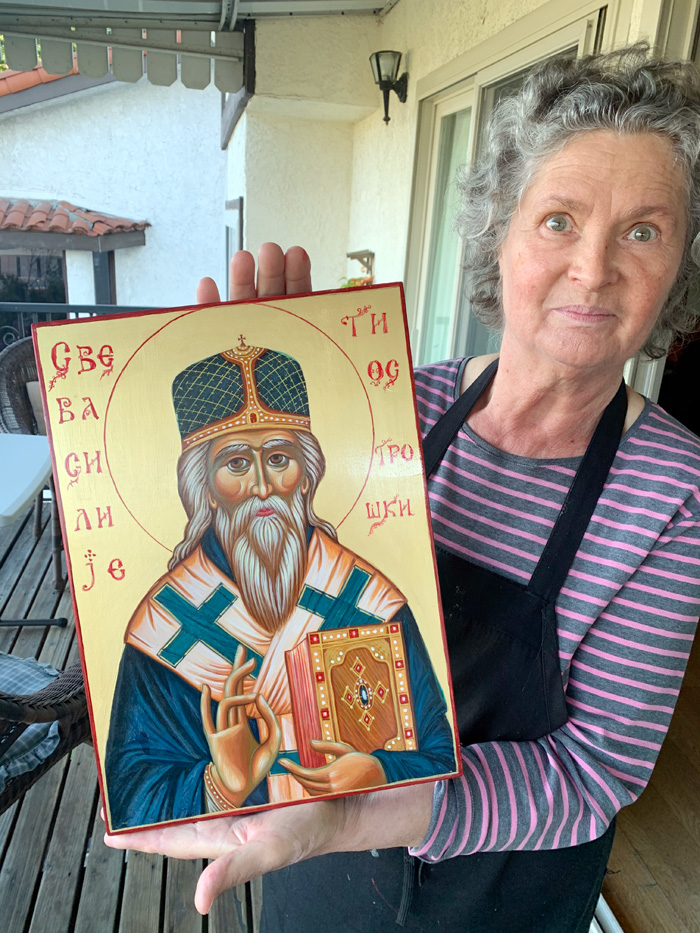
"St Vasilije of Ostrog", detail, egg tempera on board, by Radmila Vasiljevic, 2015
Ship of Salvation, acrylic on canvas, by bp Maxim and Rada Vasiljevic, 2020
Ship of Salvation, acrylic on canvas, by bp Maxim and Rada Vasiljevic, 2020
"Thanksgiving Ship", acrylic on canvas, by bp. Maxim and Radmila Vasiljevic, 2020
St George of San Diego, acrylic on canvas, by Radmila Vasiljevic 2020
St George of San Francisco acrylic on canvas, by bp. Maxim & Radmila Vasiljevic 2020
"Little Daisy", acrylic on canvas, Radmila Vasiljevic, 2020
“Cactus of Elder Ephraim of St. Anthony's”, acrylic on canvas, by Radmila Vasiljevic, 2020
"My Angel is Greeting Me", acrylic on canvas, by bishop Maxim, 2015
"Horses playing", acrylic on canvas, by bp Maxim and Radmila Vasiljevic, 2019
"Alaska Dall Sheep", acrylic on canvas, by Radmila Vasiljevic, 2020
"Uniting a Divided Being", acrylic on canvas, by bishop Maxim, 2020
"Mirjana", acrylic on board, by bishop Maxim, 2019
Abstract expressionism inspired by Modigliani. The plain background offers no distractions and allows us to gaze at the model’s beauty and her serene expressions. Modigliani would not paint the model’s eyes because they were too beautiful and too intimate. Elongated, angular lines and the sculptural tranquility on the sitter’s face allows for the possibility of the grasp of model’s personality through the eyes. The blue color of the empty eyes for this case matches with the blue background color on the right side as if we see the background through the empty eyes. When Modigliani left the eyes empty, it is considered that he then had difficulties in understanding the character of the model. Every model has more characters. For the model having an ambiguous character, he blurred the eyes, or pupils. “I will paint your eyes when I find your soul.” It seems that the model looks at the world while we look into the model’s eyes to get into her thoughts.
St. Marina, egg tempera on board, by Radmila Vasiljevic, 2014
Ship of Salvation, acrylic on canvas, Radmila Vasiljevic, 2020
Jesus Christ, egg tempera on cardboard, by Radmila Vasiljevic, 2017
“Ship of Salvation”, acrylic on canvas, by bishop Maxim and Radmila Vasiljevic, 2020
“Flathead Lake Montana”, acrylic on board, by bp. Maxim and Radmila Vasiljevic, 2020
“He Got off His High Horse”, acrylic on canvas, by Bishop Maxim, 2020
"Big Sky Prairie Summer", acrylic on canvas, Radmila Vasiljevic, 2020
"Summer Pascha in a Skete in the North Star", acrylic on canvas, Radmila Vasiljevic, 2020
The One Crying out in the Wilderness, acrylic on canvas, 2020
Thanksgiving Ship, By Maxim and Radmila V. 2019
"The Boat we are Waiting for", acrylic on canvas, Alhambra, 2019
It is night on the island. We are waiting for the boat. It has been two days. Suddenly, the boat is approaching, coming out of the void, to take us on a voyage.
“She is like summertime sadness”, Alhambra, 2019
Родина-мать, Egg tempera on board, 1999
Jesus Christ, acrylic on board, 2019
"A Young Man Before the Martyrdom", acrylic on cardboard box, 2004
The painting depicts the moment before the martyrdom of a man of noble blood. He is portrayed standing anxiously in modesty and courage. The painter has instilled feeling into his colors, mingling humility with bravery, two naturally contradictory feelings.
The Bride of the Mountain, acrylic on canvas, 2019
"The Boat we are Waiting for", acrylic on canvas, Santa Barbara, 2019
"Lambri", or "How the Orthodox celebrate the Night of the Resurrection", acrylic on canvas, 2019
It is a gladness of soul, a record of the Eucharist's experience, that all these years I thanked my Parish, with all these people of God who came to for the vigil on the Holy Saturday night outside the temple with smiling faces and candles in their hands and celebrating Christ who was THEIR OWN.
Byzantine Expressionism, 2019
Amador County, 2017
Californian Impressionism, 2019
Travel companions with creation. Creation “bends” over our “journeys.” It beautifies and enriches the journey of our life.
"Veiled Discovery", acrylic on carton board, Bishop Maxim, 2018
This acrylic painting on carton paper skillfully captures a moment of intrigue and innocence. The subject, a woman, is partially concealed behind a curtain, revealing only her face and shoulder, creating a sense of mystery. Her expression, a mix of curiosity and surprise, is delicately rendered, highlighting her complex character. The curtain serves as both a secretive veil and a frame for her face, while the carton paper's texture adds a rustic touch to the vivid portrayal. The interplay of light and shadow accentuates her features, adding depth to this captivating composition that eloquently conveys the subject's emotions and the artist's proficiency in acrylics.
Theotokos, egg-tempera on board, by Bishop Maxim, 2018
Acrylic on wooden board, 1999, hierodeacon Maxim
Acrylic on wooden board, 1999, hierodeacon Maxim
Saint Panteleimon, Egg tempera on wood, by Protinica Radmila Vasiljevic
Digital painting, 2017
"Beethoven", acrylic on canvas, by Bishop Maxim, october 2017
This is a surprising "Beethoven". Hair flies from the urge of inspiration. The eyes - the strongest point of the painting - are in ecstasy. The red cow also participates in ecstasy. A book, a keyboard, and a clock - everything floats, terrified by the invisible waves of fate. The presence of a floating clock is important, indicating the connection between the mystery of time and the mystery of music. Beethoven's wide gaze and the semicircular keyboard indicate the comprehensiveness, enormous energy, and great momentum which envelops the drama of existence, from the germ of the Big Bang to the future mystery (Eschaton).
"New Mexico", inspired by Georgia O'Keeffe, Acrylic on canvas, september 2017
"Reading Don Quixote", bp. Maxim, acrylic on canvas 2017
”Alyina Vorobeyeva”, acrylic on canvas, 2017.
"Safari - South Africa" (digital painting made with Adobe Illustrator Draw, iPadPro), June 18, 2017
"Saint Sebastian of San Francisco and Jackson", by Protinica Radmila and Bishop Maxim, 2017
"The Lady Cellist", 2017
"Mother of God", by Protinica Radmila
"Mother of God", detail, by Protinica Radmila
"Fatherhood", July 19, 2016
"Motherhood", July 19, 2016
Painting by protinica Radmila & bp. Maxim, 2016
"Lady in Red", protinica Radmila & bp. Maxim, 2016
The Man from Herzegovina, egg tempera on bord, 1999
The Man from Herzegovina, egg tempera on bord, 1999
"Magic in the Moonlight", acrylic on canvas, 2018
Bathed by the light of the moon. When the beauty of the soul is illuminated by the darkness of pain. The heavens narrate the glory of God, and the poetry of His hands announces the firmament.
"Magic in the Moonlight", acrylic on canvas, 2018
Bathed by the light of the moon. When the beauty of the soul is illuminated by the darkness of pain. The heavens narrate the glory of God, and the poetry of His hands announces the firmament.
Человјек - Дрво Живота, 15. мај 2014.
"Dame in Green", protinica Radmila & bp. Maxim, 2016
"Jesus Christ", acrylic on canvas, by bishop Maxim, 2015
Protinica Rada & bp. Maxim, 2015
American Indian Landscape, 2013.
“Dama Azul”, Acrylic on canvas, Mexico City 2015
Saint Mardarije of Libertyville
"Two homelands", acrylic on canvas, 2014.
Depicting the Old Country and the New World. The Old Country is a place where you or your parents were born but do not now live. Never has it been so vital to understand how issues in the Old or New Country impact our lives, business, and... ART! A great number of Serbs who find themselves for longer or shorter periods of time spread out throughout the world – often departing after difficult deliberation – remain connected to the land of their birth or ancestry, living a 'double consciousness'... This painting somehow points to that phenomenon.
2009.
Saint Sava Cemetery, Los Angeles, 2008 - 2010
Saint Sava Cemetery, Los Angeles, 2008 - 2010
Saint Sava Cemetery, Los Angeles, 2008 - 2010
Saint Sava Cemetery, Los Angeles, 2008 - 2010
Egg tempera on board, 2010
"Pristine Amador County", by Bishop Maxim
The painter approaches this idyllic landscape with reverence, seeing it as a universal symbol and source of inspiration. The landscapes are both real and imagined. The site is orchestrated as a terrain where bison, lake, horses, trees, etc. form a grand rural space in which topography, soils, climate, water, and indigenous vegetation serve the life in Amador County. The author takes his cues from nature, seemingly random patterns occurring in nature without human intervention. To this “informal,” “romantic,” or "picturesque" approach he adds the cemetery suggesting a subtle, human accident.
Theotokos, Mother of God, 2002





!["Twelve Disciples before Their Illumination" [or: "For those who love us and those who hate us"], acrylic on canvas, Bishop Maxim, 2024 "Twelve Disciples before Their Illumination" [or: "For those who love us and those who hate us"], acrylic on canvas, Bishop Maxim, 2024](/images/01/em/0410.jpg)
